Atlantic telegraph company Stock Photos and Images
(405)See atlantic telegraph company stock video clipsQuick filters:
Atlantic telegraph company Stock Photos and Images
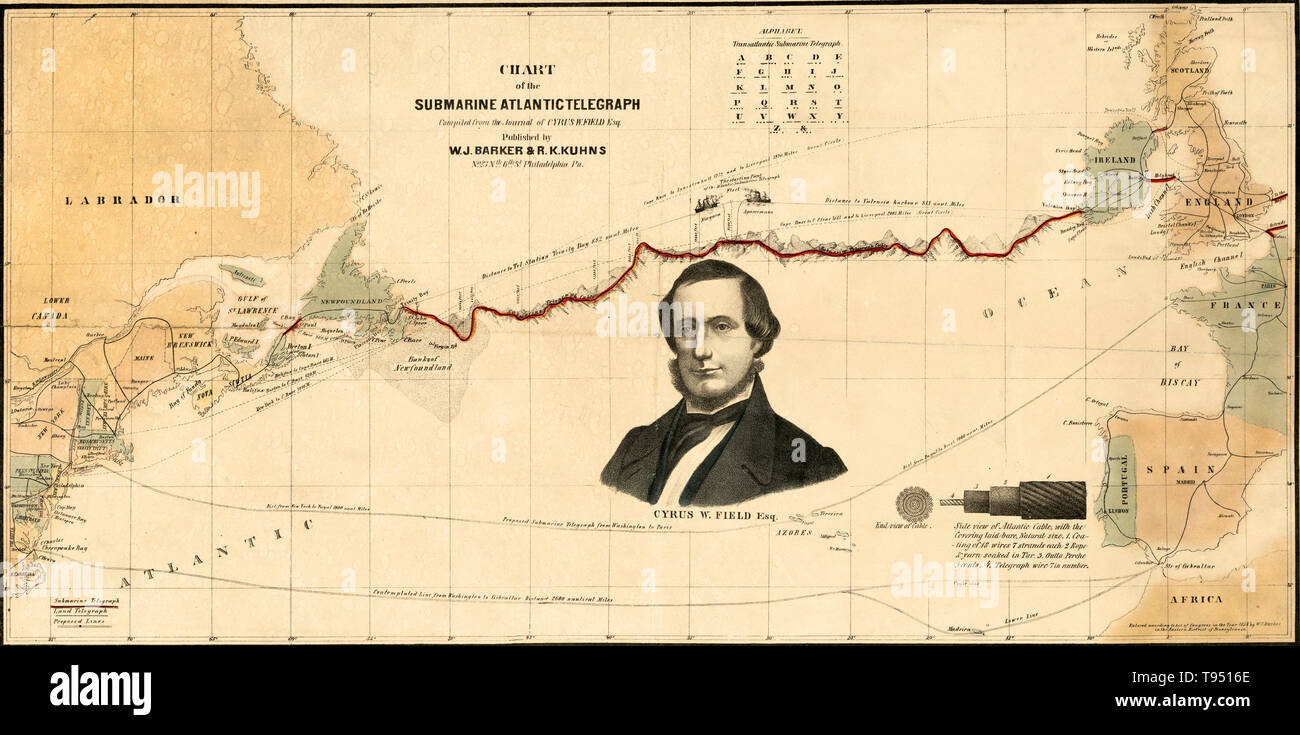 Chart of the path of the first transatlantic telegraph cable, laid in 1858. One of the 19th century's great technological achievements was to lay a telegraphic cable beneath the Atlantic, allowing messages to speed back and forth between North America and Europe in minutes, rather than ten or twelve days by steamer. An initially successful attempt in 1858, led by Cyrus W. Field (portrait on map) and financed by the Atlantic Telegraph Company, failed after three weeks. Stock Photohttps://www.alamy.com/image-license-details/?v=1https://www.alamy.com/chart-of-the-path-of-the-first-transatlantic-telegraph-cable-laid-in-1858-one-of-the-19th-centurys-great-technological-achievements-was-to-lay-a-telegraphic-cable-beneath-the-atlantic-allowing-messages-to-speed-back-and-forth-between-north-america-and-europe-in-minutes-rather-than-ten-or-twelve-days-by-steamer-an-initially-successful-attempt-in-1858-led-by-cyrus-w-field-portrait-on-map-and-financed-by-the-atlantic-telegraph-company-failed-after-three-weeks-image246587782.html
Chart of the path of the first transatlantic telegraph cable, laid in 1858. One of the 19th century's great technological achievements was to lay a telegraphic cable beneath the Atlantic, allowing messages to speed back and forth between North America and Europe in minutes, rather than ten or twelve days by steamer. An initially successful attempt in 1858, led by Cyrus W. Field (portrait on map) and financed by the Atlantic Telegraph Company, failed after three weeks. Stock Photohttps://www.alamy.com/image-license-details/?v=1https://www.alamy.com/chart-of-the-path-of-the-first-transatlantic-telegraph-cable-laid-in-1858-one-of-the-19th-centurys-great-technological-achievements-was-to-lay-a-telegraphic-cable-beneath-the-atlantic-allowing-messages-to-speed-back-and-forth-between-north-america-and-europe-in-minutes-rather-than-ten-or-twelve-days-by-steamer-an-initially-successful-attempt-in-1858-led-by-cyrus-w-field-portrait-on-map-and-financed-by-the-atlantic-telegraph-company-failed-after-three-weeks-image246587782.htmlRMT9516E–Chart of the path of the first transatlantic telegraph cable, laid in 1858. One of the 19th century's great technological achievements was to lay a telegraphic cable beneath the Atlantic, allowing messages to speed back and forth between North America and Europe in minutes, rather than ten or twelve days by steamer. An initially successful attempt in 1858, led by Cyrus W. Field (portrait on map) and financed by the Atlantic Telegraph Company, failed after three weeks.
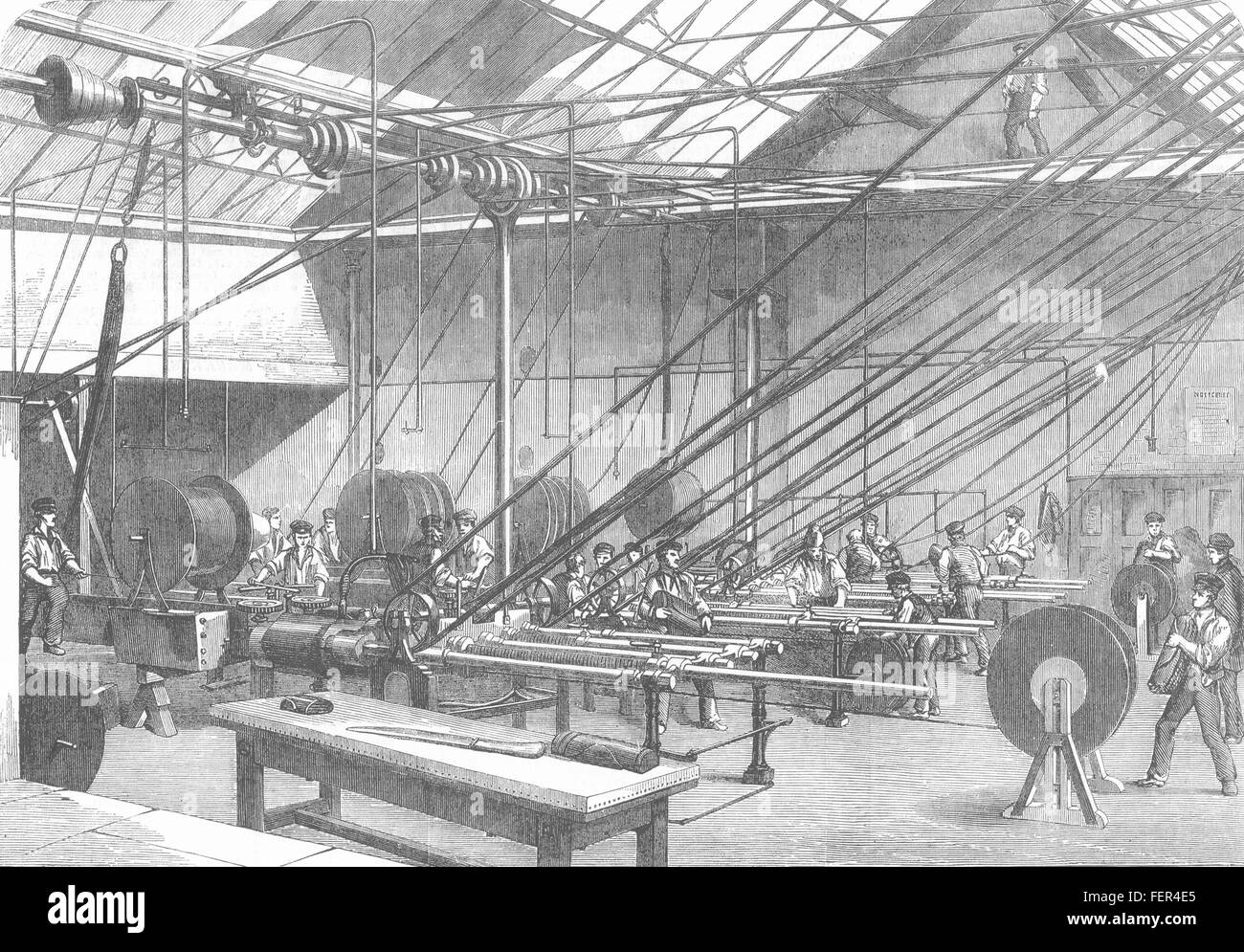 GREENWICH Covering Atlantic Telegraph Cable with gutta percha, Wharf-Road 1857. Illustrated London News Stock Photohttps://www.alamy.com/image-license-details/?v=1https://www.alamy.com/stock-photo-greenwich-covering-atlantic-telegraph-cable-with-gutta-percha-wharf-95165453.html
GREENWICH Covering Atlantic Telegraph Cable with gutta percha, Wharf-Road 1857. Illustrated London News Stock Photohttps://www.alamy.com/image-license-details/?v=1https://www.alamy.com/stock-photo-greenwich-covering-atlantic-telegraph-cable-with-gutta-percha-wharf-95165453.htmlRFFER4E5–GREENWICH Covering Atlantic Telegraph Cable with gutta percha, Wharf-Road 1857. Illustrated London News
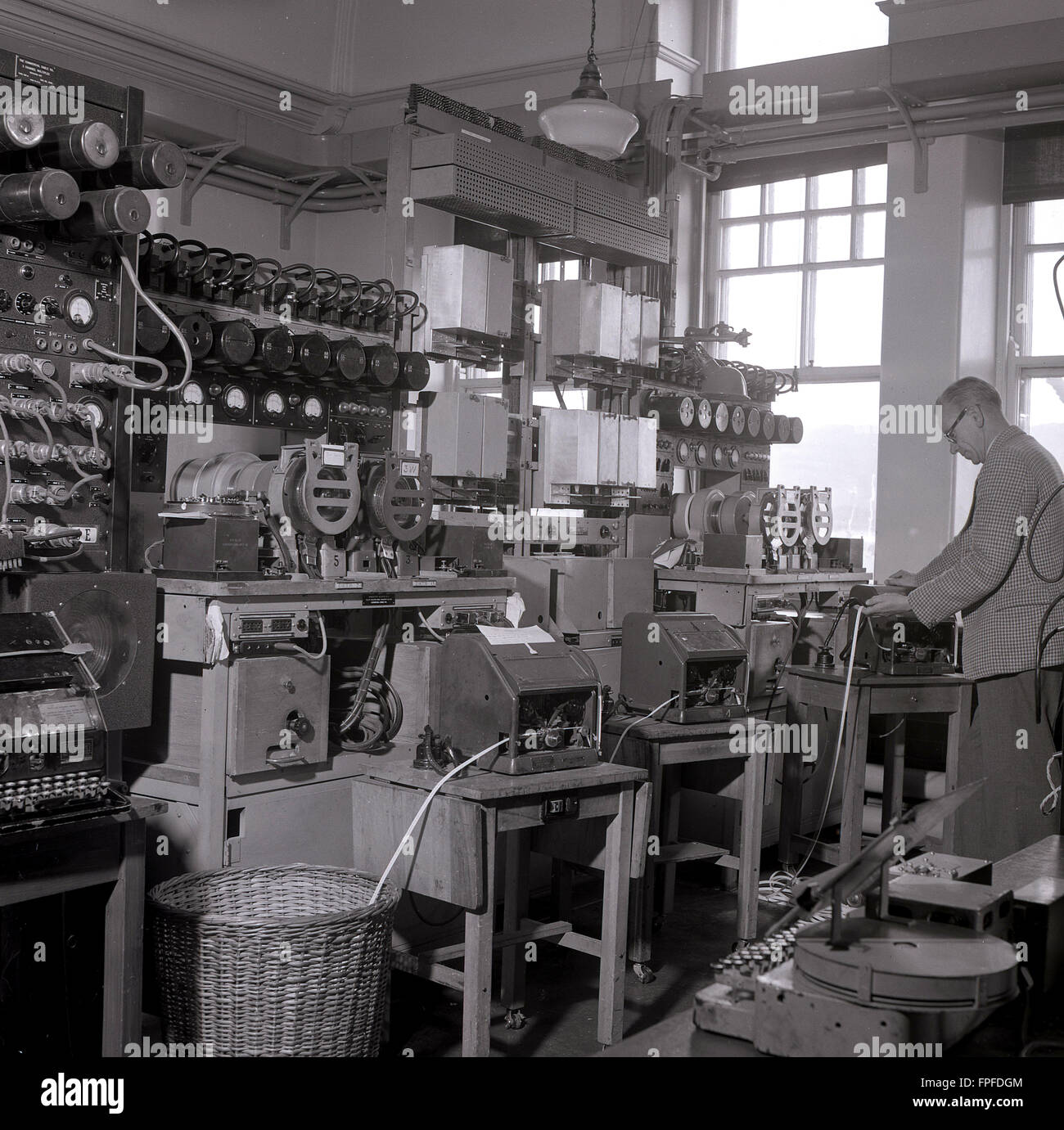 1950s, historical, a male engineer working on the telegraph equipment inside a circuit room at the transatlantic cable station in Waterville, Co. Kerry, Ireland, once home to the one of the largest cable stations in the world. The first successful transatlantic telegraph message was transmitted through Waterville in 1884, after the Commerical Cable Co had laid two cables across the Atlantic ocean connecting Canada, Britain and France, via Waterville, a total of 2,399 miles of cable. Stock Photohttps://www.alamy.com/image-license-details/?v=1https://www.alamy.com/stock-photo-1950s-historical-a-male-engineer-working-on-the-telegraph-equipment-99914212.html
1950s, historical, a male engineer working on the telegraph equipment inside a circuit room at the transatlantic cable station in Waterville, Co. Kerry, Ireland, once home to the one of the largest cable stations in the world. The first successful transatlantic telegraph message was transmitted through Waterville in 1884, after the Commerical Cable Co had laid two cables across the Atlantic ocean connecting Canada, Britain and France, via Waterville, a total of 2,399 miles of cable. Stock Photohttps://www.alamy.com/image-license-details/?v=1https://www.alamy.com/stock-photo-1950s-historical-a-male-engineer-working-on-the-telegraph-equipment-99914212.htmlRMFPFDGM–1950s, historical, a male engineer working on the telegraph equipment inside a circuit room at the transatlantic cable station in Waterville, Co. Kerry, Ireland, once home to the one of the largest cable stations in the world. The first successful transatlantic telegraph message was transmitted through Waterville in 1884, after the Commerical Cable Co had laid two cables across the Atlantic ocean connecting Canada, Britain and France, via Waterville, a total of 2,399 miles of cable.
 Establishing the 'Atlantic Telegraph Company' Stock Photohttps://www.alamy.com/image-license-details/?v=1https://www.alamy.com/stock-photo-establishing-the-atlantic-telegraph-company-36996085.html
Establishing the 'Atlantic Telegraph Company' Stock Photohttps://www.alamy.com/image-license-details/?v=1https://www.alamy.com/stock-photo-establishing-the-atlantic-telegraph-company-36996085.htmlRMC458TN–Establishing the 'Atlantic Telegraph Company'
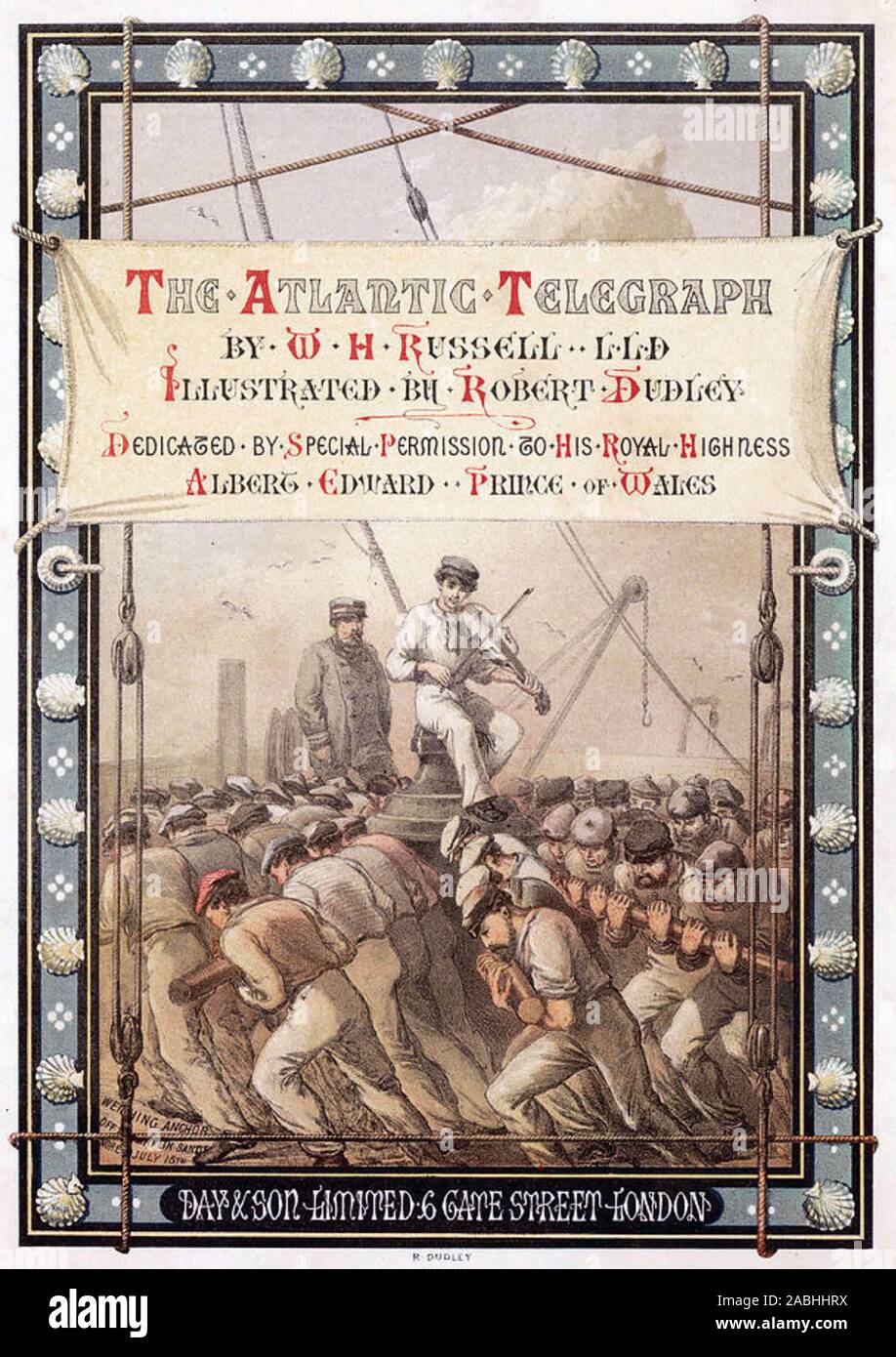 ATLANTIC TELEGRAPH COMPANY The 1865 book celebrating the laying of the commercial telegraph cable across by the Atlantic by the Great Eastern, written by the Times correspondent W.H. Russell Stock Photohttps://www.alamy.com/image-license-details/?v=1https://www.alamy.com/atlantic-telegraph-company-the-1865-book-celebrating-the-laying-of-the-commercial-telegraph-cable-across-by-the-atlantic-by-the-great-eastern-written-by-the-times-correspondent-wh-russell-image334145390.html
ATLANTIC TELEGRAPH COMPANY The 1865 book celebrating the laying of the commercial telegraph cable across by the Atlantic by the Great Eastern, written by the Times correspondent W.H. Russell Stock Photohttps://www.alamy.com/image-license-details/?v=1https://www.alamy.com/atlantic-telegraph-company-the-1865-book-celebrating-the-laying-of-the-commercial-telegraph-cable-across-by-the-atlantic-by-the-great-eastern-written-by-the-times-correspondent-wh-russell-image334145390.htmlRM2ABHHRX–ATLANTIC TELEGRAPH COMPANY The 1865 book celebrating the laying of the commercial telegraph cable across by the Atlantic by the Great Eastern, written by the Times correspondent W.H. Russell
 Cyrus Field - Cyrus West Field (November 30, 1819 – July 12, 1892) was an American businessman and financier who, along with other entrepreneurs, created the Atlantic Telegraph Company and laid the first telegraph cable across the Atlantic Ocean in 1858. Stock Photohttps://www.alamy.com/image-license-details/?v=1https://www.alamy.com/cyrus-field-cyrus-west-field-november-30-1819-july-12-1892-was-an-american-businessman-and-financier-who-along-with-other-entrepreneurs-created-the-atlantic-telegraph-company-and-laid-the-first-telegraph-cable-across-the-atlantic-ocean-in-1858-image378160016.html
Cyrus Field - Cyrus West Field (November 30, 1819 – July 12, 1892) was an American businessman and financier who, along with other entrepreneurs, created the Atlantic Telegraph Company and laid the first telegraph cable across the Atlantic Ocean in 1858. Stock Photohttps://www.alamy.com/image-license-details/?v=1https://www.alamy.com/cyrus-field-cyrus-west-field-november-30-1819-july-12-1892-was-an-american-businessman-and-financier-who-along-with-other-entrepreneurs-created-the-atlantic-telegraph-company-and-laid-the-first-telegraph-cable-across-the-atlantic-ocean-in-1858-image378160016.htmlRM2CY6JXT–Cyrus Field - Cyrus West Field (November 30, 1819 – July 12, 1892) was an American businessman and financier who, along with other entrepreneurs, created the Atlantic Telegraph Company and laid the first telegraph cable across the Atlantic Ocean in 1858.
 Cyrus West Field, 1819 – 1892. American businessman and financier who, along with other entrepreneurs, created the Atlantic Telegraph Company and laid the first telegraph cable across the Atlantic Ocean in 1858. Stock Photohttps://www.alamy.com/image-license-details/?v=1https://www.alamy.com/stock-photo-cyrus-west-field-1819-1892-american-businessman-and-financier-who-83174408.html
Cyrus West Field, 1819 – 1892. American businessman and financier who, along with other entrepreneurs, created the Atlantic Telegraph Company and laid the first telegraph cable across the Atlantic Ocean in 1858. Stock Photohttps://www.alamy.com/image-license-details/?v=1https://www.alamy.com/stock-photo-cyrus-west-field-1819-1892-american-businessman-and-financier-who-83174408.htmlRMER8WPG–Cyrus West Field, 1819 – 1892. American businessman and financier who, along with other entrepreneurs, created the Atlantic Telegraph Company and laid the first telegraph cable across the Atlantic Ocean in 1858.
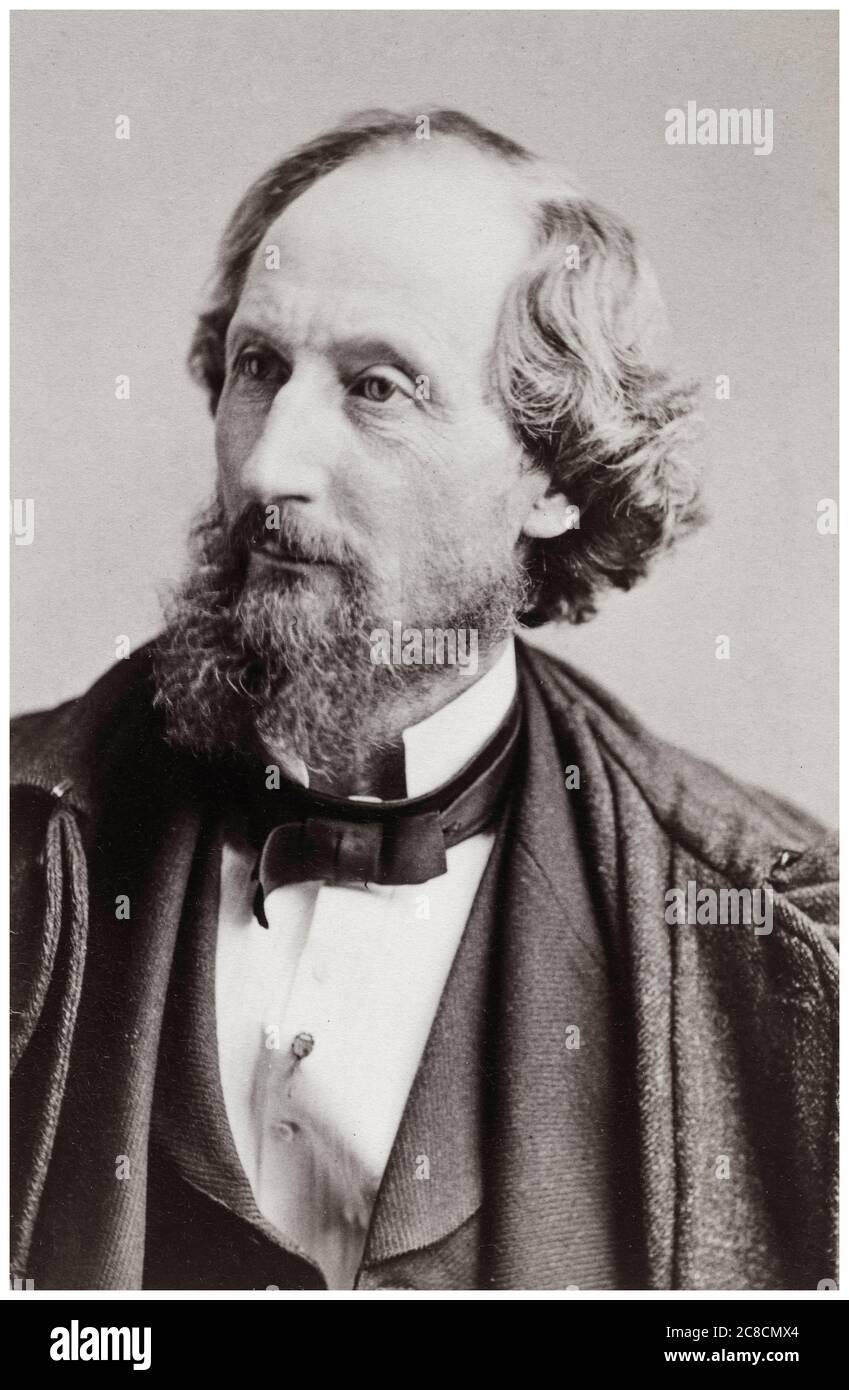 Cyrus West Field (1819-1892), American financier of the Atlantic Telegraph Company who laid the first Transatlantic Telegraph Cable in 1858, portrait photograph, circa 1870 Stock Photohttps://www.alamy.com/image-license-details/?v=1https://www.alamy.com/cyrus-west-field-1819-1892-american-financier-of-the-atlantic-telegraph-company-who-laid-the-first-transatlantic-telegraph-cable-in-1858-portrait-photograph-circa-1870-image366614812.html
Cyrus West Field (1819-1892), American financier of the Atlantic Telegraph Company who laid the first Transatlantic Telegraph Cable in 1858, portrait photograph, circa 1870 Stock Photohttps://www.alamy.com/image-license-details/?v=1https://www.alamy.com/cyrus-west-field-1819-1892-american-financier-of-the-atlantic-telegraph-company-who-laid-the-first-transatlantic-telegraph-cable-in-1858-portrait-photograph-circa-1870-image366614812.htmlRM2C8CMX4–Cyrus West Field (1819-1892), American financier of the Atlantic Telegraph Company who laid the first Transatlantic Telegraph Cable in 1858, portrait photograph, circa 1870
 Cyrus W Field - theman who laid the Atlantic Cable. Cyrus West Field (1819 – 1892) was an American businessman and financier who, along with other entrepreneurs, created the Atlantic Telegraph Company and laid the first telegraph cable across the Atlantic Ocean in 1858. Stock Photohttps://www.alamy.com/image-license-details/?v=1https://www.alamy.com/cyrus-w-field-theman-who-laid-the-atlantic-cable-cyruswestfield1819-1892-was-an-american-businessman-and-financier-who-alongwithother-entrepreneurs-created-the-atlantic-telegraph-company-and-laid-the-first-telegraph-cable-across-the-atlantic-ocean-in-1858-image384216407.html
Cyrus W Field - theman who laid the Atlantic Cable. Cyrus West Field (1819 – 1892) was an American businessman and financier who, along with other entrepreneurs, created the Atlantic Telegraph Company and laid the first telegraph cable across the Atlantic Ocean in 1858. Stock Photohttps://www.alamy.com/image-license-details/?v=1https://www.alamy.com/cyrus-w-field-theman-who-laid-the-atlantic-cable-cyruswestfield1819-1892-was-an-american-businessman-and-financier-who-alongwithother-entrepreneurs-created-the-atlantic-telegraph-company-and-laid-the-first-telegraph-cable-across-the-atlantic-ocean-in-1858-image384216407.htmlRF2D92FXF–Cyrus W Field - theman who laid the Atlantic Cable. Cyrus West Field (1819 – 1892) was an American businessman and financier who, along with other entrepreneurs, created the Atlantic Telegraph Company and laid the first telegraph cable across the Atlantic Ocean in 1858.
 Cyrus West Field was an American businessman and financier who, along with other entrepreneurs, created the Atlantic Telegraph Company and laid the first telegraph cable across the Atlantic Ocean in 1858 - Napoleon Sarony, circa 1870 Stock Photohttps://www.alamy.com/image-license-details/?v=1https://www.alamy.com/cyrus-west-field-was-an-american-businessman-and-financier-who-along-with-other-entrepreneurs-created-the-atlantic-telegraph-company-and-laid-the-first-telegraph-cable-across-the-atlantic-ocean-in-1858-napoleon-sarony-circa-1870-image379585439.html
Cyrus West Field was an American businessman and financier who, along with other entrepreneurs, created the Atlantic Telegraph Company and laid the first telegraph cable across the Atlantic Ocean in 1858 - Napoleon Sarony, circa 1870 Stock Photohttps://www.alamy.com/image-license-details/?v=1https://www.alamy.com/cyrus-west-field-was-an-american-businessman-and-financier-who-along-with-other-entrepreneurs-created-the-atlantic-telegraph-company-and-laid-the-first-telegraph-cable-across-the-atlantic-ocean-in-1858-napoleon-sarony-circa-1870-image379585439.htmlRM2D1FH2R–Cyrus West Field was an American businessman and financier who, along with other entrepreneurs, created the Atlantic Telegraph Company and laid the first telegraph cable across the Atlantic Ocean in 1858 - Napoleon Sarony, circa 1870
 Atlantic Cable Parade, 1858 Stock Photohttps://www.alamy.com/image-license-details/?v=1https://www.alamy.com/atlantic-cable-parade-1858-image352783794.html
Atlantic Cable Parade, 1858 Stock Photohttps://www.alamy.com/image-license-details/?v=1https://www.alamy.com/atlantic-cable-parade-1858-image352783794.htmlRM2BDXK96–Atlantic Cable Parade, 1858
 Mr. Charles T. Bright, chief Engineer of the Atlantic Telegraph Company 1858. The Illustrated London News Stock Photohttps://www.alamy.com/image-license-details/?v=1https://www.alamy.com/stock-image-mr-charles-t-bright-chief-engineer-of-the-atlantic-telegraph-company-165306826.html
Mr. Charles T. Bright, chief Engineer of the Atlantic Telegraph Company 1858. The Illustrated London News Stock Photohttps://www.alamy.com/image-license-details/?v=1https://www.alamy.com/stock-image-mr-charles-t-bright-chief-engineer-of-the-atlantic-telegraph-company-165306826.htmlRFKGXAF6–Mr. Charles T. Bright, chief Engineer of the Atlantic Telegraph Company 1858. The Illustrated London News
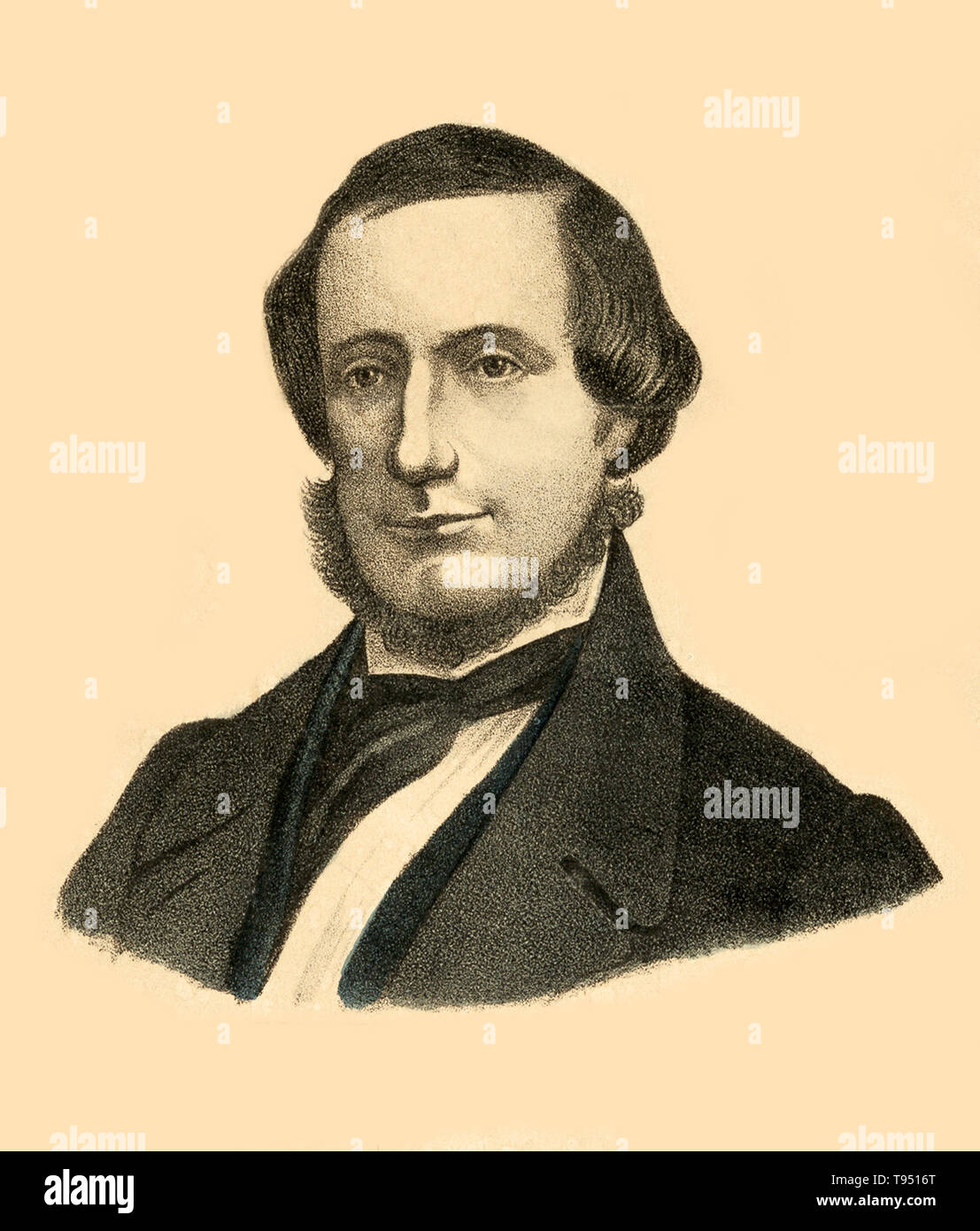 One of the 19th century's great technological achievements was to lay a telegraphic cable beneath the Atlantic, allowing messages to speed back and forth between North America and Europe in minutes, rather than ten or twelve days by steamer. An initially successful attempt in 1858, led by Cyrus W. Field (portrayed here) and financed by the Atlantic Telegraph Company, failed after three weeks. Stock Photohttps://www.alamy.com/image-license-details/?v=1https://www.alamy.com/one-of-the-19th-centurys-great-technological-achievements-was-to-lay-a-telegraphic-cable-beneath-the-atlantic-allowing-messages-to-speed-back-and-forth-between-north-america-and-europe-in-minutes-rather-than-ten-or-twelve-days-by-steamer-an-initially-successful-attempt-in-1858-led-by-cyrus-w-field-portrayed-here-and-financed-by-the-atlantic-telegraph-company-failed-after-three-weeks-image246587792.html
One of the 19th century's great technological achievements was to lay a telegraphic cable beneath the Atlantic, allowing messages to speed back and forth between North America and Europe in minutes, rather than ten or twelve days by steamer. An initially successful attempt in 1858, led by Cyrus W. Field (portrayed here) and financed by the Atlantic Telegraph Company, failed after three weeks. Stock Photohttps://www.alamy.com/image-license-details/?v=1https://www.alamy.com/one-of-the-19th-centurys-great-technological-achievements-was-to-lay-a-telegraphic-cable-beneath-the-atlantic-allowing-messages-to-speed-back-and-forth-between-north-america-and-europe-in-minutes-rather-than-ten-or-twelve-days-by-steamer-an-initially-successful-attempt-in-1858-led-by-cyrus-w-field-portrayed-here-and-financed-by-the-atlantic-telegraph-company-failed-after-three-weeks-image246587792.htmlRMT9516T–One of the 19th century's great technological achievements was to lay a telegraphic cable beneath the Atlantic, allowing messages to speed back and forth between North America and Europe in minutes, rather than ten or twelve days by steamer. An initially successful attempt in 1858, led by Cyrus W. Field (portrayed here) and financed by the Atlantic Telegraph Company, failed after three weeks.
 John Pender (1815-1896), English textile merchant, Liberal politician and pioneer of submarine telegraphy. Director of the first Atlantic Telegraph Company (1856). Cartoon from 'Vanity Fair' (London, 28 October 1871). Chromolithograph. Stock Photohttps://www.alamy.com/image-license-details/?v=1https://www.alamy.com/stock-photo-john-pender-1815-1896-english-textile-merchant-liberal-politician-57292425.html
John Pender (1815-1896), English textile merchant, Liberal politician and pioneer of submarine telegraphy. Director of the first Atlantic Telegraph Company (1856). Cartoon from 'Vanity Fair' (London, 28 October 1871). Chromolithograph. Stock Photohttps://www.alamy.com/image-license-details/?v=1https://www.alamy.com/stock-photo-john-pender-1815-1896-english-textile-merchant-liberal-politician-57292425.htmlRMD95W21–John Pender (1815-1896), English textile merchant, Liberal politician and pioneer of submarine telegraphy. Director of the first Atlantic Telegraph Company (1856). Cartoon from 'Vanity Fair' (London, 28 October 1871). Chromolithograph.
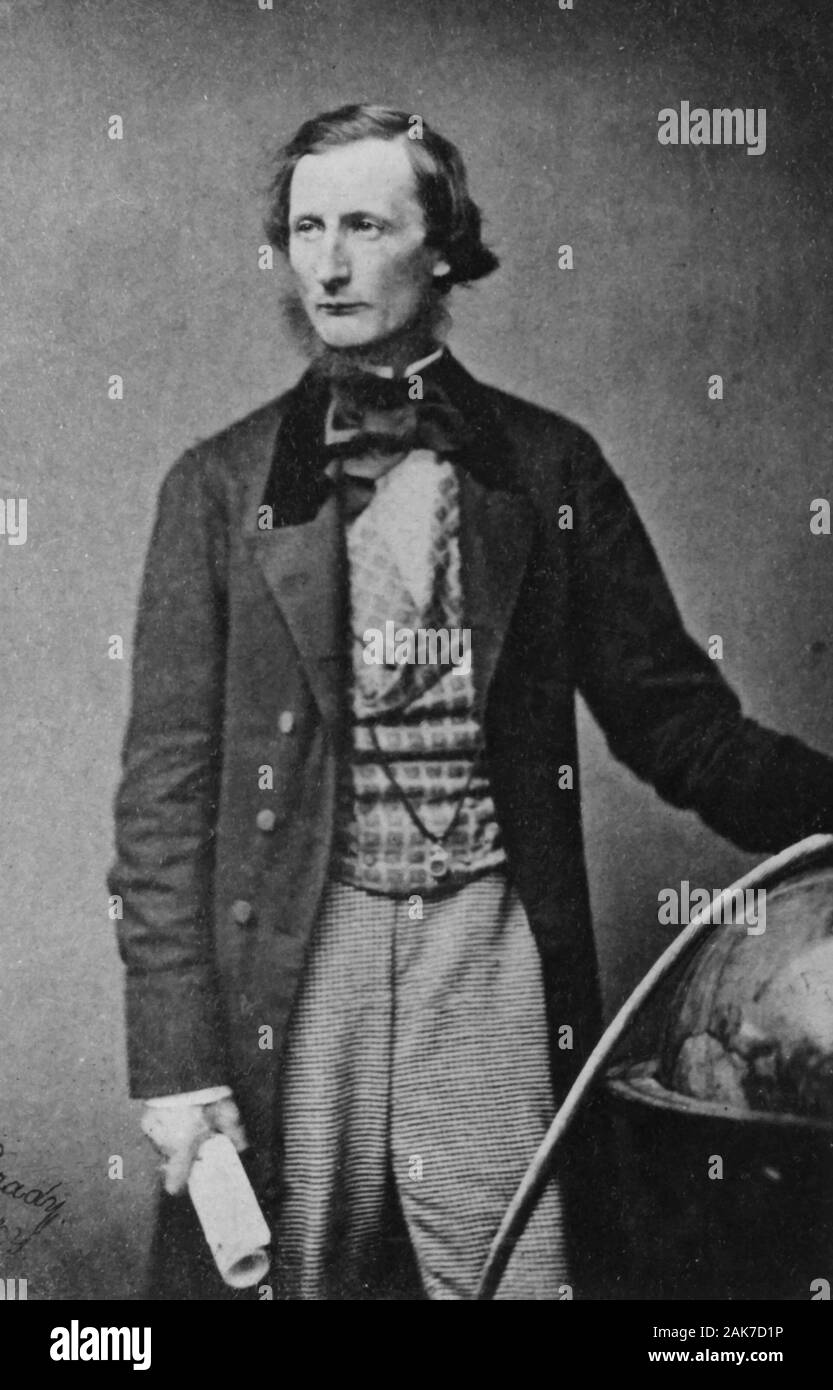 CYRUS WEST FIELD (1819-1892) American businessman and financier Stock Photohttps://www.alamy.com/image-license-details/?v=1https://www.alamy.com/cyrus-west-field-1819-1892-american-businessman-and-financier-image338839362.html
CYRUS WEST FIELD (1819-1892) American businessman and financier Stock Photohttps://www.alamy.com/image-license-details/?v=1https://www.alamy.com/cyrus-west-field-1819-1892-american-businessman-and-financier-image338839362.htmlRM2AK7D1P–CYRUS WEST FIELD (1819-1892) American businessman and financier
 Coiling the Cable in the Large Tanks at the Works of the Telegraph Construction and Maintenance Company of Greenwich, 1865. Artist: Robert Charles Dudley (British, 1826-1909). Dimensions: Sheet: 7 3/16 × 10 1/2 in. (18.2 × 26.6 cm). Date: 1865. One of the 19th century's great technological achievements was to lay a telegraphic cable beneath the Atlantic, allowing messages to speed back and forth between North America and Europe in minutes, rather than ten or twelve days by steamer. An initially successful attempt in 1858, led by Cyrus W. Field and financed by the Atlantic Telegraph Company, f Stock Photohttps://www.alamy.com/image-license-details/?v=1https://www.alamy.com/coiling-the-cable-in-the-large-tanks-at-the-works-of-the-telegraph-construction-and-maintenance-company-of-greenwich-1865-artist-robert-charles-dudley-british-1826-1909-dimensions-sheet-7-316-10-12-in-182-266-cm-date-1865-one-of-the-19th-centurys-great-technological-achievements-was-to-lay-a-telegraphic-cable-beneath-the-atlantic-allowing-messages-to-speed-back-and-forth-between-north-america-and-europe-in-minutes-rather-than-ten-or-twelve-days-by-steamer-an-initially-successful-attempt-in-1858-led-by-cyrus-w-field-and-financed-by-the-atlantic-telegraph-company-f-image213262375.html
Coiling the Cable in the Large Tanks at the Works of the Telegraph Construction and Maintenance Company of Greenwich, 1865. Artist: Robert Charles Dudley (British, 1826-1909). Dimensions: Sheet: 7 3/16 × 10 1/2 in. (18.2 × 26.6 cm). Date: 1865. One of the 19th century's great technological achievements was to lay a telegraphic cable beneath the Atlantic, allowing messages to speed back and forth between North America and Europe in minutes, rather than ten or twelve days by steamer. An initially successful attempt in 1858, led by Cyrus W. Field and financed by the Atlantic Telegraph Company, f Stock Photohttps://www.alamy.com/image-license-details/?v=1https://www.alamy.com/coiling-the-cable-in-the-large-tanks-at-the-works-of-the-telegraph-construction-and-maintenance-company-of-greenwich-1865-artist-robert-charles-dudley-british-1826-1909-dimensions-sheet-7-316-10-12-in-182-266-cm-date-1865-one-of-the-19th-centurys-great-technological-achievements-was-to-lay-a-telegraphic-cable-beneath-the-atlantic-allowing-messages-to-speed-back-and-forth-between-north-america-and-europe-in-minutes-rather-than-ten-or-twelve-days-by-steamer-an-initially-successful-attempt-in-1858-led-by-cyrus-w-field-and-financed-by-the-atlantic-telegraph-company-f-image213262375.htmlRMPAXX9B–Coiling the Cable in the Large Tanks at the Works of the Telegraph Construction and Maintenance Company of Greenwich, 1865. Artist: Robert Charles Dudley (British, 1826-1909). Dimensions: Sheet: 7 3/16 × 10 1/2 in. (18.2 × 26.6 cm). Date: 1865. One of the 19th century's great technological achievements was to lay a telegraphic cable beneath the Atlantic, allowing messages to speed back and forth between North America and Europe in minutes, rather than ten or twelve days by steamer. An initially successful attempt in 1858, led by Cyrus W. Field and financed by the Atlantic Telegraph Company, f
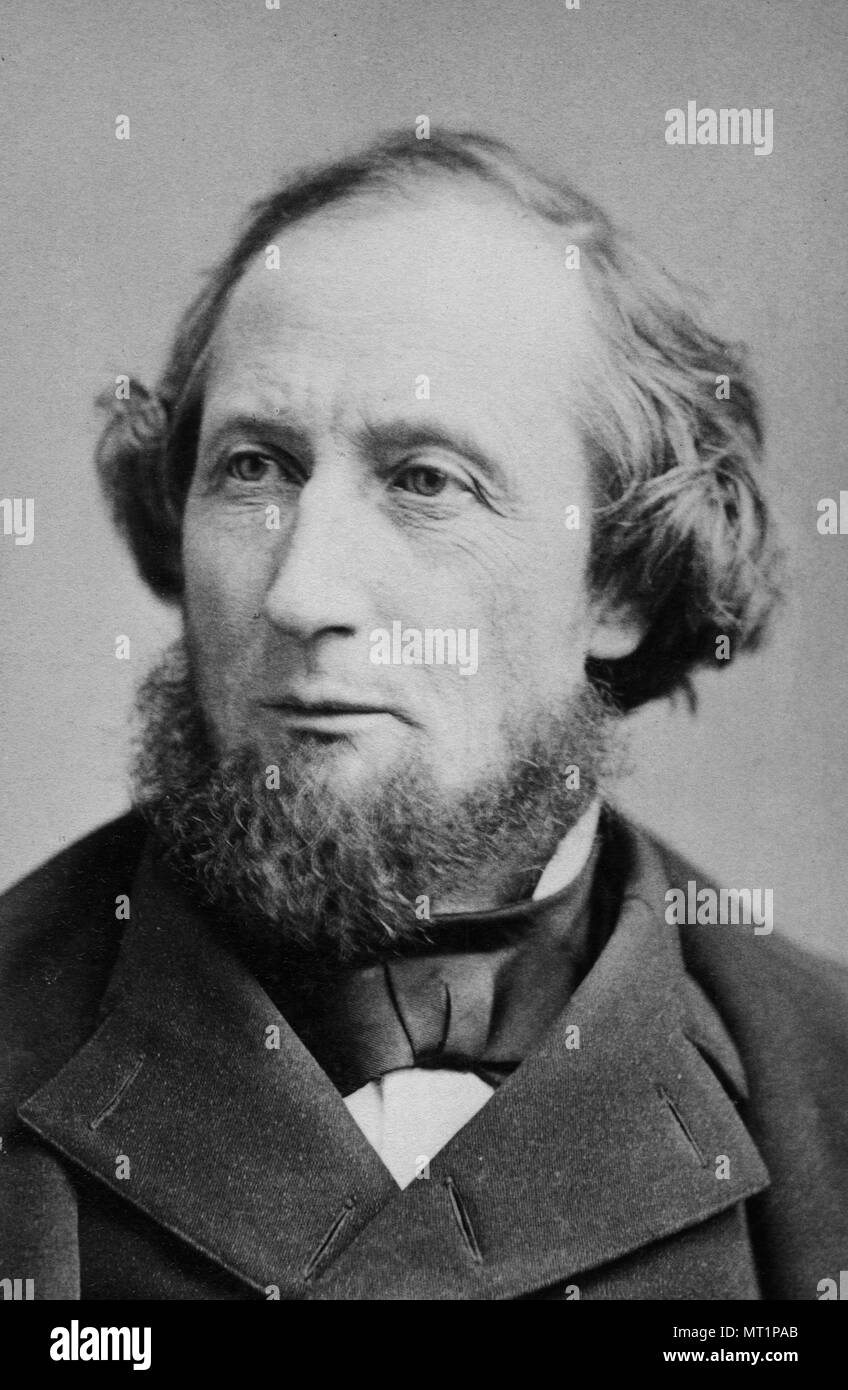 Cyrus West Field (1819 – 1892) American businessman and financier who, along with other entrepreneurs, created the Atlantic Telegraph Company and laid the first telegraph cable across the Atlantic Ocean in 1858. Stock Photohttps://www.alamy.com/image-license-details/?v=1https://www.alamy.com/cyrus-west-field-1819-1892-american-businessman-and-financier-who-along-with-other-entrepreneurs-created-the-atlantic-telegraph-company-and-laid-the-first-telegraph-cable-across-the-atlantic-ocean-in-1858-image186894915.html
Cyrus West Field (1819 – 1892) American businessman and financier who, along with other entrepreneurs, created the Atlantic Telegraph Company and laid the first telegraph cable across the Atlantic Ocean in 1858. Stock Photohttps://www.alamy.com/image-license-details/?v=1https://www.alamy.com/cyrus-west-field-1819-1892-american-businessman-and-financier-who-along-with-other-entrepreneurs-created-the-atlantic-telegraph-company-and-laid-the-first-telegraph-cable-across-the-atlantic-ocean-in-1858-image186894915.htmlRMMT1PAB–Cyrus West Field (1819 – 1892) American businessman and financier who, along with other entrepreneurs, created the Atlantic Telegraph Company and laid the first telegraph cable across the Atlantic Ocean in 1858.
 Antique 1858 engraving, portrait of Cyrus West Field with facsimile autograph. Cyrus West Field (1819-1892) was an American businessman and financier who, along with other entrepreneurs, created the Atlantic Telegraph Company and laid the first telegraph cable across the Atlantic Ocean in 1858. Stock Photohttps://www.alamy.com/image-license-details/?v=1https://www.alamy.com/stock-photo-antique-1858-engraving-portrait-of-cyrus-west-field-with-facsimile-86692845.html
Antique 1858 engraving, portrait of Cyrus West Field with facsimile autograph. Cyrus West Field (1819-1892) was an American businessman and financier who, along with other entrepreneurs, created the Atlantic Telegraph Company and laid the first telegraph cable across the Atlantic Ocean in 1858. Stock Photohttps://www.alamy.com/image-license-details/?v=1https://www.alamy.com/stock-photo-antique-1858-engraving-portrait-of-cyrus-west-field-with-facsimile-86692845.htmlRMF115H1–Antique 1858 engraving, portrait of Cyrus West Field with facsimile autograph. Cyrus West Field (1819-1892) was an American businessman and financier who, along with other entrepreneurs, created the Atlantic Telegraph Company and laid the first telegraph cable across the Atlantic Ocean in 1858.
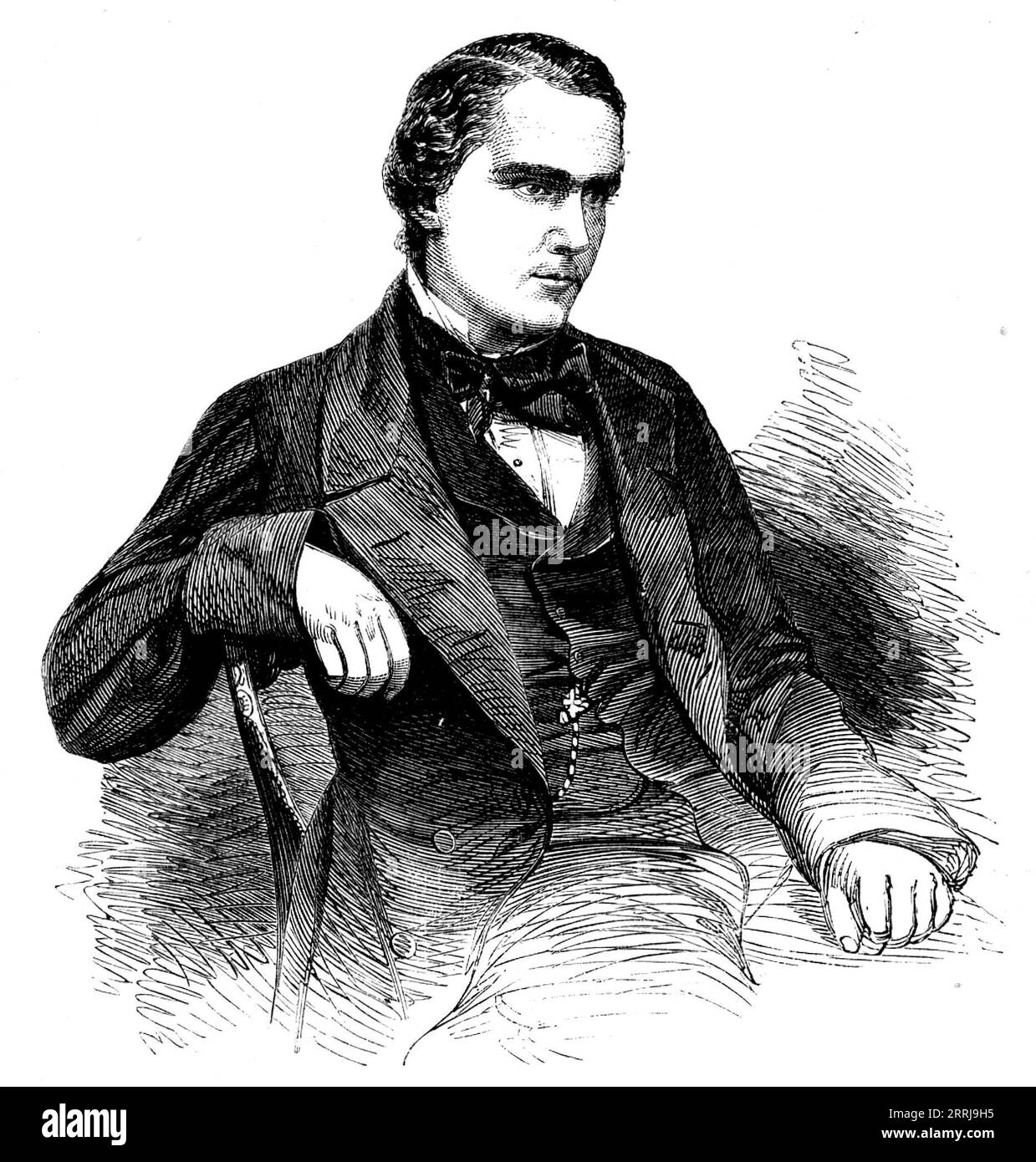 Mr. Charles T. Bright, Chief Engineer of the Atlantic Telegraph Company, 1858. 'This gentleman, the chief engineer of the Atlantic Telegraph Company, and under whose superintendence the extraordinary feat of laying the Atlantic cable between Ireland and Newfoundland has just been accomplished, has long been one of the foremost of the small band of scientific men to whom we are indebted for the grand system of telegraphic communication which now ramifies throughout the civilised world. Mr. Bright has been connected with the telegraphs of this country for a long time, and, as engineer of the Mag Stock Photohttps://www.alamy.com/image-license-details/?v=1https://www.alamy.com/mr-charles-t-bright-chief-engineer-of-the-atlantic-telegraph-company-1858-this-gentleman-the-chief-engineer-of-the-atlantic-telegraph-company-and-under-whose-superintendence-the-extraordinary-feat-of-laying-the-atlantic-cable-between-ireland-and-newfoundland-has-just-been-accomplished-has-long-been-one-of-the-foremost-of-the-small-band-of-scientific-men-to-whom-we-are-indebted-for-the-grand-system-of-telegraphic-communication-which-now-ramifies-throughout-the-civilised-world-mr-bright-has-been-connected-with-the-telegraphs-of-this-country-for-a-long-time-and-as-engineer-of-the-mag-image565271537.html
Mr. Charles T. Bright, Chief Engineer of the Atlantic Telegraph Company, 1858. 'This gentleman, the chief engineer of the Atlantic Telegraph Company, and under whose superintendence the extraordinary feat of laying the Atlantic cable between Ireland and Newfoundland has just been accomplished, has long been one of the foremost of the small band of scientific men to whom we are indebted for the grand system of telegraphic communication which now ramifies throughout the civilised world. Mr. Bright has been connected with the telegraphs of this country for a long time, and, as engineer of the Mag Stock Photohttps://www.alamy.com/image-license-details/?v=1https://www.alamy.com/mr-charles-t-bright-chief-engineer-of-the-atlantic-telegraph-company-1858-this-gentleman-the-chief-engineer-of-the-atlantic-telegraph-company-and-under-whose-superintendence-the-extraordinary-feat-of-laying-the-atlantic-cable-between-ireland-and-newfoundland-has-just-been-accomplished-has-long-been-one-of-the-foremost-of-the-small-band-of-scientific-men-to-whom-we-are-indebted-for-the-grand-system-of-telegraphic-communication-which-now-ramifies-throughout-the-civilised-world-mr-bright-has-been-connected-with-the-telegraphs-of-this-country-for-a-long-time-and-as-engineer-of-the-mag-image565271537.htmlRM2RRJ9H5–Mr. Charles T. Bright, Chief Engineer of the Atlantic Telegraph Company, 1858. 'This gentleman, the chief engineer of the Atlantic Telegraph Company, and under whose superintendence the extraordinary feat of laying the Atlantic cable between Ireland and Newfoundland has just been accomplished, has long been one of the foremost of the small band of scientific men to whom we are indebted for the grand system of telegraphic communication which now ramifies throughout the civilised world. Mr. Bright has been connected with the telegraphs of this country for a long time, and, as engineer of the Mag
 Manufacture of the Atlantic telegraph cable 1857 Stock Photohttps://www.alamy.com/image-license-details/?v=1https://www.alamy.com/manufacture-of-the-atlantic-telegraph-cable-1857-image501358565.html
Manufacture of the Atlantic telegraph cable 1857 Stock Photohttps://www.alamy.com/image-license-details/?v=1https://www.alamy.com/manufacture-of-the-atlantic-telegraph-cable-1857-image501358565.htmlRM2M3JRY1–Manufacture of the Atlantic telegraph cable 1857
![The Atlantic Telegraph [1866] Sir William Howard Russell Irish This book documents the great 19th century technological achievement of laying a telegraphic cable beneath the Atlantic to allow messages to speed back and forth between North America and Europe in minutes, rather than the ten or twelve days it took to cross the ocean by steamer. Led by Cyrus W. Field and financed by the Atlantic Telegraph Company, an initially successful attempt in 1858 failed after three weeks. Repeated efforts by Field, a cadre of engineers, technicians, and sailors, backed by two groups of investors with help f Stock Photo The Atlantic Telegraph [1866] Sir William Howard Russell Irish This book documents the great 19th century technological achievement of laying a telegraphic cable beneath the Atlantic to allow messages to speed back and forth between North America and Europe in minutes, rather than the ten or twelve days it took to cross the ocean by steamer. Led by Cyrus W. Field and financed by the Atlantic Telegraph Company, an initially successful attempt in 1858 failed after three weeks. Repeated efforts by Field, a cadre of engineers, technicians, and sailors, backed by two groups of investors with help f Stock Photo](https://c8.alamy.com/comp/2HHAD0G/the-atlantic-telegraph-1866-sir-william-howard-russell-irish-this-book-documents-the-great-19th-century-technological-achievement-of-laying-a-telegraphic-cable-beneath-the-atlantic-to-allow-messages-to-speed-back-and-forth-between-north-america-and-europe-in-minutes-rather-than-the-ten-or-twelve-days-it-took-to-cross-the-ocean-by-steamer-led-by-cyrus-w-field-and-financed-by-the-atlantic-telegraph-company-an-initially-successful-attempt-in-1858-failed-after-three-weeks-repeated-efforts-by-field-a-cadre-of-engineers-technicians-and-sailors-backed-by-two-groups-of-investors-with-help-f-2HHAD0G.jpg) The Atlantic Telegraph [1866] Sir William Howard Russell Irish This book documents the great 19th century technological achievement of laying a telegraphic cable beneath the Atlantic to allow messages to speed back and forth between North America and Europe in minutes, rather than the ten or twelve days it took to cross the ocean by steamer. Led by Cyrus W. Field and financed by the Atlantic Telegraph Company, an initially successful attempt in 1858 failed after three weeks. Repeated efforts by Field, a cadre of engineers, technicians, and sailors, backed by two groups of investors with help f Stock Photohttps://www.alamy.com/image-license-details/?v=1https://www.alamy.com/the-atlantic-telegraph-1866-sir-william-howard-russell-irish-this-book-documents-the-great-19th-century-technological-achievement-of-laying-a-telegraphic-cable-beneath-the-atlantic-to-allow-messages-to-speed-back-and-forth-between-north-america-and-europe-in-minutes-rather-than-the-ten-or-twelve-days-it-took-to-cross-the-ocean-by-steamer-led-by-cyrus-w-field-and-financed-by-the-atlantic-telegraph-company-an-initially-successful-attempt-in-1858-failed-after-three-weeks-repeated-efforts-by-field-a-cadre-of-engineers-technicians-and-sailors-backed-by-two-groups-of-investors-with-help-f-image458148448.html
The Atlantic Telegraph [1866] Sir William Howard Russell Irish This book documents the great 19th century technological achievement of laying a telegraphic cable beneath the Atlantic to allow messages to speed back and forth between North America and Europe in minutes, rather than the ten or twelve days it took to cross the ocean by steamer. Led by Cyrus W. Field and financed by the Atlantic Telegraph Company, an initially successful attempt in 1858 failed after three weeks. Repeated efforts by Field, a cadre of engineers, technicians, and sailors, backed by two groups of investors with help f Stock Photohttps://www.alamy.com/image-license-details/?v=1https://www.alamy.com/the-atlantic-telegraph-1866-sir-william-howard-russell-irish-this-book-documents-the-great-19th-century-technological-achievement-of-laying-a-telegraphic-cable-beneath-the-atlantic-to-allow-messages-to-speed-back-and-forth-between-north-america-and-europe-in-minutes-rather-than-the-ten-or-twelve-days-it-took-to-cross-the-ocean-by-steamer-led-by-cyrus-w-field-and-financed-by-the-atlantic-telegraph-company-an-initially-successful-attempt-in-1858-failed-after-three-weeks-repeated-efforts-by-field-a-cadre-of-engineers-technicians-and-sailors-backed-by-two-groups-of-investors-with-help-f-image458148448.htmlRM2HHAD0G–The Atlantic Telegraph [1866] Sir William Howard Russell Irish This book documents the great 19th century technological achievement of laying a telegraphic cable beneath the Atlantic to allow messages to speed back and forth between North America and Europe in minutes, rather than the ten or twelve days it took to cross the ocean by steamer. Led by Cyrus W. Field and financed by the Atlantic Telegraph Company, an initially successful attempt in 1858 failed after three weeks. Repeated efforts by Field, a cadre of engineers, technicians, and sailors, backed by two groups of investors with help f
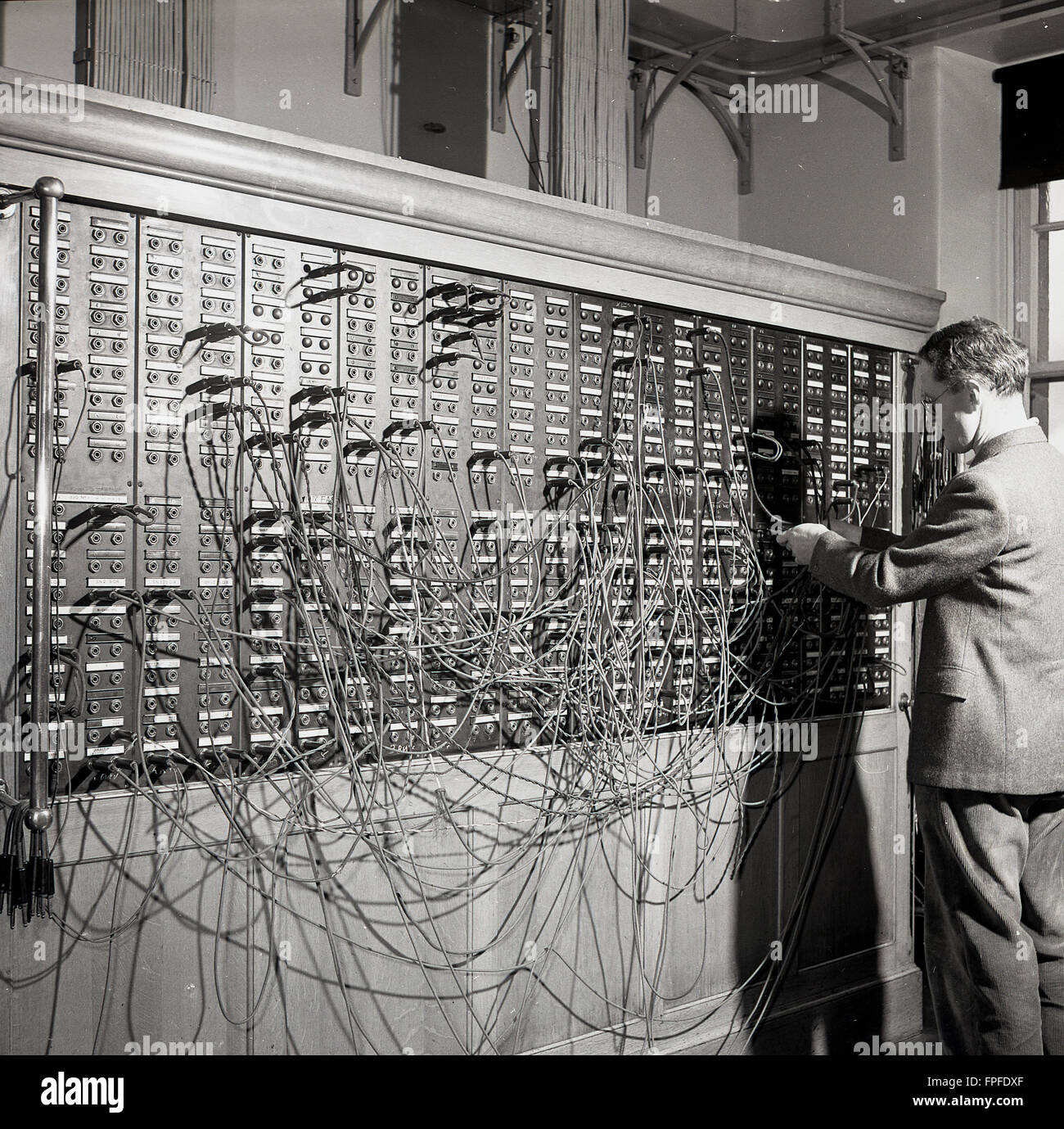 1950s, historical, a male operator in a suit switching telephone cables on a switchboard at the transatlantic cable station in Waterville, Co. Kerry, Ireland. The remote village of Waterville, was once home to the one of the largest cable stations in the world and the first successful transatlantic telegraph message passed via the cable in 1884. That year the Commerical Cable Co had laid two cables across the Atlantic ocean connecting Canada, Britain and France, via the Waterville station, a total of 2,399 miles of cable. Stock Photohttps://www.alamy.com/image-license-details/?v=1https://www.alamy.com/stock-photo-1950s-historical-a-male-operator-in-a-suit-switching-telephone-cables-99914487.html
1950s, historical, a male operator in a suit switching telephone cables on a switchboard at the transatlantic cable station in Waterville, Co. Kerry, Ireland. The remote village of Waterville, was once home to the one of the largest cable stations in the world and the first successful transatlantic telegraph message passed via the cable in 1884. That year the Commerical Cable Co had laid two cables across the Atlantic ocean connecting Canada, Britain and France, via the Waterville station, a total of 2,399 miles of cable. Stock Photohttps://www.alamy.com/image-license-details/?v=1https://www.alamy.com/stock-photo-1950s-historical-a-male-operator-in-a-suit-switching-telephone-cables-99914487.htmlRMFPFDXF–1950s, historical, a male operator in a suit switching telephone cables on a switchboard at the transatlantic cable station in Waterville, Co. Kerry, Ireland. The remote village of Waterville, was once home to the one of the largest cable stations in the world and the first successful transatlantic telegraph message passed via the cable in 1884. That year the Commerical Cable Co had laid two cables across the Atlantic ocean connecting Canada, Britain and France, via the Waterville station, a total of 2,399 miles of cable.
 Telegraph company, St Vincent Island, Cape Verde Islands Stock Photohttps://www.alamy.com/image-license-details/?v=1https://www.alamy.com/telegraph-company-st-vincent-island-cape-verde-islands-image183037348.html
Telegraph company, St Vincent Island, Cape Verde Islands Stock Photohttps://www.alamy.com/image-license-details/?v=1https://www.alamy.com/telegraph-company-st-vincent-island-cape-verde-islands-image183037348.htmlRMMHP204–Telegraph company, St Vincent Island, Cape Verde Islands
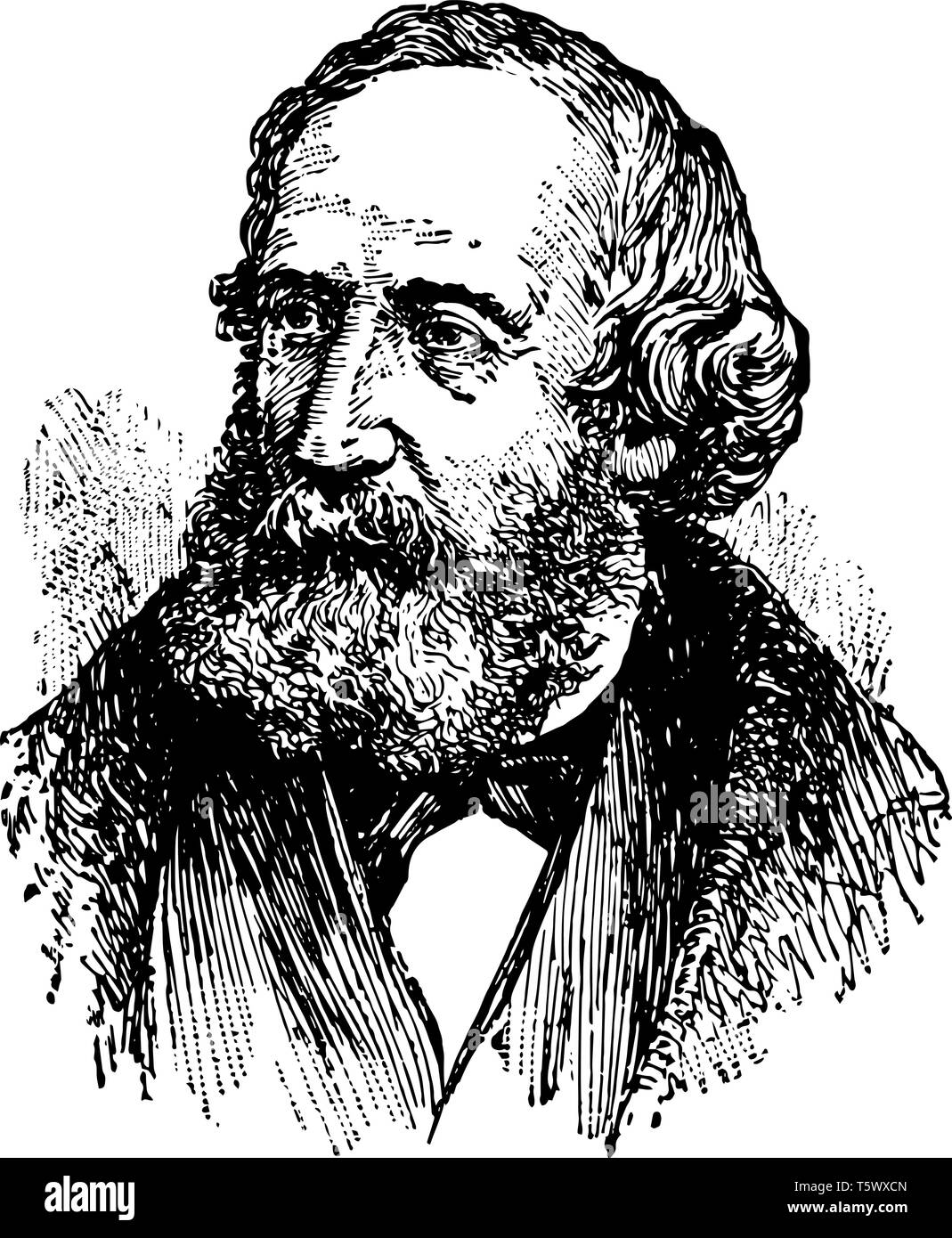 Cyrus West Field 1819 to 1892 he was an American businessman and financier who helped to create the Atlantic Telegraph Company and laid the first tele Stock Vectorhttps://www.alamy.com/image-license-details/?v=1https://www.alamy.com/cyrus-west-field-1819-to-1892-he-was-an-american-businessman-and-financier-who-helped-to-create-the-atlantic-telegraph-company-and-laid-the-first-tele-image244587973.html
Cyrus West Field 1819 to 1892 he was an American businessman and financier who helped to create the Atlantic Telegraph Company and laid the first tele Stock Vectorhttps://www.alamy.com/image-license-details/?v=1https://www.alamy.com/cyrus-west-field-1819-to-1892-he-was-an-american-businessman-and-financier-who-helped-to-create-the-atlantic-telegraph-company-and-laid-the-first-tele-image244587973.htmlRFT5WXCN–Cyrus West Field 1819 to 1892 he was an American businessman and financier who helped to create the Atlantic Telegraph Company and laid the first tele
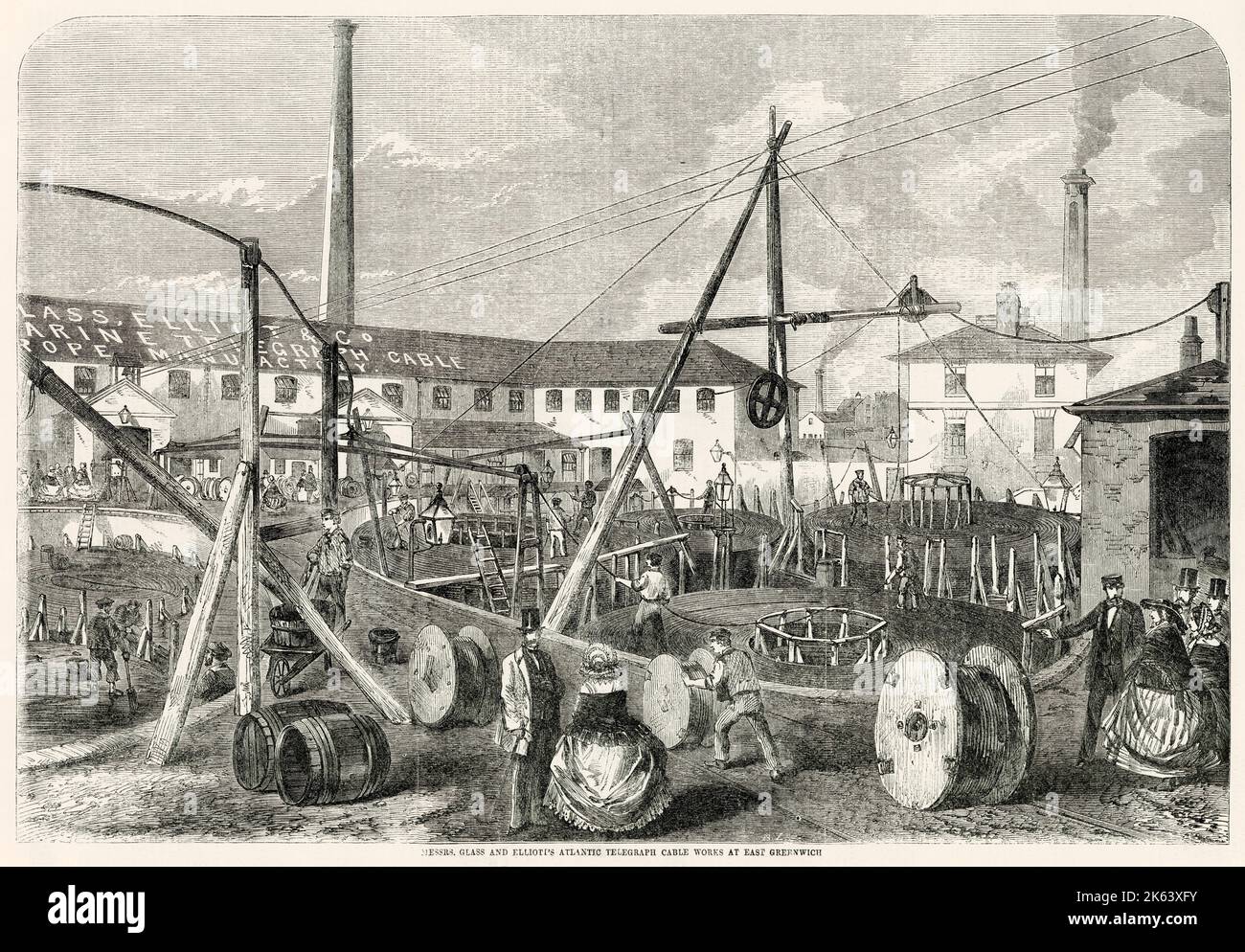 Messrs Glasse and Elliott's Atlantic Telegraph Cable Works yard at East Greenwich, London. The 1,250 tons of telegraphic cable being laid out in five coils to go on-board the H.M.S. 'Agamemnon' ship. Stock Photohttps://www.alamy.com/image-license-details/?v=1https://www.alamy.com/messrs-glasse-and-elliotts-atlantic-telegraph-cable-works-yard-at-east-greenwich-london-the-1250-tons-of-telegraphic-cable-being-laid-out-in-five-coils-to-go-on-board-the-hms-agamemnon-ship-image485664927.html
Messrs Glasse and Elliott's Atlantic Telegraph Cable Works yard at East Greenwich, London. The 1,250 tons of telegraphic cable being laid out in five coils to go on-board the H.M.S. 'Agamemnon' ship. Stock Photohttps://www.alamy.com/image-license-details/?v=1https://www.alamy.com/messrs-glasse-and-elliotts-atlantic-telegraph-cable-works-yard-at-east-greenwich-london-the-1250-tons-of-telegraphic-cable-being-laid-out-in-five-coils-to-go-on-board-the-hms-agamemnon-ship-image485664927.htmlRM2K63XFY–Messrs Glasse and Elliott's Atlantic Telegraph Cable Works yard at East Greenwich, London. The 1,250 tons of telegraphic cable being laid out in five coils to go on-board the H.M.S. 'Agamemnon' ship.
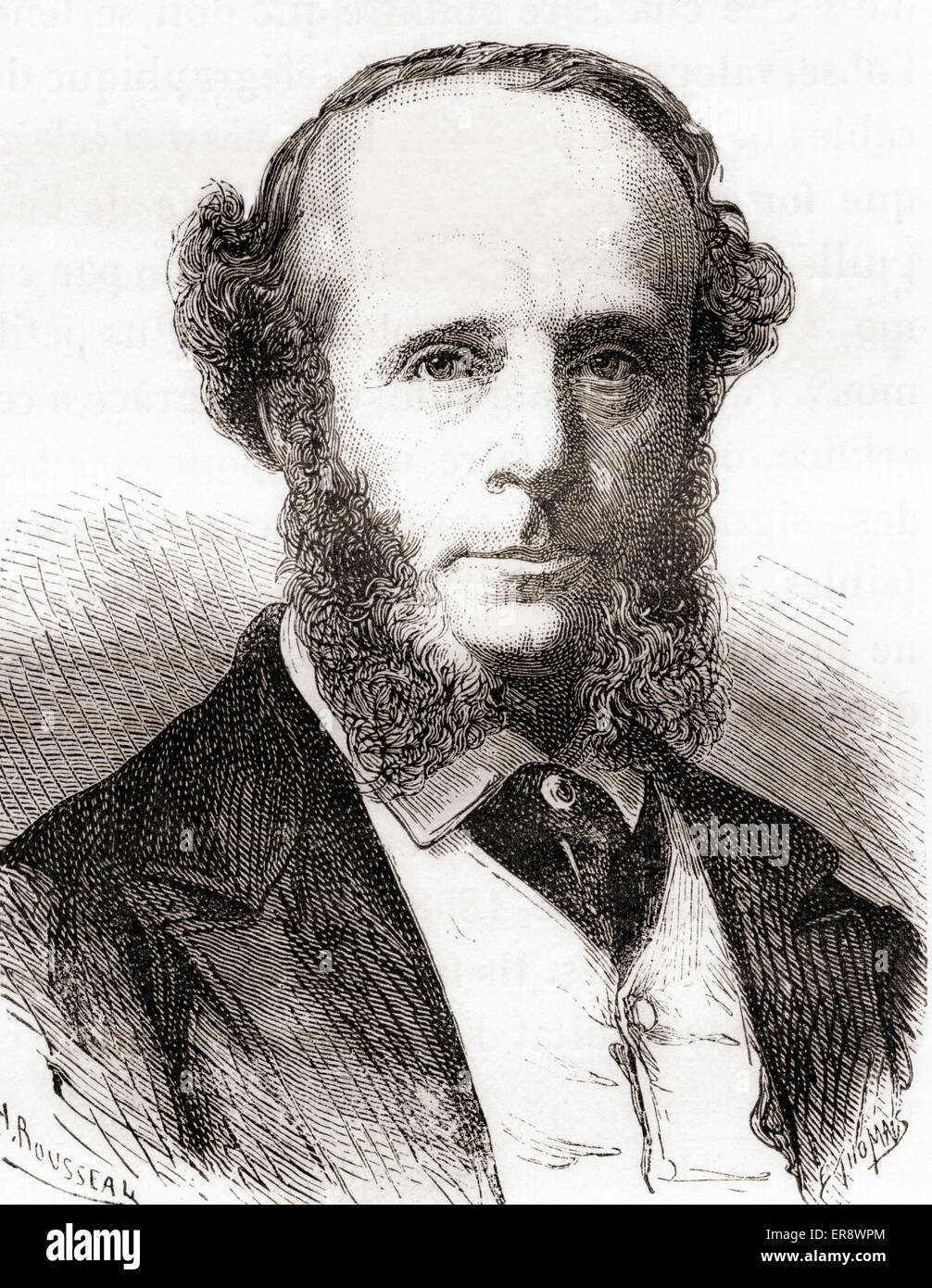 Edward Orange Wildman Whitehouse, 1816 – 1890. English surgeon and chief electrician of the transatlantic telegraph cable for the Atlantic Telegraph Company. Stock Photohttps://www.alamy.com/image-license-details/?v=1https://www.alamy.com/stock-photo-edward-orange-wildman-whitehouse-1816-1890-english-surgeon-and-chief-83174412.html
Edward Orange Wildman Whitehouse, 1816 – 1890. English surgeon and chief electrician of the transatlantic telegraph cable for the Atlantic Telegraph Company. Stock Photohttps://www.alamy.com/image-license-details/?v=1https://www.alamy.com/stock-photo-edward-orange-wildman-whitehouse-1816-1890-english-surgeon-and-chief-83174412.htmlRMER8WPM–Edward Orange Wildman Whitehouse, 1816 – 1890. English surgeon and chief electrician of the transatlantic telegraph cable for the Atlantic Telegraph Company.
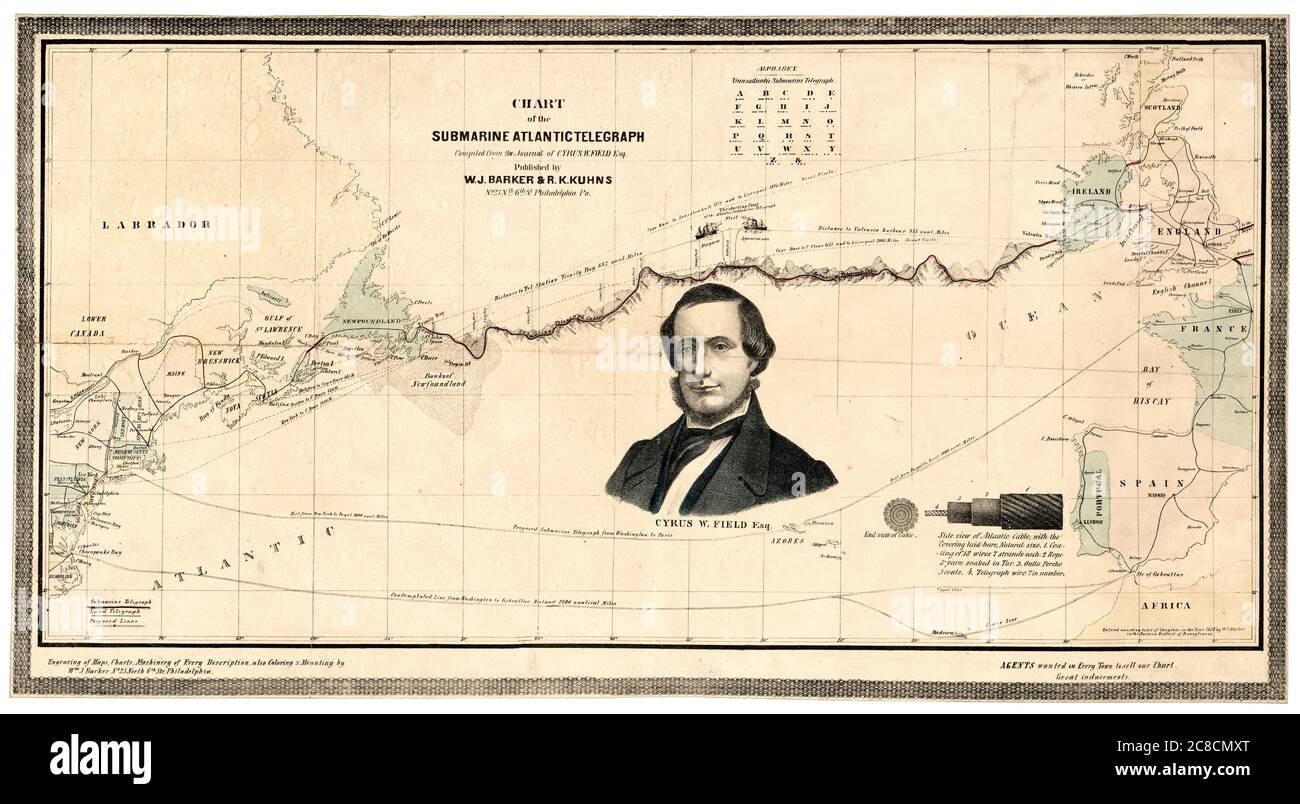 Map and vintage infographic showing the route of the first submarine Transatlantic Telegraph Cable across the Atlantic Ocean and a portrait of Cyrus West Field (1819-1892) of the Atlantic Telegraph Company, map by William J Barker, 1858 Stock Photohttps://www.alamy.com/image-license-details/?v=1https://www.alamy.com/map-and-vintage-infographic-showing-the-route-of-the-first-submarine-transatlantic-telegraph-cable-across-the-atlantic-ocean-and-a-portrait-of-cyrus-west-field-1819-1892-of-the-atlantic-telegraph-company-map-by-william-j-barker-1858-image366614832.html
Map and vintage infographic showing the route of the first submarine Transatlantic Telegraph Cable across the Atlantic Ocean and a portrait of Cyrus West Field (1819-1892) of the Atlantic Telegraph Company, map by William J Barker, 1858 Stock Photohttps://www.alamy.com/image-license-details/?v=1https://www.alamy.com/map-and-vintage-infographic-showing-the-route-of-the-first-submarine-transatlantic-telegraph-cable-across-the-atlantic-ocean-and-a-portrait-of-cyrus-west-field-1819-1892-of-the-atlantic-telegraph-company-map-by-william-j-barker-1858-image366614832.htmlRM2C8CMXT–Map and vintage infographic showing the route of the first submarine Transatlantic Telegraph Cable across the Atlantic Ocean and a portrait of Cyrus West Field (1819-1892) of the Atlantic Telegraph Company, map by William J Barker, 1858
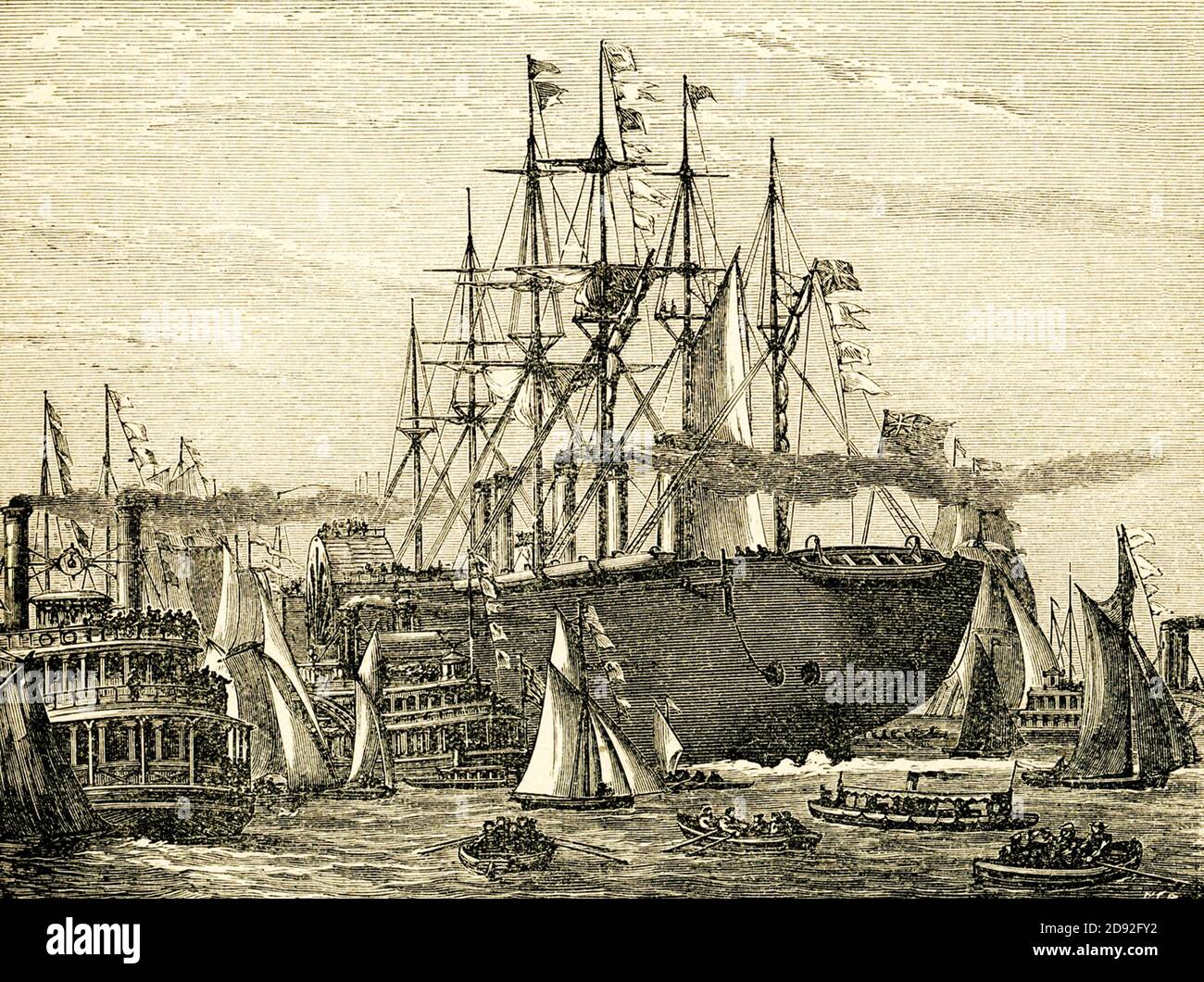 The Landing of the Cable by the 'Great Eastern' Friday July 27 1866. On Friday, 13 July 1866, the Great Eastern, by far the largest ship afloat, left Valentia, Ireland , with 2730 nautical miles of cable in her hold. Fourteen days later 1852 miles of this cable lay at the bottom of the ocean, the ship was at anchor in Trinity Bay, Newfoundland, and the old and new worlds were in permanent telegraphic communication. Cyrus West Field (1819 – 1892) was an American businessman and financier who, along with other entrepreneurs, created the Atlantic Telegraph Company and laid the first telegraph cab Stock Photohttps://www.alamy.com/image-license-details/?v=1https://www.alamy.com/the-landing-of-the-cable-by-the-great-eastern-friday-july-27-1866-on-friday-13-july-1866-thegreat-eastern-by-far-the-largest-ship-afloat-left-valentia-ireland-with-2730-nautical-miles-of-cable-in-her-hold-fourteen-days-later-1852-miles-of-this-cable-lay-at-the-bottom-of-the-ocean-the-ship-was-at-anchor-in-trinity-bay-newfoundland-and-the-old-and-new-worlds-were-in-permanent-telegraphic-communication-cyruswestfield1819-1892-was-an-american-businessman-and-financier-who-alongwithother-entrepreneurs-created-the-atlantic-telegraph-company-and-laid-the-first-telegraph-cab-image384216422.html
The Landing of the Cable by the 'Great Eastern' Friday July 27 1866. On Friday, 13 July 1866, the Great Eastern, by far the largest ship afloat, left Valentia, Ireland , with 2730 nautical miles of cable in her hold. Fourteen days later 1852 miles of this cable lay at the bottom of the ocean, the ship was at anchor in Trinity Bay, Newfoundland, and the old and new worlds were in permanent telegraphic communication. Cyrus West Field (1819 – 1892) was an American businessman and financier who, along with other entrepreneurs, created the Atlantic Telegraph Company and laid the first telegraph cab Stock Photohttps://www.alamy.com/image-license-details/?v=1https://www.alamy.com/the-landing-of-the-cable-by-the-great-eastern-friday-july-27-1866-on-friday-13-july-1866-thegreat-eastern-by-far-the-largest-ship-afloat-left-valentia-ireland-with-2730-nautical-miles-of-cable-in-her-hold-fourteen-days-later-1852-miles-of-this-cable-lay-at-the-bottom-of-the-ocean-the-ship-was-at-anchor-in-trinity-bay-newfoundland-and-the-old-and-new-worlds-were-in-permanent-telegraphic-communication-cyruswestfield1819-1892-was-an-american-businessman-and-financier-who-alongwithother-entrepreneurs-created-the-atlantic-telegraph-company-and-laid-the-first-telegraph-cab-image384216422.htmlRF2D92FY2–The Landing of the Cable by the 'Great Eastern' Friday July 27 1866. On Friday, 13 July 1866, the Great Eastern, by far the largest ship afloat, left Valentia, Ireland , with 2730 nautical miles of cable in her hold. Fourteen days later 1852 miles of this cable lay at the bottom of the ocean, the ship was at anchor in Trinity Bay, Newfoundland, and the old and new worlds were in permanent telegraphic communication. Cyrus West Field (1819 – 1892) was an American businessman and financier who, along with other entrepreneurs, created the Atlantic Telegraph Company and laid the first telegraph cab
 The laying of the Atlantic Telegraph cable. Encampment of workmen of the telegraph company on the road between Killarney and Valentia Island, Ireland. From The Illustrated London News, published 1865. Stock Photohttps://www.alamy.com/image-license-details/?v=1https://www.alamy.com/the-laying-of-the-atlantic-telegraph-cable-encampment-of-workmen-of-the-telegraph-company-on-the-road-between-killarney-and-valentia-island-ireland-from-the-illustrated-london-news-published-1865-image242676929.html
The laying of the Atlantic Telegraph cable. Encampment of workmen of the telegraph company on the road between Killarney and Valentia Island, Ireland. From The Illustrated London News, published 1865. Stock Photohttps://www.alamy.com/image-license-details/?v=1https://www.alamy.com/the-laying-of-the-atlantic-telegraph-cable-encampment-of-workmen-of-the-telegraph-company-on-the-road-between-killarney-and-valentia-island-ireland-from-the-illustrated-london-news-published-1865-image242676929.htmlRMT2PTW5–The laying of the Atlantic Telegraph cable. Encampment of workmen of the telegraph company on the road between Killarney and Valentia Island, Ireland. From The Illustrated London News, published 1865.
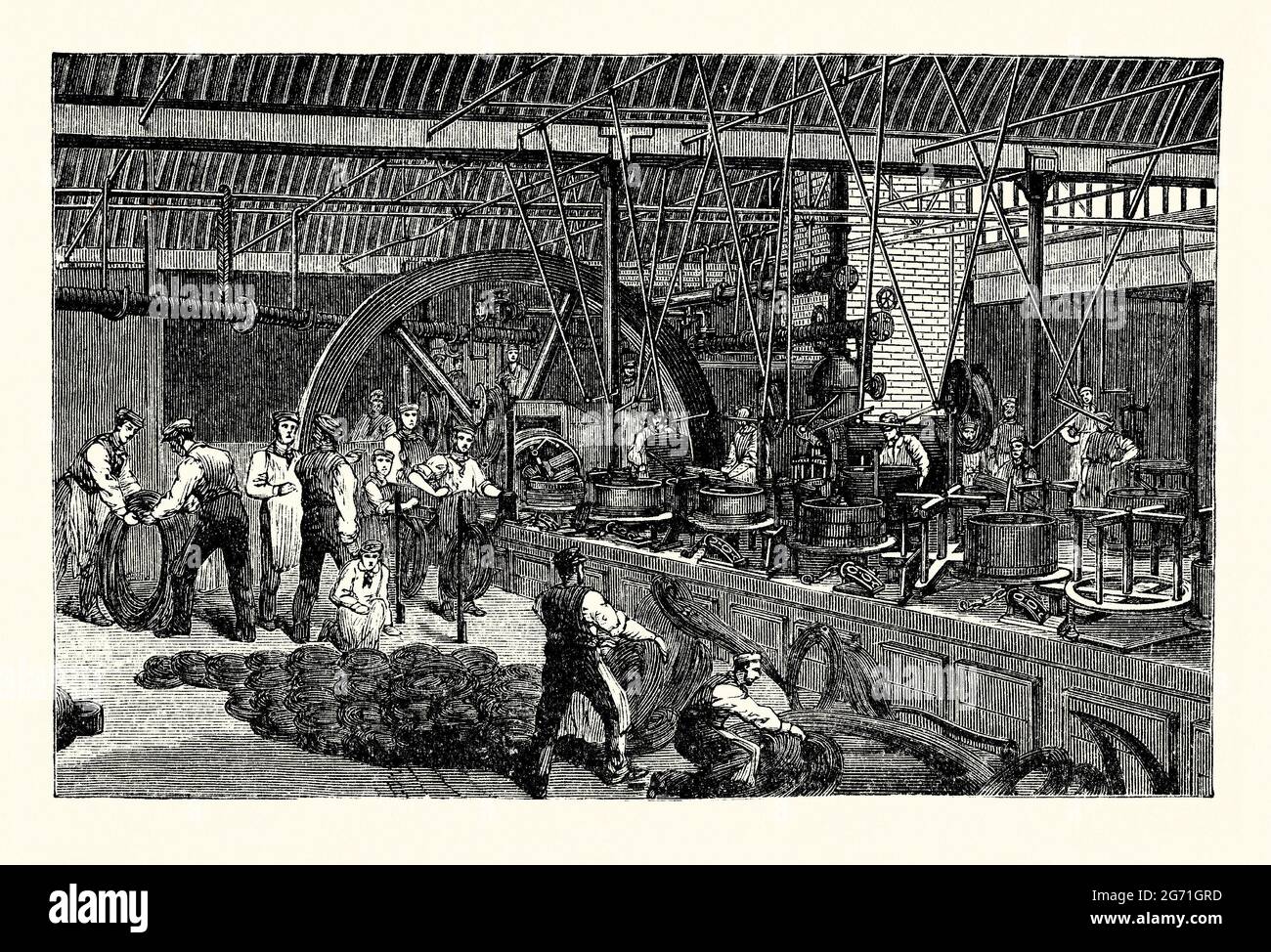 An old engraving of the outer, iron wire covering of the transatlantic telegraph cables being made at the factory of Webster & Horsfall, Birmingham, England, UK c.1865. It is from a book of the 1890s on Victorian discoveries and inventions during the 1800s. The cables themselves were manufactured by Glass, Elliot and Company in Greenwich, London. The cables were laid under the Atlantic Ocean for telegraph communications. This second cable was laid in 1865 from Brunel’s ship SS Great Eastern. The cable broke in mid-Atlantic; after many rescue attempts, it was abandoned. Stock Photohttps://www.alamy.com/image-license-details/?v=1https://www.alamy.com/an-old-engraving-of-the-outer-iron-wire-covering-of-the-transatlantic-telegraph-cables-being-made-at-the-factory-of-webster-horsfall-birmingham-england-uk-c1865-it-is-from-a-book-of-the-1890s-on-victorian-discoveries-and-inventions-during-the-1800s-the-cables-themselves-were-manufactured-by-glass-elliot-and-company-in-greenwich-london-the-cables-were-laid-under-the-atlantic-ocean-for-telegraph-communications-this-second-cable-was-laid-in-1865-from-brunels-ship-ss-great-eastern-the-cable-broke-in-mid-atlantic-after-many-rescue-attempts-it-was-abandoned-image434596945.html
An old engraving of the outer, iron wire covering of the transatlantic telegraph cables being made at the factory of Webster & Horsfall, Birmingham, England, UK c.1865. It is from a book of the 1890s on Victorian discoveries and inventions during the 1800s. The cables themselves were manufactured by Glass, Elliot and Company in Greenwich, London. The cables were laid under the Atlantic Ocean for telegraph communications. This second cable was laid in 1865 from Brunel’s ship SS Great Eastern. The cable broke in mid-Atlantic; after many rescue attempts, it was abandoned. Stock Photohttps://www.alamy.com/image-license-details/?v=1https://www.alamy.com/an-old-engraving-of-the-outer-iron-wire-covering-of-the-transatlantic-telegraph-cables-being-made-at-the-factory-of-webster-horsfall-birmingham-england-uk-c1865-it-is-from-a-book-of-the-1890s-on-victorian-discoveries-and-inventions-during-the-1800s-the-cables-themselves-were-manufactured-by-glass-elliot-and-company-in-greenwich-london-the-cables-were-laid-under-the-atlantic-ocean-for-telegraph-communications-this-second-cable-was-laid-in-1865-from-brunels-ship-ss-great-eastern-the-cable-broke-in-mid-atlantic-after-many-rescue-attempts-it-was-abandoned-image434596945.htmlRM2G71GRD–An old engraving of the outer, iron wire covering of the transatlantic telegraph cables being made at the factory of Webster & Horsfall, Birmingham, England, UK c.1865. It is from a book of the 1890s on Victorian discoveries and inventions during the 1800s. The cables themselves were manufactured by Glass, Elliot and Company in Greenwich, London. The cables were laid under the Atlantic Ocean for telegraph communications. This second cable was laid in 1865 from Brunel’s ship SS Great Eastern. The cable broke in mid-Atlantic; after many rescue attempts, it was abandoned.
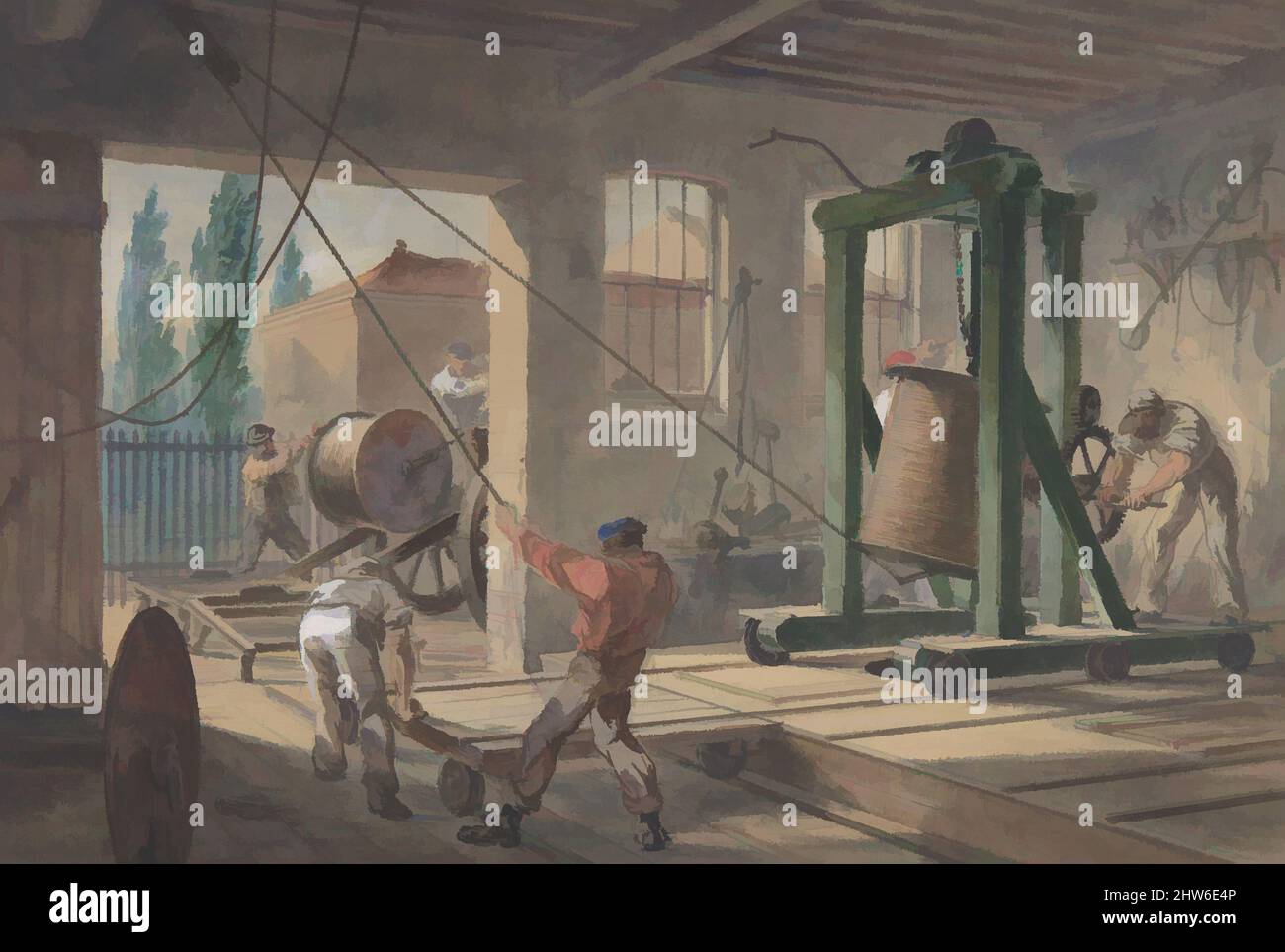 Art inspired by The Reels of Gutta-percha Covered Conducting Wire Conveyed into Tanks at the Works of the Telegraph Construction and Maintenance Company, at Greenwich, 1865–66, Watercolor over graphite with touches of gouache, Sheet: 6 7/16 × 9 9/16 in. (16.3 × 24.3 cm), Drawings, Classic works modernized by Artotop with a splash of modernity. Shapes, color and value, eye-catching visual impact on art. Emotions through freedom of artworks in a contemporary way. A timeless message pursuing a wildly creative new direction. Artists turning to the digital medium and creating the Artotop NFT Stock Photohttps://www.alamy.com/image-license-details/?v=1https://www.alamy.com/art-inspired-by-the-reels-of-gutta-percha-covered-conducting-wire-conveyed-into-tanks-at-the-works-of-the-telegraph-construction-and-maintenance-company-at-greenwich-186566-watercolor-over-graphite-with-touches-of-gouache-sheet-6-716-9-916-in-163-243-cm-drawings-classic-works-modernized-by-artotop-with-a-splash-of-modernity-shapes-color-and-value-eye-catching-visual-impact-on-art-emotions-through-freedom-of-artworks-in-a-contemporary-way-a-timeless-message-pursuing-a-wildly-creative-new-direction-artists-turning-to-the-digital-medium-and-creating-the-artotop-nft-image462978790.html
Art inspired by The Reels of Gutta-percha Covered Conducting Wire Conveyed into Tanks at the Works of the Telegraph Construction and Maintenance Company, at Greenwich, 1865–66, Watercolor over graphite with touches of gouache, Sheet: 6 7/16 × 9 9/16 in. (16.3 × 24.3 cm), Drawings, Classic works modernized by Artotop with a splash of modernity. Shapes, color and value, eye-catching visual impact on art. Emotions through freedom of artworks in a contemporary way. A timeless message pursuing a wildly creative new direction. Artists turning to the digital medium and creating the Artotop NFT Stock Photohttps://www.alamy.com/image-license-details/?v=1https://www.alamy.com/art-inspired-by-the-reels-of-gutta-percha-covered-conducting-wire-conveyed-into-tanks-at-the-works-of-the-telegraph-construction-and-maintenance-company-at-greenwich-186566-watercolor-over-graphite-with-touches-of-gouache-sheet-6-716-9-916-in-163-243-cm-drawings-classic-works-modernized-by-artotop-with-a-splash-of-modernity-shapes-color-and-value-eye-catching-visual-impact-on-art-emotions-through-freedom-of-artworks-in-a-contemporary-way-a-timeless-message-pursuing-a-wildly-creative-new-direction-artists-turning-to-the-digital-medium-and-creating-the-artotop-nft-image462978790.htmlRF2HW6E4P–Art inspired by The Reels of Gutta-percha Covered Conducting Wire Conveyed into Tanks at the Works of the Telegraph Construction and Maintenance Company, at Greenwich, 1865–66, Watercolor over graphite with touches of gouache, Sheet: 6 7/16 × 9 9/16 in. (16.3 × 24.3 cm), Drawings, Classic works modernized by Artotop with a splash of modernity. Shapes, color and value, eye-catching visual impact on art. Emotions through freedom of artworks in a contemporary way. A timeless message pursuing a wildly creative new direction. Artists turning to the digital medium and creating the Artotop NFT
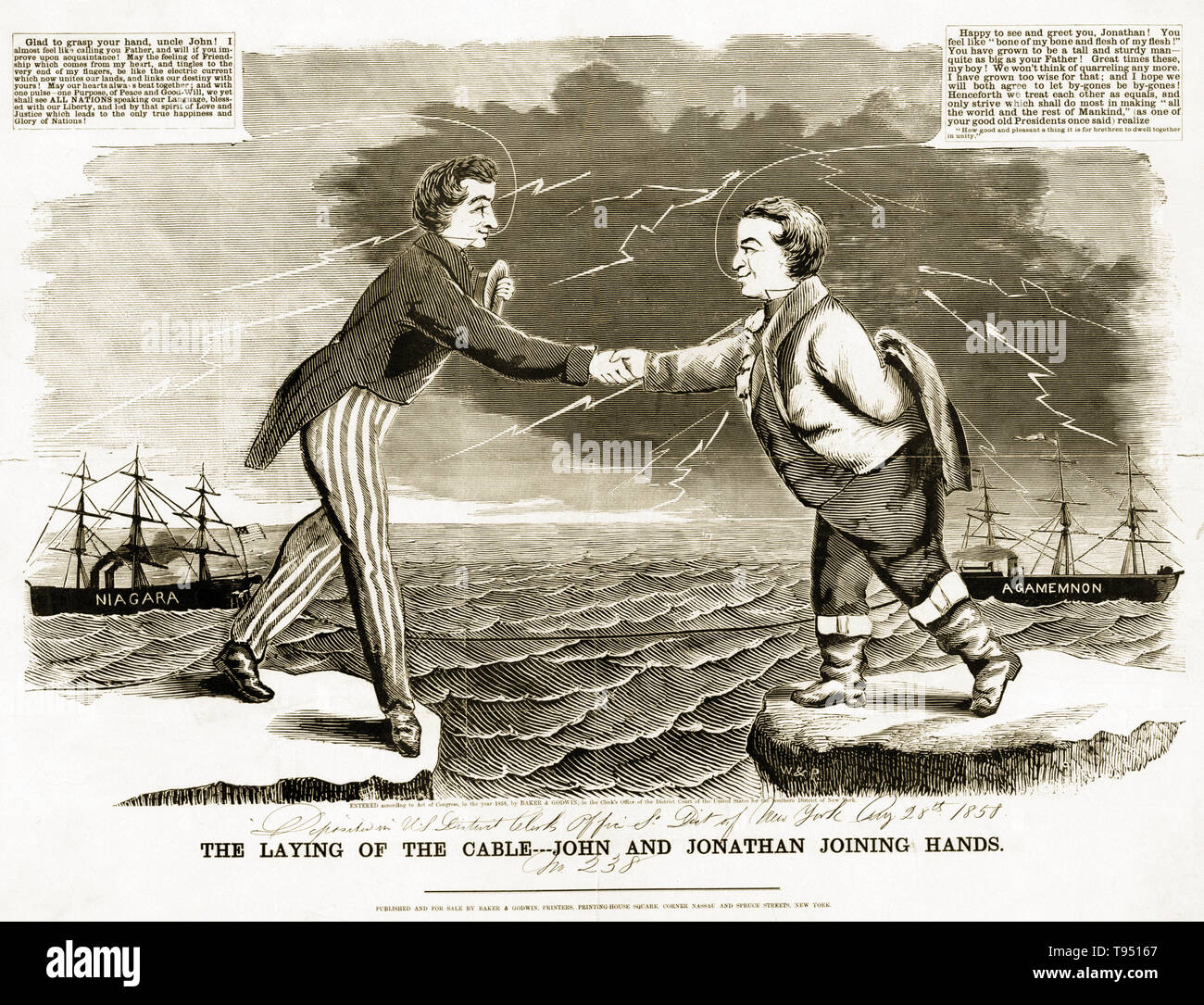 The Laying of the Cable: John and Jonathon Joining Hands. One of the 19th century's great technological achievements was to lay a telegraphic cable beneath the Atlantic, allowing messages to speed back and forth between North America and Europe in minutes, rather than ten or twelve days by steamer. An initially successful attempt in 1858, led by Cyrus W. Field and financed by the Atlantic Telegraph Company, failed after three weeks. Stock Photohttps://www.alamy.com/image-license-details/?v=1https://www.alamy.com/the-laying-of-the-cable-john-and-jonathon-joining-hands-one-of-the-19th-centurys-great-technological-achievements-was-to-lay-a-telegraphic-cable-beneath-the-atlantic-allowing-messages-to-speed-back-and-forth-between-north-america-and-europe-in-minutes-rather-than-ten-or-twelve-days-by-steamer-an-initially-successful-attempt-in-1858-led-by-cyrus-w-field-and-financed-by-the-atlantic-telegraph-company-failed-after-three-weeks-image246587775.html
The Laying of the Cable: John and Jonathon Joining Hands. One of the 19th century's great technological achievements was to lay a telegraphic cable beneath the Atlantic, allowing messages to speed back and forth between North America and Europe in minutes, rather than ten or twelve days by steamer. An initially successful attempt in 1858, led by Cyrus W. Field and financed by the Atlantic Telegraph Company, failed after three weeks. Stock Photohttps://www.alamy.com/image-license-details/?v=1https://www.alamy.com/the-laying-of-the-cable-john-and-jonathon-joining-hands-one-of-the-19th-centurys-great-technological-achievements-was-to-lay-a-telegraphic-cable-beneath-the-atlantic-allowing-messages-to-speed-back-and-forth-between-north-america-and-europe-in-minutes-rather-than-ten-or-twelve-days-by-steamer-an-initially-successful-attempt-in-1858-led-by-cyrus-w-field-and-financed-by-the-atlantic-telegraph-company-failed-after-three-weeks-image246587775.htmlRMT95167–The Laying of the Cable: John and Jonathon Joining Hands. One of the 19th century's great technological achievements was to lay a telegraphic cable beneath the Atlantic, allowing messages to speed back and forth between North America and Europe in minutes, rather than ten or twelve days by steamer. An initially successful attempt in 1858, led by Cyrus W. Field and financed by the Atlantic Telegraph Company, failed after three weeks.
 Trans-atlantic telephone service opening Stock Photohttps://www.alamy.com/image-license-details/?v=1https://www.alamy.com/trans-atlantic-telephone-service-opening-image501357848.html
Trans-atlantic telephone service opening Stock Photohttps://www.alamy.com/image-license-details/?v=1https://www.alamy.com/trans-atlantic-telephone-service-opening-image501357848.htmlRM2M3JR1C–Trans-atlantic telephone service opening
 CYRUS WEST FIELD (1819-1892) American businessman and financier Stock Photohttps://www.alamy.com/image-license-details/?v=1https://www.alamy.com/cyrus-west-field-1819-1892-american-businessman-and-financier-image338839358.html
CYRUS WEST FIELD (1819-1892) American businessman and financier Stock Photohttps://www.alamy.com/image-license-details/?v=1https://www.alamy.com/cyrus-west-field-1819-1892-american-businessman-and-financier-image338839358.htmlRM2AK7D1J–CYRUS WEST FIELD (1819-1892) American businessman and financier
 Foilhummerum Bay, Valentia, Looking Seawards from the Point at Which the Cable Reaches the Shore of Ireland. Artist: Robert Charles Dudley (British, 1826-1909). Dimensions: Sheet: 6 5/16 × 9 1/4 in. (16 × 23.5 cm). Date: 1865-66. One of the 19th century's great technological achievements was to lay a telegraphic cable beneath the Atlantic, allowing messages to speed back and forth between North America and Europe in minutes, rather than ten or twelve days by steamer. An initially successful attempt in 1858, led by Cyrus W. Field and financed by the Atlantic Telegraph Company, failed after thr Stock Photohttps://www.alamy.com/image-license-details/?v=1https://www.alamy.com/foilhummerum-bay-valentia-looking-seawards-from-the-point-at-which-the-cable-reaches-the-shore-of-ireland-artist-robert-charles-dudley-british-1826-1909-dimensions-sheet-6-516-9-14-in-16-235-cm-date-1865-66-one-of-the-19th-centurys-great-technological-achievements-was-to-lay-a-telegraphic-cable-beneath-the-atlantic-allowing-messages-to-speed-back-and-forth-between-north-america-and-europe-in-minutes-rather-than-ten-or-twelve-days-by-steamer-an-initially-successful-attempt-in-1858-led-by-cyrus-w-field-and-financed-by-the-atlantic-telegraph-company-failed-after-thr-image213107182.html
Foilhummerum Bay, Valentia, Looking Seawards from the Point at Which the Cable Reaches the Shore of Ireland. Artist: Robert Charles Dudley (British, 1826-1909). Dimensions: Sheet: 6 5/16 × 9 1/4 in. (16 × 23.5 cm). Date: 1865-66. One of the 19th century's great technological achievements was to lay a telegraphic cable beneath the Atlantic, allowing messages to speed back and forth between North America and Europe in minutes, rather than ten or twelve days by steamer. An initially successful attempt in 1858, led by Cyrus W. Field and financed by the Atlantic Telegraph Company, failed after thr Stock Photohttps://www.alamy.com/image-license-details/?v=1https://www.alamy.com/foilhummerum-bay-valentia-looking-seawards-from-the-point-at-which-the-cable-reaches-the-shore-of-ireland-artist-robert-charles-dudley-british-1826-1909-dimensions-sheet-6-516-9-14-in-16-235-cm-date-1865-66-one-of-the-19th-centurys-great-technological-achievements-was-to-lay-a-telegraphic-cable-beneath-the-atlantic-allowing-messages-to-speed-back-and-forth-between-north-america-and-europe-in-minutes-rather-than-ten-or-twelve-days-by-steamer-an-initially-successful-attempt-in-1858-led-by-cyrus-w-field-and-financed-by-the-atlantic-telegraph-company-failed-after-thr-image213107182.htmlRMPAKTAP–Foilhummerum Bay, Valentia, Looking Seawards from the Point at Which the Cable Reaches the Shore of Ireland. Artist: Robert Charles Dudley (British, 1826-1909). Dimensions: Sheet: 6 5/16 × 9 1/4 in. (16 × 23.5 cm). Date: 1865-66. One of the 19th century's great technological achievements was to lay a telegraphic cable beneath the Atlantic, allowing messages to speed back and forth between North America and Europe in minutes, rather than ten or twelve days by steamer. An initially successful attempt in 1858, led by Cyrus W. Field and financed by the Atlantic Telegraph Company, failed after thr
 CYRUS WEST FIELD (1819-1892) American financier whose company laid the first telegraph cable across the Atlantic in 1858 Stock Photohttps://www.alamy.com/image-license-details/?v=1https://www.alamy.com/stock-photo-cyrus-west-field-1819-1892-american-financier-whose-company-laid-the-135673168.html
CYRUS WEST FIELD (1819-1892) American financier whose company laid the first telegraph cable across the Atlantic in 1858 Stock Photohttps://www.alamy.com/image-license-details/?v=1https://www.alamy.com/stock-photo-cyrus-west-field-1819-1892-american-financier-whose-company-laid-the-135673168.htmlRMHTMCE8–CYRUS WEST FIELD (1819-1892) American financier whose company laid the first telegraph cable across the Atlantic in 1858
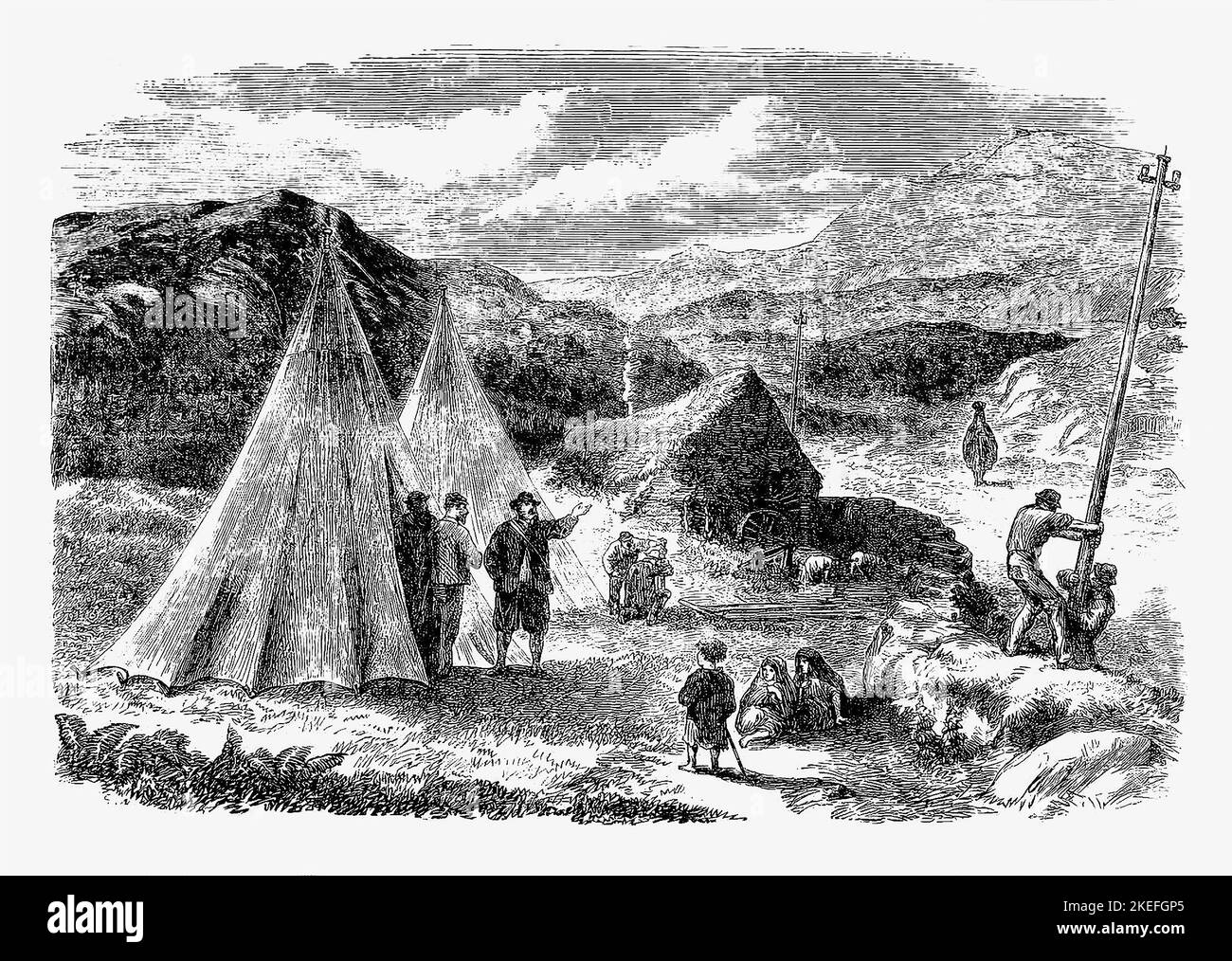 The camp of workers in the 19th century erecting poles for the Telegraph Company on the road between Killarney and Valencia, County Kerry, Ireland. Stock Photohttps://www.alamy.com/image-license-details/?v=1https://www.alamy.com/the-camp-of-workers-in-the-19th-century-erecting-poles-for-the-telegraph-company-on-the-road-between-killarney-and-valencia-county-kerry-ireland-image490837933.html
The camp of workers in the 19th century erecting poles for the Telegraph Company on the road between Killarney and Valencia, County Kerry, Ireland. Stock Photohttps://www.alamy.com/image-license-details/?v=1https://www.alamy.com/the-camp-of-workers-in-the-19th-century-erecting-poles-for-the-telegraph-company-on-the-road-between-killarney-and-valencia-county-kerry-ireland-image490837933.htmlRM2KEFGP5–The camp of workers in the 19th century erecting poles for the Telegraph Company on the road between Killarney and Valencia, County Kerry, Ireland.
![Celebration of the Laying of the Atlantic Telegraph Cable at New York - the Illumination of the City Hall, 1858. Firework display, with inscription: 'All Honour to Cyrus [?] Field'. American businessman and financier Cyrus West Field created the Atlantic Telegraph Company and laid the first telegraph cable across the Atlantic Ocean in 1858. The connection between North America and Europe was celebrated by an exchange of messages between Queen Victoria of England and President Buchanan of the United States using the new cable line. From "Illustrated London News", 1858. Stock Photo Celebration of the Laying of the Atlantic Telegraph Cable at New York - the Illumination of the City Hall, 1858. Firework display, with inscription: 'All Honour to Cyrus [?] Field'. American businessman and financier Cyrus West Field created the Atlantic Telegraph Company and laid the first telegraph cable across the Atlantic Ocean in 1858. The connection between North America and Europe was celebrated by an exchange of messages between Queen Victoria of England and President Buchanan of the United States using the new cable line. From "Illustrated London News", 1858. Stock Photo](https://c8.alamy.com/comp/2RRJ8YY/celebration-of-the-laying-of-the-atlantic-telegraph-cable-at-new-york-the-illumination-of-the-city-hall-1858-firework-display-with-inscription-all-honour-to-cyrus-field-american-businessman-and-financier-cyrus-west-field-created-the-atlantic-telegraph-company-and-laid-the-first-telegraph-cable-across-the-atlantic-ocean-in-1858-the-connection-between-north-america-and-europe-was-celebrated-by-an-exchange-of-messages-between-queen-victoria-of-england-and-president-buchanan-of-the-united-states-using-the-new-cable-line-from-quotillustrated-london-newsquot-1858-2RRJ8YY.jpg) Celebration of the Laying of the Atlantic Telegraph Cable at New York - the Illumination of the City Hall, 1858. Firework display, with inscription: 'All Honour to Cyrus [?] Field'. American businessman and financier Cyrus West Field created the Atlantic Telegraph Company and laid the first telegraph cable across the Atlantic Ocean in 1858. The connection between North America and Europe was celebrated by an exchange of messages between Queen Victoria of England and President Buchanan of the United States using the new cable line. From "Illustrated London News", 1858. Stock Photohttps://www.alamy.com/image-license-details/?v=1https://www.alamy.com/celebration-of-the-laying-of-the-atlantic-telegraph-cable-at-new-york-the-illumination-of-the-city-hall-1858-firework-display-with-inscription-all-honour-to-cyrus-field-american-businessman-and-financier-cyrus-west-field-created-the-atlantic-telegraph-company-and-laid-the-first-telegraph-cable-across-the-atlantic-ocean-in-1858-the-connection-between-north-america-and-europe-was-celebrated-by-an-exchange-of-messages-between-queen-victoria-of-england-and-president-buchanan-of-the-united-states-using-the-new-cable-line-from-quotillustrated-london-newsquot-1858-image565271055.html
Celebration of the Laying of the Atlantic Telegraph Cable at New York - the Illumination of the City Hall, 1858. Firework display, with inscription: 'All Honour to Cyrus [?] Field'. American businessman and financier Cyrus West Field created the Atlantic Telegraph Company and laid the first telegraph cable across the Atlantic Ocean in 1858. The connection between North America and Europe was celebrated by an exchange of messages between Queen Victoria of England and President Buchanan of the United States using the new cable line. From "Illustrated London News", 1858. Stock Photohttps://www.alamy.com/image-license-details/?v=1https://www.alamy.com/celebration-of-the-laying-of-the-atlantic-telegraph-cable-at-new-york-the-illumination-of-the-city-hall-1858-firework-display-with-inscription-all-honour-to-cyrus-field-american-businessman-and-financier-cyrus-west-field-created-the-atlantic-telegraph-company-and-laid-the-first-telegraph-cable-across-the-atlantic-ocean-in-1858-the-connection-between-north-america-and-europe-was-celebrated-by-an-exchange-of-messages-between-queen-victoria-of-england-and-president-buchanan-of-the-united-states-using-the-new-cable-line-from-quotillustrated-london-newsquot-1858-image565271055.htmlRM2RRJ8YY–Celebration of the Laying of the Atlantic Telegraph Cable at New York - the Illumination of the City Hall, 1858. Firework display, with inscription: 'All Honour to Cyrus [?] Field'. American businessman and financier Cyrus West Field created the Atlantic Telegraph Company and laid the first telegraph cable across the Atlantic Ocean in 1858. The connection between North America and Europe was celebrated by an exchange of messages between Queen Victoria of England and President Buchanan of the United States using the new cable line. From "Illustrated London News", 1858.
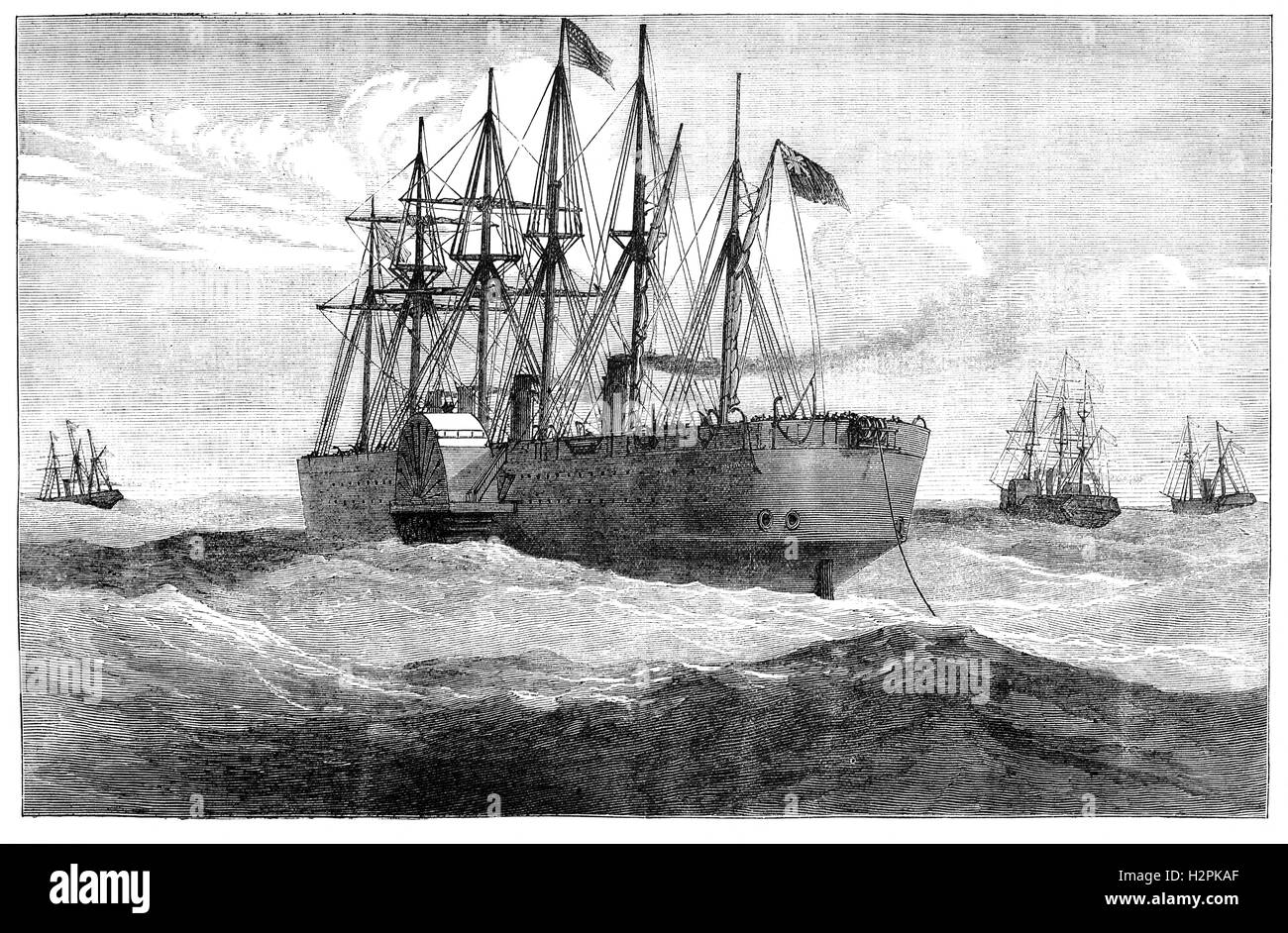 SS Great Eastern was an iron sailing steam ship designed by Isambard Kingdom Brunel and the largest ship ever built at the time of her 1858 launch. Following conversion work she was chartered to the newly formed Telegraph Construction and Maintenance Company and laid 4,200 kilometres (2,600 miles) of the 1865 transatlantic telegraph cable. Then 48,000 kilometres (30,000 miles) of submarine telegraph from Brest, France to Saint Pierre and Miquelon, off Newfoundland in 1869, and from Aden to Bombay in 1869 and 1870. Stock Photohttps://www.alamy.com/image-license-details/?v=1https://www.alamy.com/stock-photo-ss-great-eastern-was-an-iron-sailing-steam-ship-designed-by-isambard-122200023.html
SS Great Eastern was an iron sailing steam ship designed by Isambard Kingdom Brunel and the largest ship ever built at the time of her 1858 launch. Following conversion work she was chartered to the newly formed Telegraph Construction and Maintenance Company and laid 4,200 kilometres (2,600 miles) of the 1865 transatlantic telegraph cable. Then 48,000 kilometres (30,000 miles) of submarine telegraph from Brest, France to Saint Pierre and Miquelon, off Newfoundland in 1869, and from Aden to Bombay in 1869 and 1870. Stock Photohttps://www.alamy.com/image-license-details/?v=1https://www.alamy.com/stock-photo-ss-great-eastern-was-an-iron-sailing-steam-ship-designed-by-isambard-122200023.htmlRMH2PKAF–SS Great Eastern was an iron sailing steam ship designed by Isambard Kingdom Brunel and the largest ship ever built at the time of her 1858 launch. Following conversion work she was chartered to the newly formed Telegraph Construction and Maintenance Company and laid 4,200 kilometres (2,600 miles) of the 1865 transatlantic telegraph cable. Then 48,000 kilometres (30,000 miles) of submarine telegraph from Brest, France to Saint Pierre and Miquelon, off Newfoundland in 1869, and from Aden to Bombay in 1869 and 1870.
 Coiling the Cable in the Large Tanks at the Works of the Telegraph Construction and Maintenance Company of Greenwich, 1865 1865 Robert Charles Dudley British One of the 19th century's great technological achievements was to lay a telegraphic cable beneath the Atlantic, allowing messages to speed back and forth between North America and Europe in minutes, rather than ten or twelve days by steamer. An initially successful attempt in 1858, led by Cyrus W. Field and financed by the Atlantic Telegraph Company, failed after three weeks. Two working cables were finally laid in July and September 1866 Stock Photohttps://www.alamy.com/image-license-details/?v=1https://www.alamy.com/coiling-the-cable-in-the-large-tanks-at-the-works-of-the-telegraph-construction-and-maintenance-company-of-greenwich-1865-1865-robert-charles-dudley-british-one-of-the-19th-centurys-great-technological-achievements-was-to-lay-a-telegraphic-cable-beneath-the-atlantic-allowing-messages-to-speed-back-and-forth-between-north-america-and-europe-in-minutes-rather-than-ten-or-twelve-days-by-steamer-an-initially-successful-attempt-in-1858-led-by-cyrus-w-field-and-financed-by-the-atlantic-telegraph-company-failed-after-three-weeks-two-working-cables-were-finally-laid-in-july-and-september-1866-image458151583.html
Coiling the Cable in the Large Tanks at the Works of the Telegraph Construction and Maintenance Company of Greenwich, 1865 1865 Robert Charles Dudley British One of the 19th century's great technological achievements was to lay a telegraphic cable beneath the Atlantic, allowing messages to speed back and forth between North America and Europe in minutes, rather than ten or twelve days by steamer. An initially successful attempt in 1858, led by Cyrus W. Field and financed by the Atlantic Telegraph Company, failed after three weeks. Two working cables were finally laid in July and September 1866 Stock Photohttps://www.alamy.com/image-license-details/?v=1https://www.alamy.com/coiling-the-cable-in-the-large-tanks-at-the-works-of-the-telegraph-construction-and-maintenance-company-of-greenwich-1865-1865-robert-charles-dudley-british-one-of-the-19th-centurys-great-technological-achievements-was-to-lay-a-telegraphic-cable-beneath-the-atlantic-allowing-messages-to-speed-back-and-forth-between-north-america-and-europe-in-minutes-rather-than-ten-or-twelve-days-by-steamer-an-initially-successful-attempt-in-1858-led-by-cyrus-w-field-and-financed-by-the-atlantic-telegraph-company-failed-after-three-weeks-two-working-cables-were-finally-laid-in-july-and-september-1866-image458151583.htmlRM2HHAH0F–Coiling the Cable in the Large Tanks at the Works of the Telegraph Construction and Maintenance Company of Greenwich, 1865 1865 Robert Charles Dudley British One of the 19th century's great technological achievements was to lay a telegraphic cable beneath the Atlantic, allowing messages to speed back and forth between North America and Europe in minutes, rather than ten or twelve days by steamer. An initially successful attempt in 1858, led by Cyrus W. Field and financed by the Atlantic Telegraph Company, failed after three weeks. Two working cables were finally laid in July and September 1866
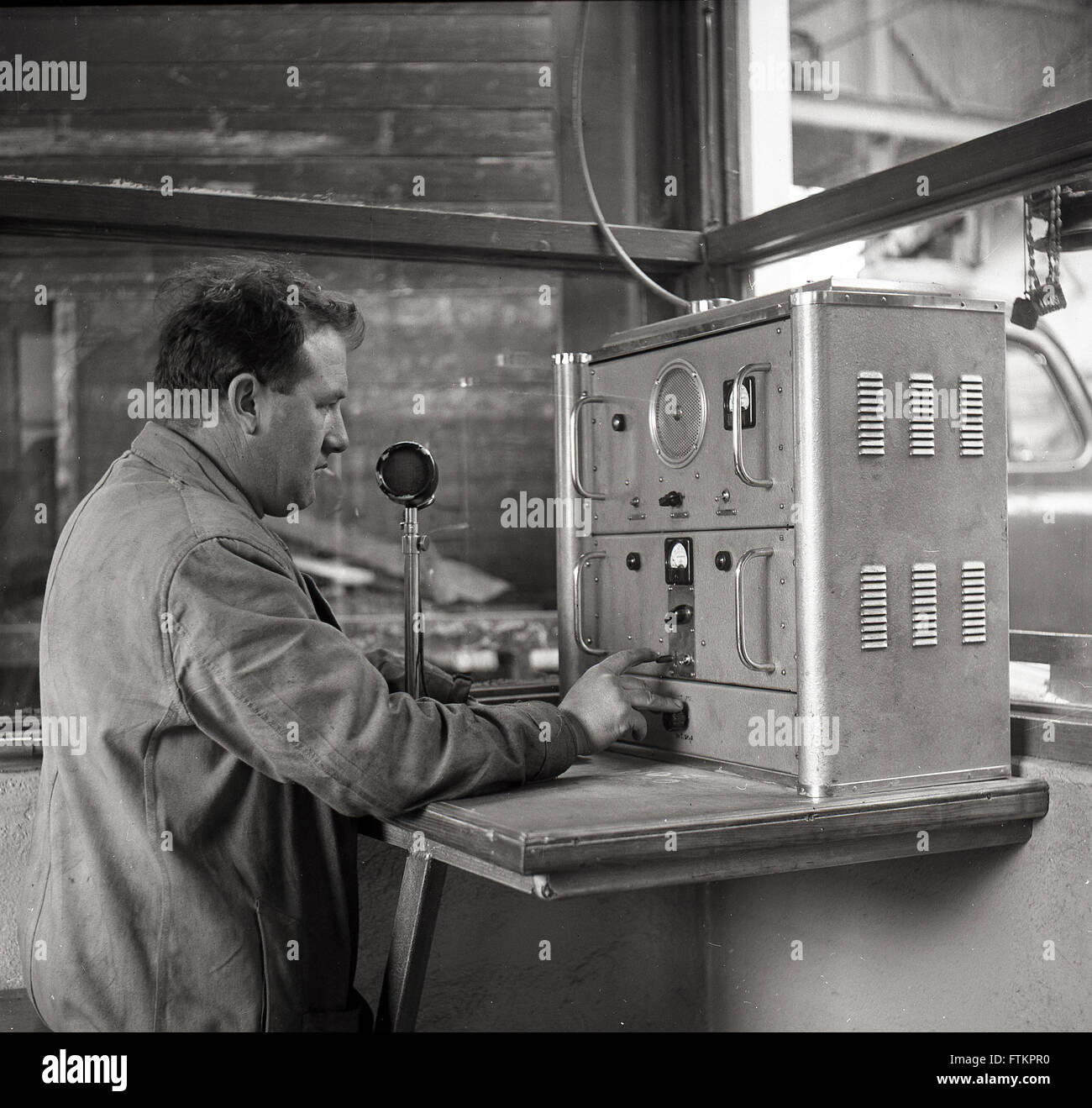 1950s historical, male operator sending a cable message from the Trans-Atlantic Cable Station in Waterville, Kerry, Ireland. Stock Photohttps://www.alamy.com/image-license-details/?v=1https://www.alamy.com/stock-photo-1950s-historical-male-operator-sending-a-cable-message-from-the-trans-101238564.html
1950s historical, male operator sending a cable message from the Trans-Atlantic Cable Station in Waterville, Kerry, Ireland. Stock Photohttps://www.alamy.com/image-license-details/?v=1https://www.alamy.com/stock-photo-1950s-historical-male-operator-sending-a-cable-message-from-the-trans-101238564.htmlRMFTKPR0–1950s historical, male operator sending a cable message from the Trans-Atlantic Cable Station in Waterville, Kerry, Ireland.
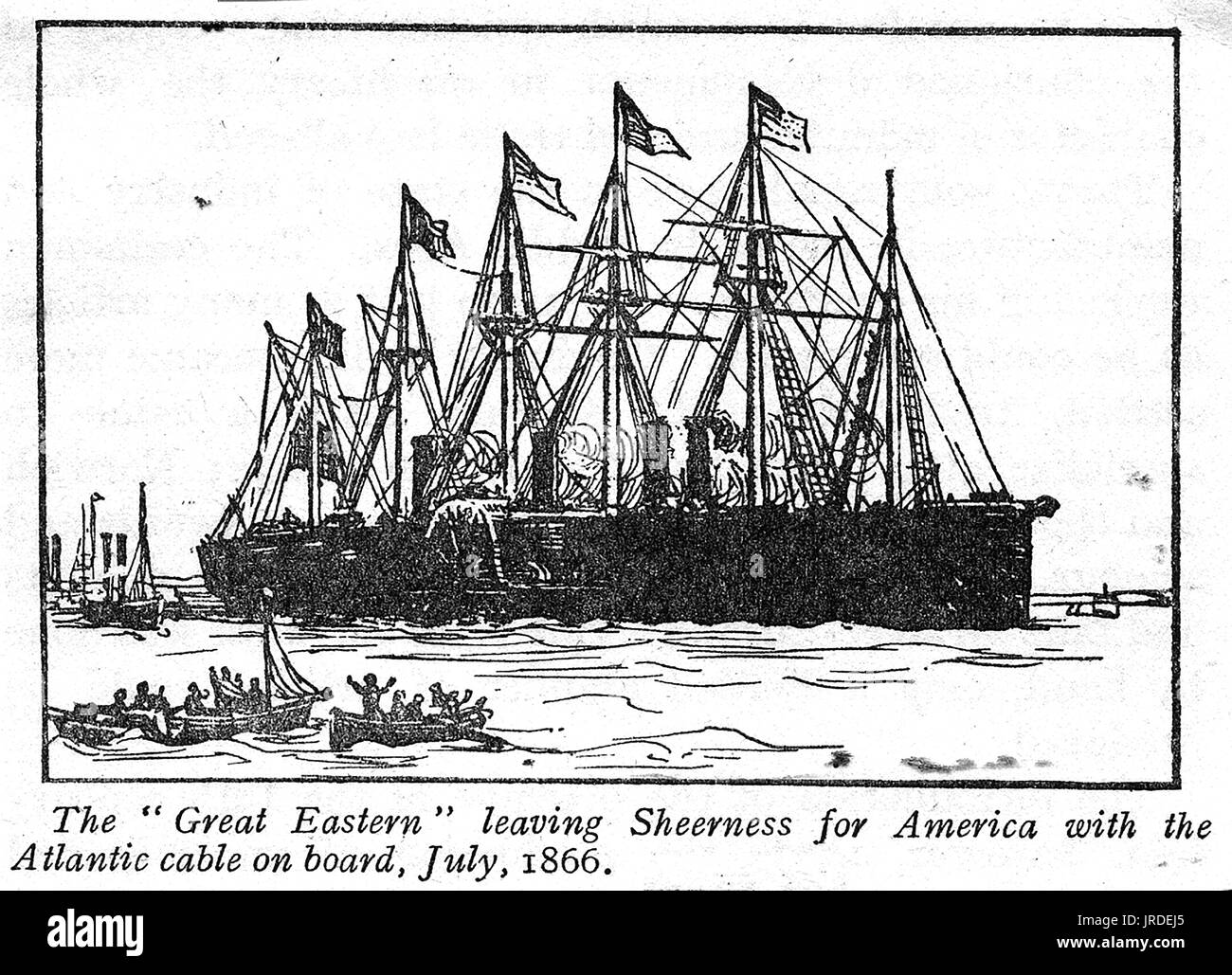 A 1926 sketch of the S S Great Eastern leaving Sheerness to lay the Atlantic cable in 1866 Stock Photohttps://www.alamy.com/image-license-details/?v=1https://www.alamy.com/a-1926-sketch-of-the-s-s-great-eastern-leaving-sheerness-to-lay-the-image152116893.html
A 1926 sketch of the S S Great Eastern leaving Sheerness to lay the Atlantic cable in 1866 Stock Photohttps://www.alamy.com/image-license-details/?v=1https://www.alamy.com/a-1926-sketch-of-the-s-s-great-eastern-leaving-sheerness-to-lay-the-image152116893.htmlRMJRDEJ5–A 1926 sketch of the S S Great Eastern leaving Sheerness to lay the Atlantic cable in 1866
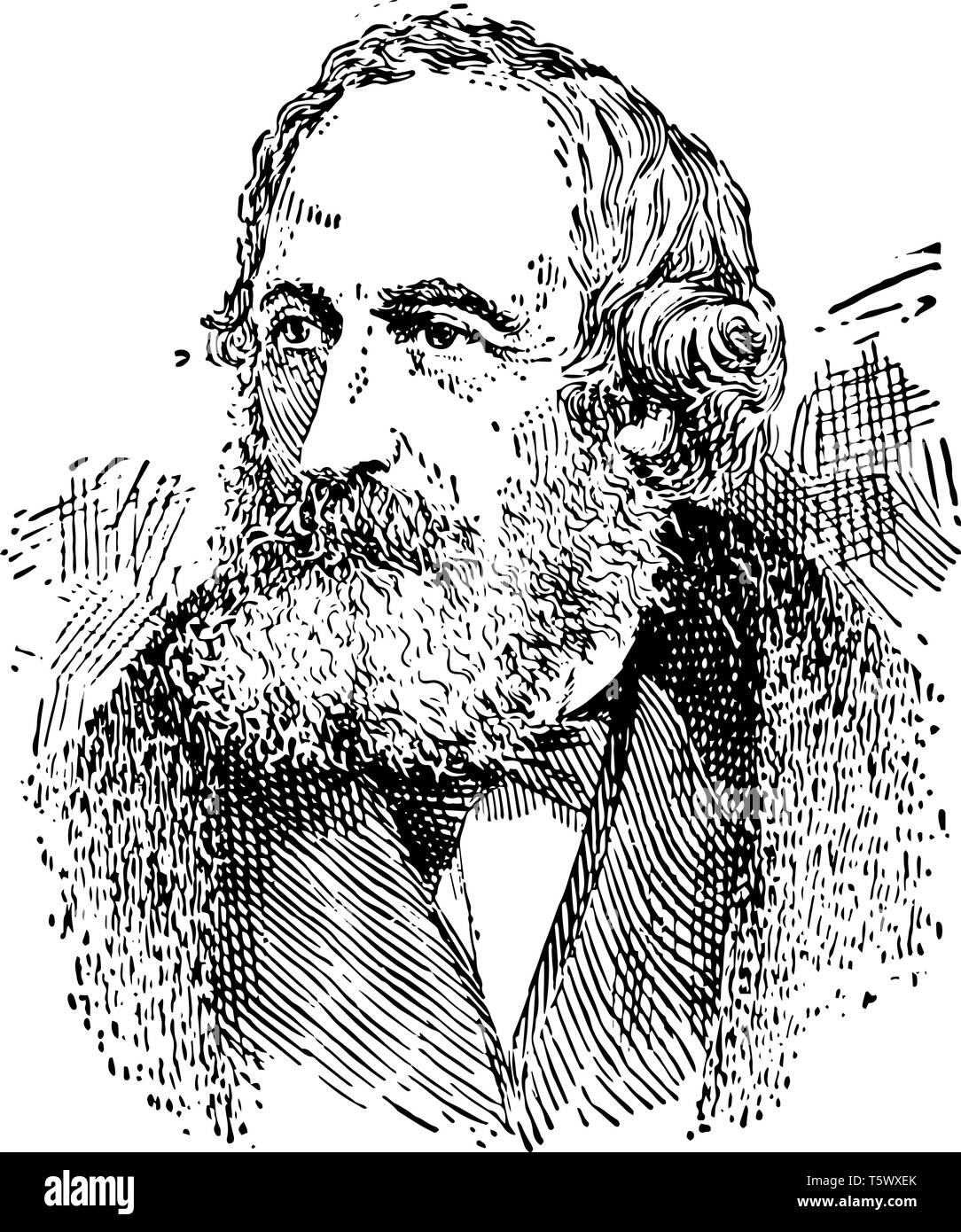 Cyrus West Field 1819 to 1892 he was an American businessman and financier who helped to create the Atlantic Telegraph Company and laid the first tele Stock Vectorhttps://www.alamy.com/image-license-details/?v=1https://www.alamy.com/cyrus-west-field-1819-to-1892-he-was-an-american-businessman-and-financier-who-helped-to-create-the-atlantic-telegraph-company-and-laid-the-first-tele-image244588027.html
Cyrus West Field 1819 to 1892 he was an American businessman and financier who helped to create the Atlantic Telegraph Company and laid the first tele Stock Vectorhttps://www.alamy.com/image-license-details/?v=1https://www.alamy.com/cyrus-west-field-1819-to-1892-he-was-an-american-businessman-and-financier-who-helped-to-create-the-atlantic-telegraph-company-and-laid-the-first-tele-image244588027.htmlRFT5WXEK–Cyrus West Field 1819 to 1892 he was an American businessman and financier who helped to create the Atlantic Telegraph Company and laid the first tele
 Allegorical scene showing Neptune with a trident in foreground, and lion representing Great Britain holding one end of the Atlantic cable and eagle representing the United States holding the other end of the cable, with ocean between them and cities behind them. Includes portrait of the inventor, Cyrus Field, at top center. Stock Photohttps://www.alamy.com/image-license-details/?v=1https://www.alamy.com/allegorical-scene-showing-neptune-with-a-trident-in-foreground-and-lion-representing-great-britain-holding-one-end-of-the-atlantic-cable-and-eagle-representing-the-united-states-holding-the-other-end-of-the-cable-with-ocean-between-them-and-cities-behind-them-includes-portrait-of-the-inventor-cyrus-field-at-top-center-image234892865.html
Allegorical scene showing Neptune with a trident in foreground, and lion representing Great Britain holding one end of the Atlantic cable and eagle representing the United States holding the other end of the cable, with ocean between them and cities behind them. Includes portrait of the inventor, Cyrus Field, at top center. Stock Photohttps://www.alamy.com/image-license-details/?v=1https://www.alamy.com/allegorical-scene-showing-neptune-with-a-trident-in-foreground-and-lion-representing-great-britain-holding-one-end-of-the-atlantic-cable-and-eagle-representing-the-united-states-holding-the-other-end-of-the-cable-with-ocean-between-them-and-cities-behind-them-includes-portrait-of-the-inventor-cyrus-field-at-top-center-image234892865.htmlRMRJ486W–Allegorical scene showing Neptune with a trident in foreground, and lion representing Great Britain holding one end of the Atlantic cable and eagle representing the United States holding the other end of the cable, with ocean between them and cities behind them. Includes portrait of the inventor, Cyrus Field, at top center.
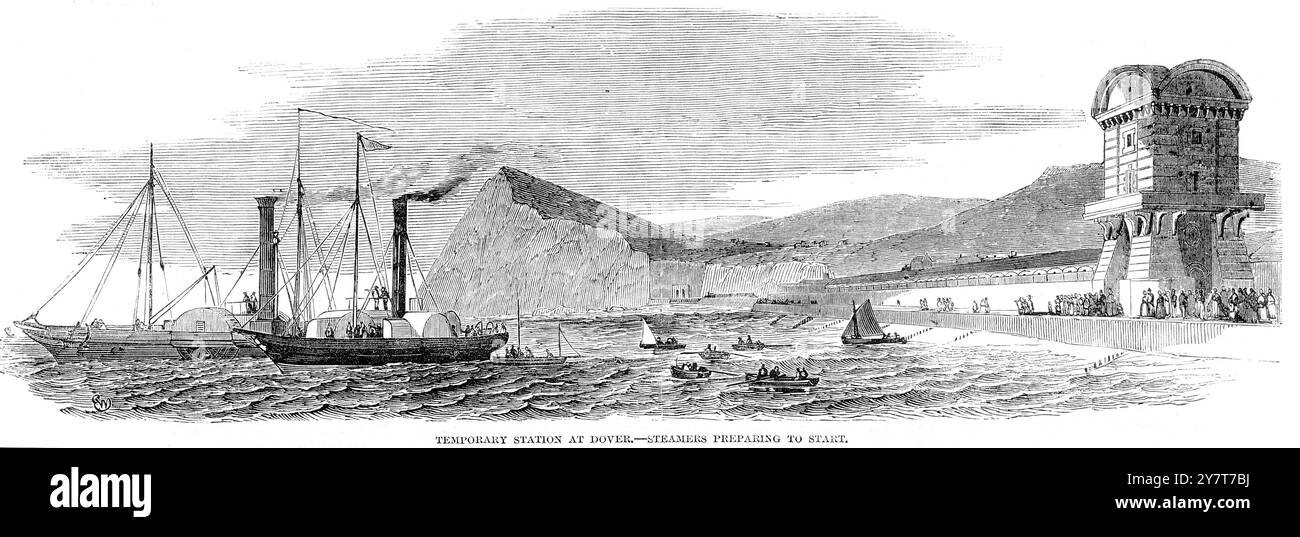 Channel telegraph cable laying for the Atlantic Cable and Submarine Telegraph, the temporary station at Dover where steamers prepare to start. 7 September 1850 Stock Photohttps://www.alamy.com/image-license-details/?v=1https://www.alamy.com/channel-telegraph-cable-laying-for-the-atlantic-cable-and-submarine-telegraph-the-temporary-station-at-dover-where-steamers-prepare-to-start-7-september-1850-image624408502.html
Channel telegraph cable laying for the Atlantic Cable and Submarine Telegraph, the temporary station at Dover where steamers prepare to start. 7 September 1850 Stock Photohttps://www.alamy.com/image-license-details/?v=1https://www.alamy.com/channel-telegraph-cable-laying-for-the-atlantic-cable-and-submarine-telegraph-the-temporary-station-at-dover-where-steamers-prepare-to-start-7-september-1850-image624408502.htmlRM2Y7T7BJ–Channel telegraph cable laying for the Atlantic Cable and Submarine Telegraph, the temporary station at Dover where steamers prepare to start. 7 September 1850
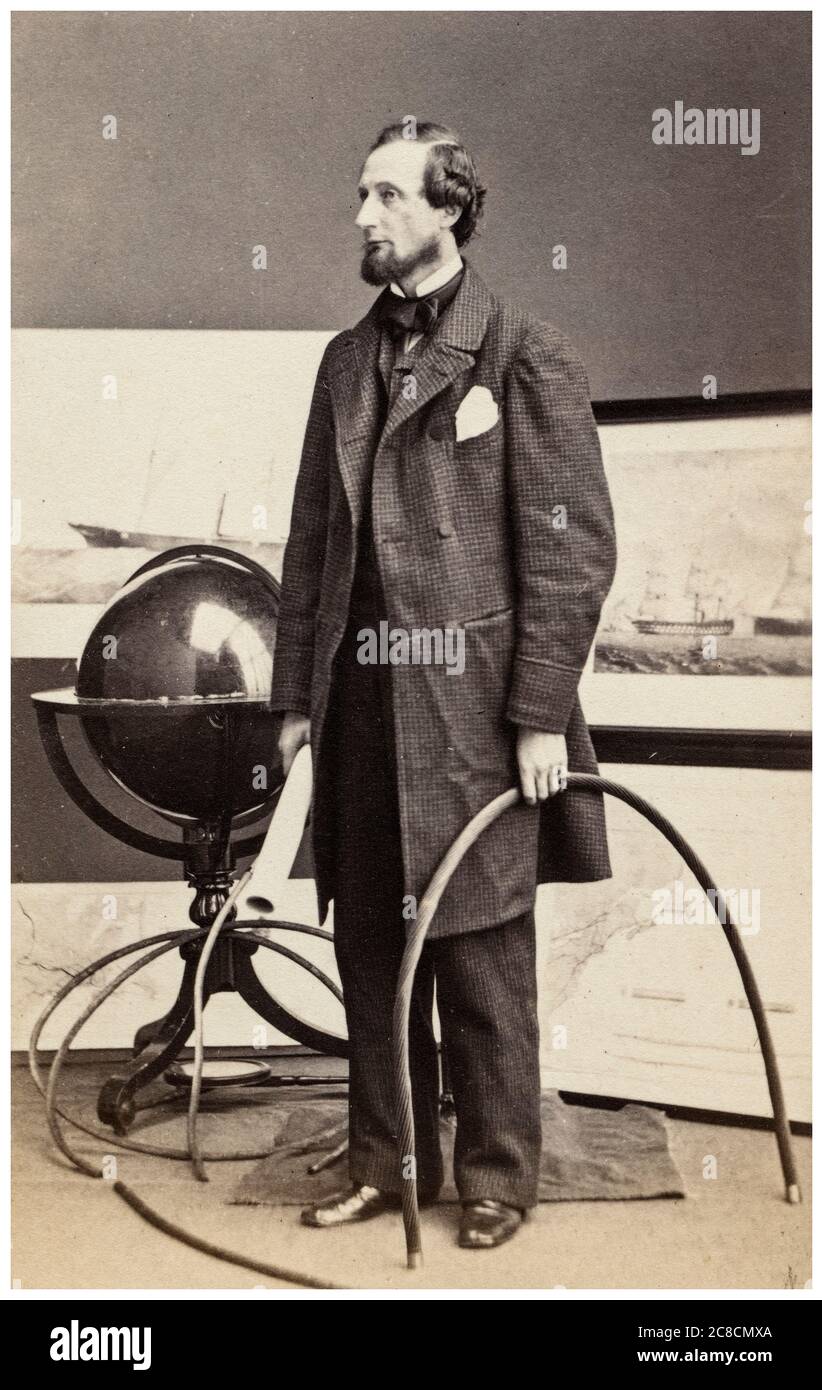 Cyrus West Field (1819-1892), American financier of the Atlantic Telegraph Company who laid the first Transatlantic Telegraph Cable in 1858, portrait photograph by Charles DeForest Fredricks, circa 1863 Stock Photohttps://www.alamy.com/image-license-details/?v=1https://www.alamy.com/cyrus-west-field-1819-1892-american-financier-of-the-atlantic-telegraph-company-who-laid-the-first-transatlantic-telegraph-cable-in-1858-portrait-photograph-by-charles-deforest-fredricks-circa-1863-image366614818.html
Cyrus West Field (1819-1892), American financier of the Atlantic Telegraph Company who laid the first Transatlantic Telegraph Cable in 1858, portrait photograph by Charles DeForest Fredricks, circa 1863 Stock Photohttps://www.alamy.com/image-license-details/?v=1https://www.alamy.com/cyrus-west-field-1819-1892-american-financier-of-the-atlantic-telegraph-company-who-laid-the-first-transatlantic-telegraph-cable-in-1858-portrait-photograph-by-charles-deforest-fredricks-circa-1863-image366614818.htmlRM2C8CMXA–Cyrus West Field (1819-1892), American financier of the Atlantic Telegraph Company who laid the first Transatlantic Telegraph Cable in 1858, portrait photograph by Charles DeForest Fredricks, circa 1863
 THOMAS ECKERT (1825-1910) US army officer, politician and Western Union executive Stock Photohttps://www.alamy.com/image-license-details/?v=1https://www.alamy.com/stock-photo-thomas-eckert-1825-1910-us-army-officer-politician-and-western-union-44160145.html
THOMAS ECKERT (1825-1910) US army officer, politician and Western Union executive Stock Photohttps://www.alamy.com/image-license-details/?v=1https://www.alamy.com/stock-photo-thomas-eckert-1825-1910-us-army-officer-politician-and-western-union-44160145.htmlRMCFRJM1–THOMAS ECKERT (1825-1910) US army officer, politician and Western Union executive
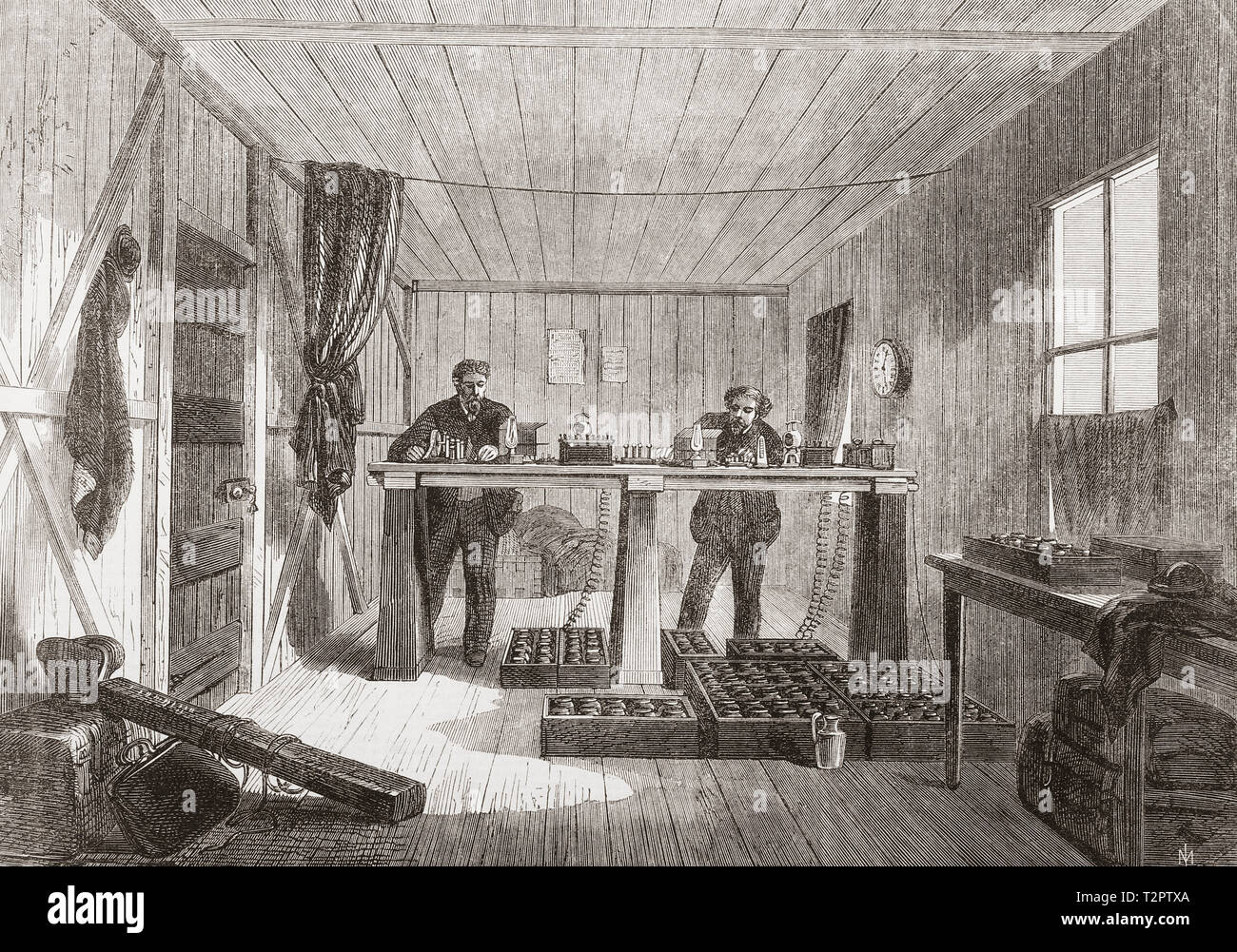 The laying of the Atlantic Telegraph cable. Receiving messages from The Great Eastern in the instrument room in the telegraph house at Foilhommerum Bay, Valentia Island, Ireland. From The Illustrated London News, published 1865. Stock Photohttps://www.alamy.com/image-license-details/?v=1https://www.alamy.com/the-laying-of-the-atlantic-telegraph-cable-receiving-messages-from-the-great-eastern-in-the-instrument-room-in-the-telegraph-house-at-foilhommerum-bay-valentia-island-ireland-from-the-illustrated-london-news-published-1865-image242676962.html
The laying of the Atlantic Telegraph cable. Receiving messages from The Great Eastern in the instrument room in the telegraph house at Foilhommerum Bay, Valentia Island, Ireland. From The Illustrated London News, published 1865. Stock Photohttps://www.alamy.com/image-license-details/?v=1https://www.alamy.com/the-laying-of-the-atlantic-telegraph-cable-receiving-messages-from-the-great-eastern-in-the-instrument-room-in-the-telegraph-house-at-foilhommerum-bay-valentia-island-ireland-from-the-illustrated-london-news-published-1865-image242676962.htmlRMT2PTXA–The laying of the Atlantic Telegraph cable. Receiving messages from The Great Eastern in the instrument room in the telegraph house at Foilhommerum Bay, Valentia Island, Ireland. From The Illustrated London News, published 1865.
 September 8th at Heart's Content, the day of the successful termination of the work of laying, recovering, completing and testing the Atlantic Telegraph Cables of 1865 and 1866, 1866. Stock Photohttps://www.alamy.com/image-license-details/?v=1https://www.alamy.com/september-8th-at-hearts-content-the-day-of-the-successful-termination-of-the-work-of-laying-recovering-completing-and-testing-the-atlantic-telegraph-cables-of-1865-and-1866-1866-image365762939.html
September 8th at Heart's Content, the day of the successful termination of the work of laying, recovering, completing and testing the Atlantic Telegraph Cables of 1865 and 1866, 1866. Stock Photohttps://www.alamy.com/image-license-details/?v=1https://www.alamy.com/september-8th-at-hearts-content-the-day-of-the-successful-termination-of-the-work-of-laying-recovering-completing-and-testing-the-atlantic-telegraph-cables-of-1865-and-1866-1866-image365762939.htmlRM2C71XA3–September 8th at Heart's Content, the day of the successful termination of the work of laying, recovering, completing and testing the Atlantic Telegraph Cables of 1865 and 1866, 1866.
 Art inspired by Coiling the Cable in the Large Tanks at the Works of the Telegraph Construction and Maintenance Company of Greenwich, 1865, 1865, Watercolor over graphite with touches of gouache, Sheet: 7 3/16 × 10 1/2 in. (18.2 × 26.6 cm), Drawings, Robert Charles Dudley (British, Classic works modernized by Artotop with a splash of modernity. Shapes, color and value, eye-catching visual impact on art. Emotions through freedom of artworks in a contemporary way. A timeless message pursuing a wildly creative new direction. Artists turning to the digital medium and creating the Artotop NFT Stock Photohttps://www.alamy.com/image-license-details/?v=1https://www.alamy.com/art-inspired-by-coiling-the-cable-in-the-large-tanks-at-the-works-of-the-telegraph-construction-and-maintenance-company-of-greenwich-1865-1865-watercolor-over-graphite-with-touches-of-gouache-sheet-7-316-10-12-in-182-266-cm-drawings-robert-charles-dudley-british-classic-works-modernized-by-artotop-with-a-splash-of-modernity-shapes-color-and-value-eye-catching-visual-impact-on-art-emotions-through-freedom-of-artworks-in-a-contemporary-way-a-timeless-message-pursuing-a-wildly-creative-new-direction-artists-turning-to-the-digital-medium-and-creating-the-artotop-nft-image462978797.html
Art inspired by Coiling the Cable in the Large Tanks at the Works of the Telegraph Construction and Maintenance Company of Greenwich, 1865, 1865, Watercolor over graphite with touches of gouache, Sheet: 7 3/16 × 10 1/2 in. (18.2 × 26.6 cm), Drawings, Robert Charles Dudley (British, Classic works modernized by Artotop with a splash of modernity. Shapes, color and value, eye-catching visual impact on art. Emotions through freedom of artworks in a contemporary way. A timeless message pursuing a wildly creative new direction. Artists turning to the digital medium and creating the Artotop NFT Stock Photohttps://www.alamy.com/image-license-details/?v=1https://www.alamy.com/art-inspired-by-coiling-the-cable-in-the-large-tanks-at-the-works-of-the-telegraph-construction-and-maintenance-company-of-greenwich-1865-1865-watercolor-over-graphite-with-touches-of-gouache-sheet-7-316-10-12-in-182-266-cm-drawings-robert-charles-dudley-british-classic-works-modernized-by-artotop-with-a-splash-of-modernity-shapes-color-and-value-eye-catching-visual-impact-on-art-emotions-through-freedom-of-artworks-in-a-contemporary-way-a-timeless-message-pursuing-a-wildly-creative-new-direction-artists-turning-to-the-digital-medium-and-creating-the-artotop-nft-image462978797.htmlRF2HW6E51–Art inspired by Coiling the Cable in the Large Tanks at the Works of the Telegraph Construction and Maintenance Company of Greenwich, 1865, 1865, Watercolor over graphite with touches of gouache, Sheet: 7 3/16 × 10 1/2 in. (18.2 × 26.6 cm), Drawings, Robert Charles Dudley (British, Classic works modernized by Artotop with a splash of modernity. Shapes, color and value, eye-catching visual impact on art. Emotions through freedom of artworks in a contemporary way. A timeless message pursuing a wildly creative new direction. Artists turning to the digital medium and creating the Artotop NFT
 Awaiting a transatlantic telegraph reply, 1866. Ilustration by Robert Charles Dudley (British, 1826-1909). One of the 19th century's great technological achievements was to lay a telegraphic cable beneath the Atlantic, allowing messages to speed back and forth between North America and Europe in minutes, rather than ten or twelve days by steamer. An initially successful attempt in 1858, led by Cyrus W. Field and financed by the Atlantic Telegraph Company, failed after three weeks. Stock Photohttps://www.alamy.com/image-license-details/?v=1https://www.alamy.com/awaiting-a-transatlantic-telegraph-reply-1866-ilustration-by-robert-charles-dudley-british-1826-1909-one-of-the-19th-centurys-great-technological-achievements-was-to-lay-a-telegraphic-cable-beneath-the-atlantic-allowing-messages-to-speed-back-and-forth-between-north-america-and-europe-in-minutes-rather-than-ten-or-twelve-days-by-steamer-an-initially-successful-attempt-in-1858-led-by-cyrus-w-field-and-financed-by-the-atlantic-telegraph-company-failed-after-three-weeks-image246587741.html
Awaiting a transatlantic telegraph reply, 1866. Ilustration by Robert Charles Dudley (British, 1826-1909). One of the 19th century's great technological achievements was to lay a telegraphic cable beneath the Atlantic, allowing messages to speed back and forth between North America and Europe in minutes, rather than ten or twelve days by steamer. An initially successful attempt in 1858, led by Cyrus W. Field and financed by the Atlantic Telegraph Company, failed after three weeks. Stock Photohttps://www.alamy.com/image-license-details/?v=1https://www.alamy.com/awaiting-a-transatlantic-telegraph-reply-1866-ilustration-by-robert-charles-dudley-british-1826-1909-one-of-the-19th-centurys-great-technological-achievements-was-to-lay-a-telegraphic-cable-beneath-the-atlantic-allowing-messages-to-speed-back-and-forth-between-north-america-and-europe-in-minutes-rather-than-ten-or-twelve-days-by-steamer-an-initially-successful-attempt-in-1858-led-by-cyrus-w-field-and-financed-by-the-atlantic-telegraph-company-failed-after-three-weeks-image246587741.htmlRMT95151–Awaiting a transatlantic telegraph reply, 1866. Ilustration by Robert Charles Dudley (British, 1826-1909). One of the 19th century's great technological achievements was to lay a telegraphic cable beneath the Atlantic, allowing messages to speed back and forth between North America and Europe in minutes, rather than ten or twelve days by steamer. An initially successful attempt in 1858, led by Cyrus W. Field and financed by the Atlantic Telegraph Company, failed after three weeks.
 Coiling the Cable in the Large Tanks at the Works of the Telegraph Construction and Maintenance Company of Greenwich, 1865 Stock Photohttps://www.alamy.com/image-license-details/?v=1https://www.alamy.com/stock-image-coiling-the-cable-in-the-large-tanks-at-the-works-of-the-telegraph-162454588.html
Coiling the Cable in the Large Tanks at the Works of the Telegraph Construction and Maintenance Company of Greenwich, 1865 Stock Photohttps://www.alamy.com/image-license-details/?v=1https://www.alamy.com/stock-image-coiling-the-cable-in-the-large-tanks-at-the-works-of-the-telegraph-162454588.htmlRMKC8CDG–Coiling the Cable in the Large Tanks at the Works of the Telegraph Construction and Maintenance Company of Greenwich, 1865
 Werner von Siemens 1816-1892 German inventor and electrical entrepreneur whose company executed major feats of industrial technology including laying trans-Atlantic cables and building the Indo-European telegraph line from London to Calcutta. Portrait (BSLOC 2010 18 165) Stock Photohttps://www.alamy.com/image-license-details/?v=1https://www.alamy.com/stock-photo-werner-von-siemens-1816-1892-german-inventor-and-electrical-entrepreneur-38134238.html
Werner von Siemens 1816-1892 German inventor and electrical entrepreneur whose company executed major feats of industrial technology including laying trans-Atlantic cables and building the Indo-European telegraph line from London to Calcutta. Portrait (BSLOC 2010 18 165) Stock Photohttps://www.alamy.com/image-license-details/?v=1https://www.alamy.com/stock-photo-werner-von-siemens-1816-1892-german-inventor-and-electrical-entrepreneur-38134238.htmlRMC614H2–Werner von Siemens 1816-1892 German inventor and electrical entrepreneur whose company executed major feats of industrial technology including laying trans-Atlantic cables and building the Indo-European telegraph line from London to Calcutta. Portrait (BSLOC 2010 18 165)
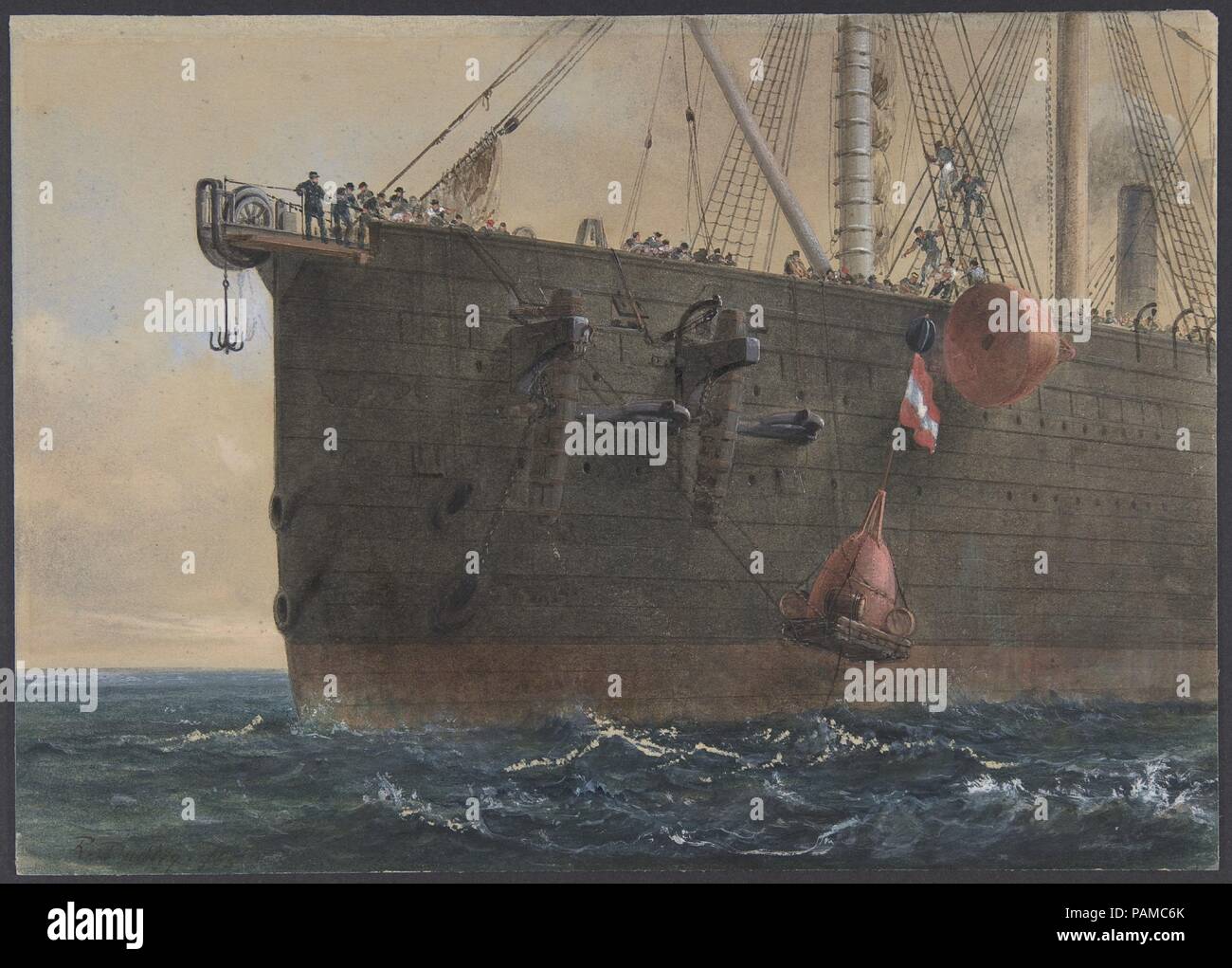 In the Bows of the Great Eastern: The Cable Broken and Lost, Preparing to Grapple, August 2nd, 1865. Artist: Robert Charles Dudley (British, 1826-1909). Dimensions: Sheet: 7 1/8 in. × 10 in. (18.1 × 25.4 cm). Date: 1865. One of the 19th century's great technological achievements was to lay a telegraphic cable beneath the Atlantic, allowing messages to speed back and forth between North America and Europe in minutes, rather than ten or twelve days by steamer. An initially successful attempt in 1858, led by Cyrus W. Field and financed by the Atlantic Telegraph Company, failed after three weeks. Stock Photohttps://www.alamy.com/image-license-details/?v=1https://www.alamy.com/in-the-bows-of-the-great-eastern-the-cable-broken-and-lost-preparing-to-grapple-august-2nd-1865-artist-robert-charles-dudley-british-1826-1909-dimensions-sheet-7-18-in-10-in-181-254-cm-date-1865-one-of-the-19th-centurys-great-technological-achievements-was-to-lay-a-telegraphic-cable-beneath-the-atlantic-allowing-messages-to-speed-back-and-forth-between-north-america-and-europe-in-minutes-rather-than-ten-or-twelve-days-by-steamer-an-initially-successful-attempt-in-1858-led-by-cyrus-w-field-and-financed-by-the-atlantic-telegraph-company-failed-after-three-weeks-image213119611.html
In the Bows of the Great Eastern: The Cable Broken and Lost, Preparing to Grapple, August 2nd, 1865. Artist: Robert Charles Dudley (British, 1826-1909). Dimensions: Sheet: 7 1/8 in. × 10 in. (18.1 × 25.4 cm). Date: 1865. One of the 19th century's great technological achievements was to lay a telegraphic cable beneath the Atlantic, allowing messages to speed back and forth between North America and Europe in minutes, rather than ten or twelve days by steamer. An initially successful attempt in 1858, led by Cyrus W. Field and financed by the Atlantic Telegraph Company, failed after three weeks. Stock Photohttps://www.alamy.com/image-license-details/?v=1https://www.alamy.com/in-the-bows-of-the-great-eastern-the-cable-broken-and-lost-preparing-to-grapple-august-2nd-1865-artist-robert-charles-dudley-british-1826-1909-dimensions-sheet-7-18-in-10-in-181-254-cm-date-1865-one-of-the-19th-centurys-great-technological-achievements-was-to-lay-a-telegraphic-cable-beneath-the-atlantic-allowing-messages-to-speed-back-and-forth-between-north-america-and-europe-in-minutes-rather-than-ten-or-twelve-days-by-steamer-an-initially-successful-attempt-in-1858-led-by-cyrus-w-field-and-financed-by-the-atlantic-telegraph-company-failed-after-three-weeks-image213119611.htmlRMPAMC6K–In the Bows of the Great Eastern: The Cable Broken and Lost, Preparing to Grapple, August 2nd, 1865. Artist: Robert Charles Dudley (British, 1826-1909). Dimensions: Sheet: 7 1/8 in. × 10 in. (18.1 × 25.4 cm). Date: 1865. One of the 19th century's great technological achievements was to lay a telegraphic cable beneath the Atlantic, allowing messages to speed back and forth between North America and Europe in minutes, rather than ten or twelve days by steamer. An initially successful attempt in 1858, led by Cyrus W. Field and financed by the Atlantic Telegraph Company, failed after three weeks.
 SECOND FLOOR, THIRD ROOM FROM FRONT, NORTH and EAST WALLS, SHOWING WINDOW ONTO STAIR HALL - Telegram Building, 227 Walnut Street, Harrisburg, Dauphin County, PA; Smith, John C; Warner, James H; Place, James M; Stark Brothers; Atlantic Refining Company; Dauphin County Telephone Company; Independent Telephone Association; Pennsylvania State Telephone and Traffic Association; Western Union Telegraph Office; Bowie, John R, project manager; Bounds, A Pierce, photographer; Richman, Irwin, historian Stock Photohttps://www.alamy.com/image-license-details/?v=1https://www.alamy.com/second-floor-third-room-from-front-north-and-east-walls-showing-window-onto-stair-hall-telegram-building-227-walnut-street-harrisburg-dauphin-county-pa-smith-john-c-warner-james-h-place-james-m-stark-brothers-atlantic-refining-company-dauphin-county-telephone-company-independent-telephone-association-pennsylvania-state-telephone-and-traffic-association-western-union-telegraph-office-bowie-john-r-project-manager-bounds-a-pierce-photographer-richman-irwin-historian-image256700508.html
SECOND FLOOR, THIRD ROOM FROM FRONT, NORTH and EAST WALLS, SHOWING WINDOW ONTO STAIR HALL - Telegram Building, 227 Walnut Street, Harrisburg, Dauphin County, PA; Smith, John C; Warner, James H; Place, James M; Stark Brothers; Atlantic Refining Company; Dauphin County Telephone Company; Independent Telephone Association; Pennsylvania State Telephone and Traffic Association; Western Union Telegraph Office; Bowie, John R, project manager; Bounds, A Pierce, photographer; Richman, Irwin, historian Stock Photohttps://www.alamy.com/image-license-details/?v=1https://www.alamy.com/second-floor-third-room-from-front-north-and-east-walls-showing-window-onto-stair-hall-telegram-building-227-walnut-street-harrisburg-dauphin-county-pa-smith-john-c-warner-james-h-place-james-m-stark-brothers-atlantic-refining-company-dauphin-county-telephone-company-independent-telephone-association-pennsylvania-state-telephone-and-traffic-association-western-union-telegraph-office-bowie-john-r-project-manager-bounds-a-pierce-photographer-richman-irwin-historian-image256700508.htmlRMTWHM38–SECOND FLOOR, THIRD ROOM FROM FRONT, NORTH and EAST WALLS, SHOWING WINDOW ONTO STAIR HALL - Telegram Building, 227 Walnut Street, Harrisburg, Dauphin County, PA; Smith, John C; Warner, James H; Place, James M; Stark Brothers; Atlantic Refining Company; Dauphin County Telephone Company; Independent Telephone Association; Pennsylvania State Telephone and Traffic Association; Western Union Telegraph Office; Bowie, John R, project manager; Bounds, A Pierce, photographer; Richman, Irwin, historian
 Marker of the former Maritime Telegraph and Telephone Company (MT&T) on a telephone pole in downtown Halifax, Nova Scotia, Canada Stock Photohttps://www.alamy.com/image-license-details/?v=1https://www.alamy.com/marker-of-the-former-maritime-telegraph-and-telephone-company-mtt-on-a-telephone-pole-in-downtown-halifax-nova-scotia-canada-image554096657.html
Marker of the former Maritime Telegraph and Telephone Company (MT&T) on a telephone pole in downtown Halifax, Nova Scotia, Canada Stock Photohttps://www.alamy.com/image-license-details/?v=1https://www.alamy.com/marker-of-the-former-maritime-telegraph-and-telephone-company-mtt-on-a-telephone-pole-in-downtown-halifax-nova-scotia-canada-image554096657.htmlRM2R5D7X9–Marker of the former Maritime Telegraph and Telephone Company (MT&T) on a telephone pole in downtown Halifax, Nova Scotia, Canada
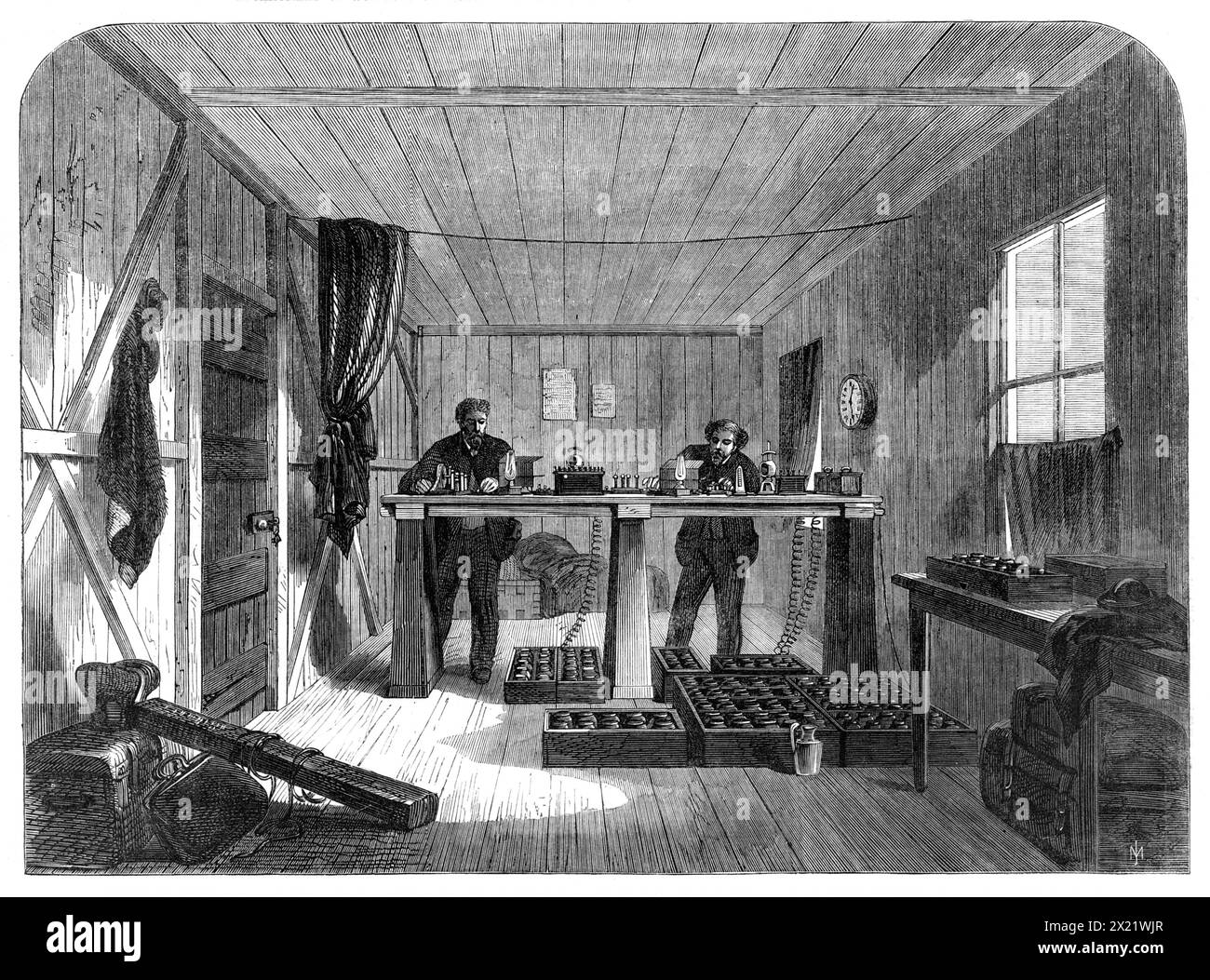 Laying of the Atlantic Telegraph Cable: receiving messages from the Great Eastern in the instrument-room of the Telegraph House at Foilhommerum, Valencia, 1865. Engraving from a sketch by Robert Dudley showing '...the reception of the telegrams, and the interior of the instrument-room at the station, which will, in fact, remain in a similar state until the whole ocean cable is successfully laid, when the line will be handed over by the Construction and Maintenance Company to the Atlantic Telegraph Company, and the instruments (Professor Thomson's) now used, and which are correctly shown in our Stock Photohttps://www.alamy.com/image-license-details/?v=1https://www.alamy.com/laying-of-the-atlantic-telegraph-cable-receiving-messages-from-the-great-eastern-in-the-instrument-room-of-the-telegraph-house-at-foilhommerum-valencia-1865-engraving-from-a-sketch-by-robert-dudley-showing-the-reception-of-the-telegrams-and-the-interior-of-the-instrument-room-at-the-station-which-will-in-fact-remain-in-a-similar-state-until-the-whole-ocean-cable-is-successfully-laid-when-the-line-will-be-handed-over-by-the-construction-and-maintenance-company-to-the-atlantic-telegraph-company-and-the-instruments-professor-thomsons-now-used-and-which-are-correctly-shown-in-our-image603634271.html
Laying of the Atlantic Telegraph Cable: receiving messages from the Great Eastern in the instrument-room of the Telegraph House at Foilhommerum, Valencia, 1865. Engraving from a sketch by Robert Dudley showing '...the reception of the telegrams, and the interior of the instrument-room at the station, which will, in fact, remain in a similar state until the whole ocean cable is successfully laid, when the line will be handed over by the Construction and Maintenance Company to the Atlantic Telegraph Company, and the instruments (Professor Thomson's) now used, and which are correctly shown in our Stock Photohttps://www.alamy.com/image-license-details/?v=1https://www.alamy.com/laying-of-the-atlantic-telegraph-cable-receiving-messages-from-the-great-eastern-in-the-instrument-room-of-the-telegraph-house-at-foilhommerum-valencia-1865-engraving-from-a-sketch-by-robert-dudley-showing-the-reception-of-the-telegrams-and-the-interior-of-the-instrument-room-at-the-station-which-will-in-fact-remain-in-a-similar-state-until-the-whole-ocean-cable-is-successfully-laid-when-the-line-will-be-handed-over-by-the-construction-and-maintenance-company-to-the-atlantic-telegraph-company-and-the-instruments-professor-thomsons-now-used-and-which-are-correctly-shown-in-our-image603634271.htmlRM2X21WJR–Laying of the Atlantic Telegraph Cable: receiving messages from the Great Eastern in the instrument-room of the Telegraph House at Foilhommerum, Valencia, 1865. Engraving from a sketch by Robert Dudley showing '...the reception of the telegrams, and the interior of the instrument-room at the station, which will, in fact, remain in a similar state until the whole ocean cable is successfully laid, when the line will be handed over by the Construction and Maintenance Company to the Atlantic Telegraph Company, and the instruments (Professor Thomson's) now used, and which are correctly shown in our
 Cyrus West Field, American businessman and financier, circa 1885 Stock Photohttps://www.alamy.com/image-license-details/?v=1https://www.alamy.com/cyrus-west-field-american-businessman-and-financier-circa-1885-image60908573.html
Cyrus West Field, American businessman and financier, circa 1885 Stock Photohttps://www.alamy.com/image-license-details/?v=1https://www.alamy.com/cyrus-west-field-american-businessman-and-financier-circa-1885-image60908573.htmlRMDF2HE5–Cyrus West Field, American businessman and financier, circa 1885
 The Reels of Gutta-percha Covered Conducting Wire Conveyed into Tanks at the Works of the Telegraph Construction and Maintenance Company, at Greenwich 1865–66 Robert Charles Dudley British One of the 19th century's great technological achievements was to lay a telegraphic cable beneath the Atlantic, allowing messages to speed back and forth between North America and Europe in minutes, rather than ten or twelve days by steamer. An initially successful attempt in 1858, led by Cyrus W. Field and financed by the Atlantic Telegraph Company, failed after three weeks. Two working cables were finally Stock Photohttps://www.alamy.com/image-license-details/?v=1https://www.alamy.com/the-reels-of-gutta-percha-covered-conducting-wire-conveyed-into-tanks-at-the-works-of-the-telegraph-construction-and-maintenance-company-at-greenwich-186566-robert-charles-dudley-british-one-of-the-19th-centurys-great-technological-achievements-was-to-lay-a-telegraphic-cable-beneath-the-atlantic-allowing-messages-to-speed-back-and-forth-between-north-america-and-europe-in-minutes-rather-than-ten-or-twelve-days-by-steamer-an-initially-successful-attempt-in-1858-led-by-cyrus-w-field-and-financed-by-the-atlantic-telegraph-company-failed-after-three-weeks-two-working-cables-were-finally-image458270221.html
The Reels of Gutta-percha Covered Conducting Wire Conveyed into Tanks at the Works of the Telegraph Construction and Maintenance Company, at Greenwich 1865–66 Robert Charles Dudley British One of the 19th century's great technological achievements was to lay a telegraphic cable beneath the Atlantic, allowing messages to speed back and forth between North America and Europe in minutes, rather than ten or twelve days by steamer. An initially successful attempt in 1858, led by Cyrus W. Field and financed by the Atlantic Telegraph Company, failed after three weeks. Two working cables were finally Stock Photohttps://www.alamy.com/image-license-details/?v=1https://www.alamy.com/the-reels-of-gutta-percha-covered-conducting-wire-conveyed-into-tanks-at-the-works-of-the-telegraph-construction-and-maintenance-company-at-greenwich-186566-robert-charles-dudley-british-one-of-the-19th-centurys-great-technological-achievements-was-to-lay-a-telegraphic-cable-beneath-the-atlantic-allowing-messages-to-speed-back-and-forth-between-north-america-and-europe-in-minutes-rather-than-ten-or-twelve-days-by-steamer-an-initially-successful-attempt-in-1858-led-by-cyrus-w-field-and-financed-by-the-atlantic-telegraph-company-failed-after-three-weeks-two-working-cables-were-finally-image458270221.htmlRM2HHG09H–The Reels of Gutta-percha Covered Conducting Wire Conveyed into Tanks at the Works of the Telegraph Construction and Maintenance Company, at Greenwich 1865–66 Robert Charles Dudley British One of the 19th century's great technological achievements was to lay a telegraphic cable beneath the Atlantic, allowing messages to speed back and forth between North America and Europe in minutes, rather than ten or twelve days by steamer. An initially successful attempt in 1858, led by Cyrus W. Field and financed by the Atlantic Telegraph Company, failed after three weeks. Two working cables were finally
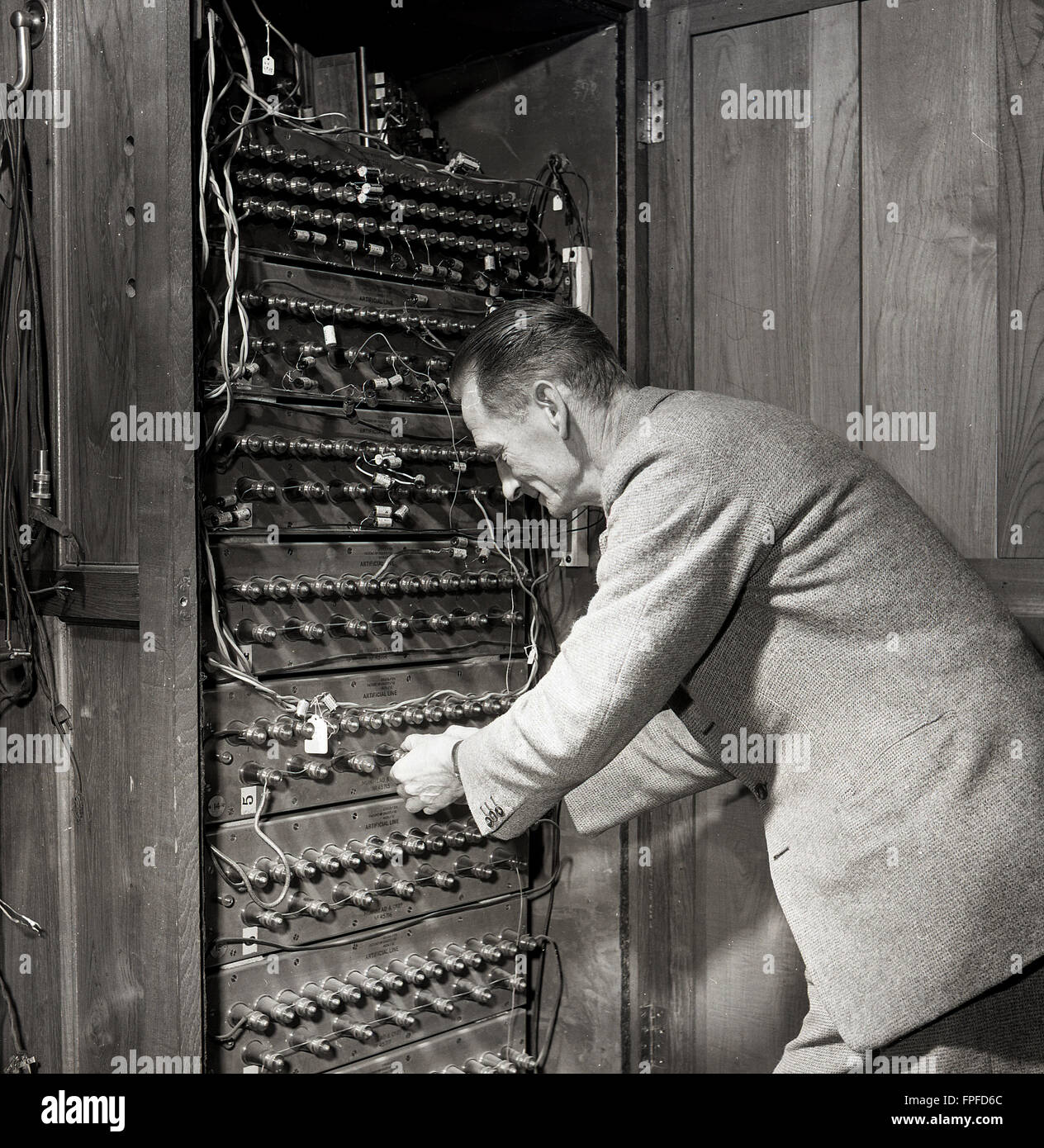 1950s historical, a man moving dials on a control panel or circuit board at the transatlantic cable station in Waterville, Co. Kerry, Ireland. once home to the one of the largest cable stations in the world. The first successful transatlantic telegraph message was transmitted through there in 1884, after the Commerical Cable Co had laid two cables across the Atlantic ocean connecting Canada, Britain and France, via Waterville, a total of 2,399 miles of cable. Stock Photohttps://www.alamy.com/image-license-details/?v=1https://www.alamy.com/stock-photo-1950s-historical-a-man-moving-dials-on-a-control-panel-or-circuit-99913924.html
1950s historical, a man moving dials on a control panel or circuit board at the transatlantic cable station in Waterville, Co. Kerry, Ireland. once home to the one of the largest cable stations in the world. The first successful transatlantic telegraph message was transmitted through there in 1884, after the Commerical Cable Co had laid two cables across the Atlantic ocean connecting Canada, Britain and France, via Waterville, a total of 2,399 miles of cable. Stock Photohttps://www.alamy.com/image-license-details/?v=1https://www.alamy.com/stock-photo-1950s-historical-a-man-moving-dials-on-a-control-panel-or-circuit-99913924.htmlRMFPFD6C–1950s historical, a man moving dials on a control panel or circuit board at the transatlantic cable station in Waterville, Co. Kerry, Ireland. once home to the one of the largest cable stations in the world. The first successful transatlantic telegraph message was transmitted through there in 1884, after the Commerical Cable Co had laid two cables across the Atlantic ocean connecting Canada, Britain and France, via Waterville, a total of 2,399 miles of cable.
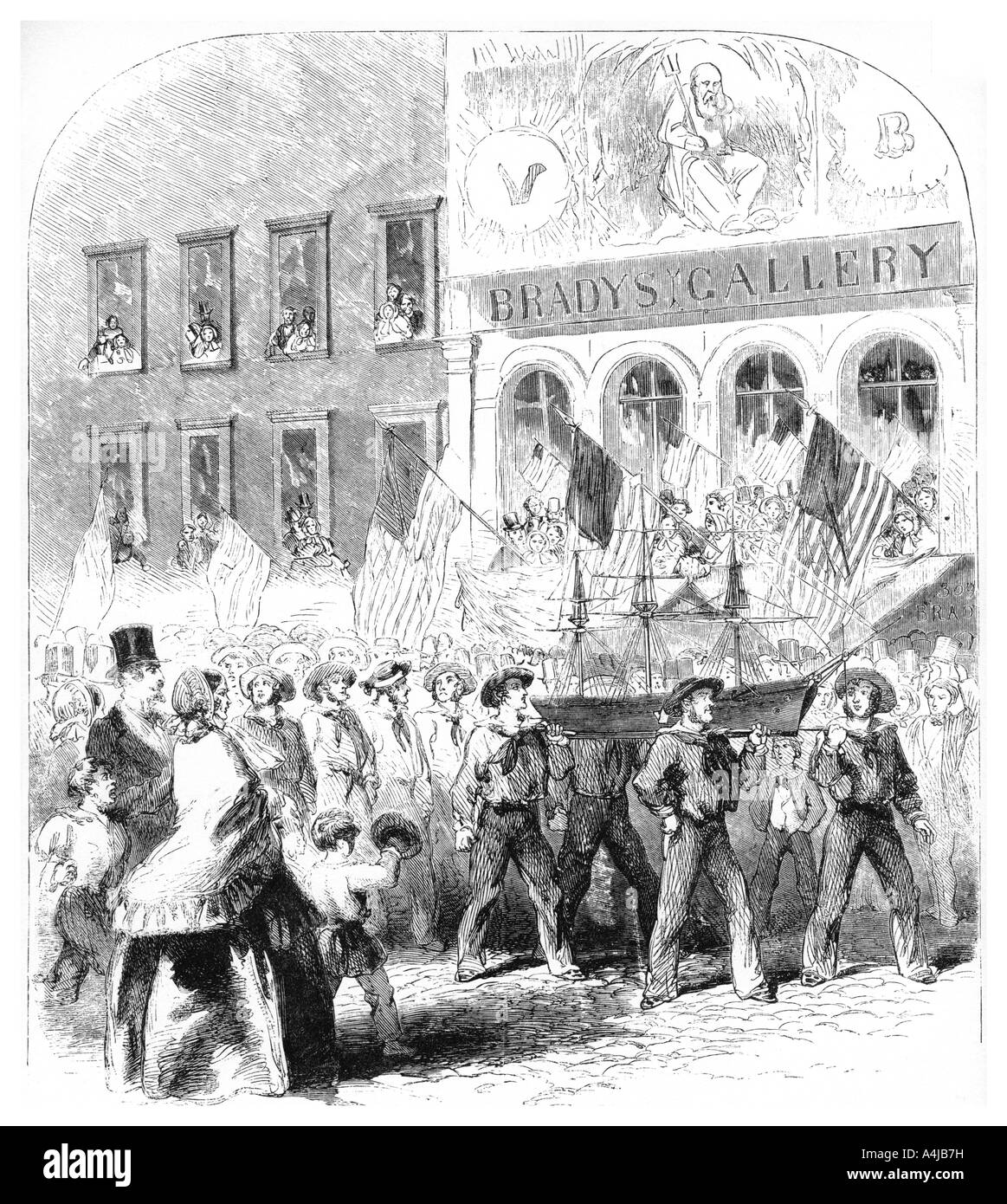 'The Atlantic Telegraph Cable, Parade', c1858. Artist: Unknown Stock Photohttps://www.alamy.com/image-license-details/?v=1https://www.alamy.com/stock-photo-the-atlantic-telegraph-cable-parade-c1858-artist-unknown-11061316.html
'The Atlantic Telegraph Cable, Parade', c1858. Artist: Unknown Stock Photohttps://www.alamy.com/image-license-details/?v=1https://www.alamy.com/stock-photo-the-atlantic-telegraph-cable-parade-c1858-artist-unknown-11061316.htmlRMA4JB7H–'The Atlantic Telegraph Cable, Parade', c1858. Artist: Unknown
 The Agamemnon in a storm Stock Photohttps://www.alamy.com/image-license-details/?v=1https://www.alamy.com/the-agamemnon-in-a-storm-image501460335.html
The Agamemnon in a storm Stock Photohttps://www.alamy.com/image-license-details/?v=1https://www.alamy.com/the-agamemnon-in-a-storm-image501460335.htmlRM2M3RDNK–The Agamemnon in a storm
 Laying of the Atlantic Telegraph Cable: encampment of workmen on the road between Killarney and Valencia, 1865. Engraving from a sketch by Robert Dudley. 'The road to Valencia, either from Killarney or from Kenmare and Glengariff, at the head of Bantry Bay, was travelled not without some delays by the few persons from London who, having made the best of their way to see the landing of the cable, succeeded in getting there on the morning of Saturday week. The local staff of the Telegraph Construction Company had been engaged for some weeks past in various preparations on the spot. An encampment Stock Photohttps://www.alamy.com/image-license-details/?v=1https://www.alamy.com/laying-of-the-atlantic-telegraph-cable-encampment-of-workmen-on-the-road-between-killarney-and-valencia-1865-engraving-from-a-sketch-by-robert-dudley-the-road-to-valencia-either-from-killarney-or-from-kenmare-and-glengariff-at-the-head-of-bantry-bay-was-travelled-not-without-some-delays-by-the-few-persons-from-london-who-having-made-the-best-of-their-way-to-see-the-landing-of-the-cable-succeeded-in-getting-there-on-the-morning-of-saturday-week-the-local-staff-of-the-telegraph-construction-company-had-been-engaged-for-some-weeks-past-in-various-preparations-on-the-spot-an-encampment-image603634277.html
Laying of the Atlantic Telegraph Cable: encampment of workmen on the road between Killarney and Valencia, 1865. Engraving from a sketch by Robert Dudley. 'The road to Valencia, either from Killarney or from Kenmare and Glengariff, at the head of Bantry Bay, was travelled not without some delays by the few persons from London who, having made the best of their way to see the landing of the cable, succeeded in getting there on the morning of Saturday week. The local staff of the Telegraph Construction Company had been engaged for some weeks past in various preparations on the spot. An encampment Stock Photohttps://www.alamy.com/image-license-details/?v=1https://www.alamy.com/laying-of-the-atlantic-telegraph-cable-encampment-of-workmen-on-the-road-between-killarney-and-valencia-1865-engraving-from-a-sketch-by-robert-dudley-the-road-to-valencia-either-from-killarney-or-from-kenmare-and-glengariff-at-the-head-of-bantry-bay-was-travelled-not-without-some-delays-by-the-few-persons-from-london-who-having-made-the-best-of-their-way-to-see-the-landing-of-the-cable-succeeded-in-getting-there-on-the-morning-of-saturday-week-the-local-staff-of-the-telegraph-construction-company-had-been-engaged-for-some-weeks-past-in-various-preparations-on-the-spot-an-encampment-image603634277.htmlRM2X21WK1–Laying of the Atlantic Telegraph Cable: encampment of workmen on the road between Killarney and Valencia, 1865. Engraving from a sketch by Robert Dudley. 'The road to Valencia, either from Killarney or from Kenmare and Glengariff, at the head of Bantry Bay, was travelled not without some delays by the few persons from London who, having made the best of their way to see the landing of the cable, succeeded in getting there on the morning of Saturday week. The local staff of the Telegraph Construction Company had been engaged for some weeks past in various preparations on the spot. An encampment
 Allegorical scene showing Neptune with a trident in foreground, and lion representing Great Britain holding one end of the Atlantic cable and eagle representing the United States holding the other end of the cable, with ocean between them and cities behind them. Includes portrait of the inventor, Cyrus Field, at top center. Stock Photohttps://www.alamy.com/image-license-details/?v=1https://www.alamy.com/allegorical-scene-showing-neptune-with-a-trident-in-foreground-and-lion-representing-great-britain-holding-one-end-of-the-atlantic-cable-and-eagle-representing-the-united-states-holding-the-other-end-of-the-cable-with-ocean-between-them-and-cities-behind-them-includes-portrait-of-the-inventor-cyrus-field-at-top-center-image387337119.html
Allegorical scene showing Neptune with a trident in foreground, and lion representing Great Britain holding one end of the Atlantic cable and eagle representing the United States holding the other end of the cable, with ocean between them and cities behind them. Includes portrait of the inventor, Cyrus Field, at top center. Stock Photohttps://www.alamy.com/image-license-details/?v=1https://www.alamy.com/allegorical-scene-showing-neptune-with-a-trident-in-foreground-and-lion-representing-great-britain-holding-one-end-of-the-atlantic-cable-and-eagle-representing-the-united-states-holding-the-other-end-of-the-cable-with-ocean-between-them-and-cities-behind-them-includes-portrait-of-the-inventor-cyrus-field-at-top-center-image387337119.htmlRM2DE4MCF–Allegorical scene showing Neptune with a trident in foreground, and lion representing Great Britain holding one end of the Atlantic cable and eagle representing the United States holding the other end of the cable, with ocean between them and cities behind them. Includes portrait of the inventor, Cyrus Field, at top center.
 Map of Trinity Bay, Newfoundland, the Telegraph Station of the Transatlantic Cable across the Atlantic Ocean, 1858 Stock Photohttps://www.alamy.com/image-license-details/?v=1https://www.alamy.com/map-of-trinity-bay-newfoundland-the-telegraph-station-of-the-transatlantic-cable-across-the-atlantic-ocean-1858-image366614902.html
Map of Trinity Bay, Newfoundland, the Telegraph Station of the Transatlantic Cable across the Atlantic Ocean, 1858 Stock Photohttps://www.alamy.com/image-license-details/?v=1https://www.alamy.com/map-of-trinity-bay-newfoundland-the-telegraph-station-of-the-transatlantic-cable-across-the-atlantic-ocean-1858-image366614902.htmlRM2C8CN1A–Map of Trinity Bay, Newfoundland, the Telegraph Station of the Transatlantic Cable across the Atlantic Ocean, 1858
 The Atlantic telegraph expedition, Content Bay, Newfoundland, 1866. Artist: Unknown Stock Photohttps://www.alamy.com/image-license-details/?v=1https://www.alamy.com/the-atlantic-telegraph-expedition-content-bay-newfoundland-1866-artist-unknown-image262754442.html
The Atlantic telegraph expedition, Content Bay, Newfoundland, 1866. Artist: Unknown Stock Photohttps://www.alamy.com/image-license-details/?v=1https://www.alamy.com/the-atlantic-telegraph-expedition-content-bay-newfoundland-1866-artist-unknown-image262754442.htmlRMW7DDY6–The Atlantic telegraph expedition, Content Bay, Newfoundland, 1866. Artist: Unknown
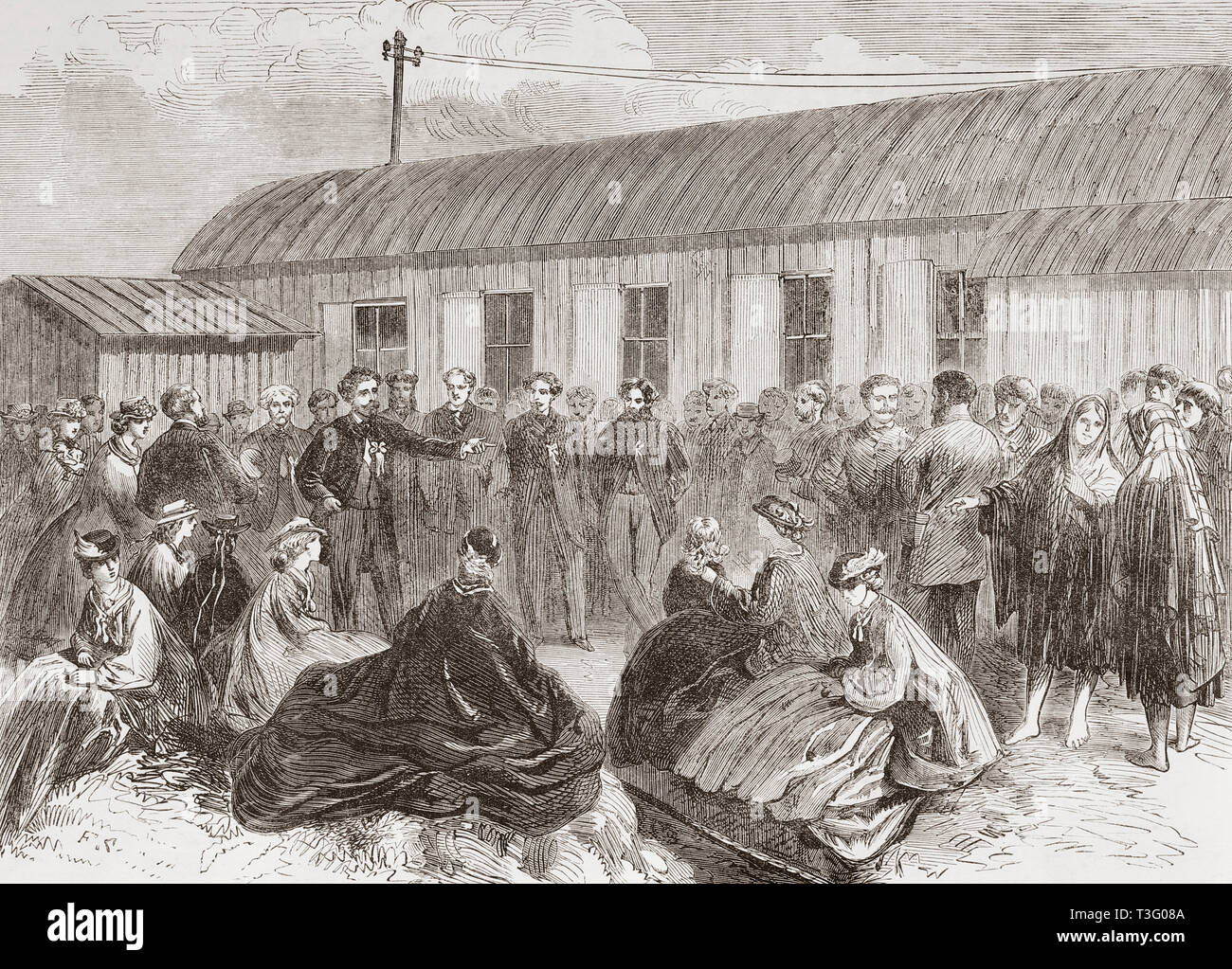 The laying of the Atlantic Telegraph Cable. Sir Robert Peel addressing the bystanders after connecting the shore end of the cable with the telegraph house at Foilhommerum Bay, Valentia Island, Ireland. From The Illustrated London News, published 1865. Stock Photohttps://www.alamy.com/image-license-details/?v=1https://www.alamy.com/the-laying-of-the-atlantic-telegraph-cable-sir-robert-peel-addressing-the-bystanders-after-connecting-the-shore-end-of-the-cable-with-the-telegraph-house-at-foilhommerum-bay-valentia-island-ireland-from-the-illustrated-london-news-published-1865-image243140586.html
The laying of the Atlantic Telegraph Cable. Sir Robert Peel addressing the bystanders after connecting the shore end of the cable with the telegraph house at Foilhommerum Bay, Valentia Island, Ireland. From The Illustrated London News, published 1865. Stock Photohttps://www.alamy.com/image-license-details/?v=1https://www.alamy.com/the-laying-of-the-atlantic-telegraph-cable-sir-robert-peel-addressing-the-bystanders-after-connecting-the-shore-end-of-the-cable-with-the-telegraph-house-at-foilhommerum-bay-valentia-island-ireland-from-the-illustrated-london-news-published-1865-image243140586.htmlRMT3G08A–The laying of the Atlantic Telegraph Cable. Sir Robert Peel addressing the bystanders after connecting the shore end of the cable with the telegraph house at Foilhommerum Bay, Valentia Island, Ireland. From The Illustrated London News, published 1865.
 'The Atlantic Telegraph - A bad look out for Despotism', 1858. Artist: Unknown Stock Photohttps://www.alamy.com/image-license-details/?v=1https://www.alamy.com/the-atlantic-telegraph-a-bad-look-out-for-despotism-1858-artist-unknown-image262733402.html
'The Atlantic Telegraph - A bad look out for Despotism', 1858. Artist: Unknown Stock Photohttps://www.alamy.com/image-license-details/?v=1https://www.alamy.com/the-atlantic-telegraph-a-bad-look-out-for-despotism-1858-artist-unknown-image262733402.htmlRMW7CF3P–'The Atlantic Telegraph - A bad look out for Despotism', 1858. Artist: Unknown
 Channel telegraph cable laying for the Atlantic Cable and Submarine Telegraph on the cliffs at Cape Grinez near Calais, France. 7 September 1850 Stock Photohttps://www.alamy.com/image-license-details/?v=1https://www.alamy.com/channel-telegraph-cable-laying-for-the-atlantic-cable-and-submarine-telegraph-on-the-cliffs-at-cape-grinez-near-calais-france-7-september-1850-image624408519.html
Channel telegraph cable laying for the Atlantic Cable and Submarine Telegraph on the cliffs at Cape Grinez near Calais, France. 7 September 1850 Stock Photohttps://www.alamy.com/image-license-details/?v=1https://www.alamy.com/channel-telegraph-cable-laying-for-the-atlantic-cable-and-submarine-telegraph-on-the-cliffs-at-cape-grinez-near-calais-france-7-september-1850-image624408519.htmlRM2Y7T7C7–Channel telegraph cable laying for the Atlantic Cable and Submarine Telegraph on the cliffs at Cape Grinez near Calais, France. 7 September 1850
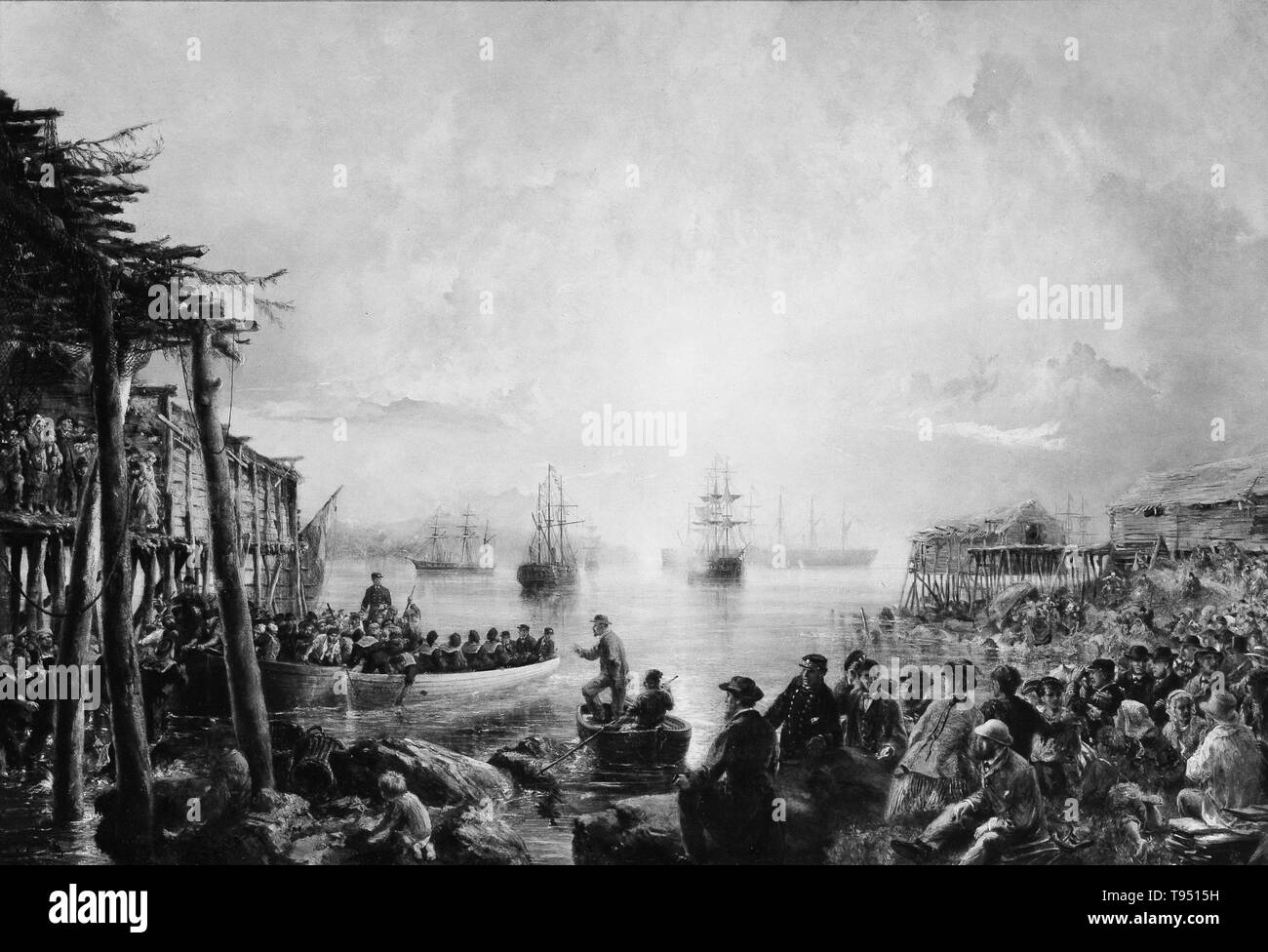 Landing the transatlantic cable at Newfoundland in 1866, by Robert Charles Dudley (British, 1826-1909). One of the 19th century's great technological achievements was to lay a telegraphic cable beneath the Atlantic, allowing messages to speed back and forth between North America and Europe in minutes, rather than ten or twelve days by steamer. An initially successful attempt in 1858, led by Cyrus W. Field and financed by the Atlantic Telegraph Company, failed after three weeks. Stock Photohttps://www.alamy.com/image-license-details/?v=1https://www.alamy.com/landing-the-transatlantic-cable-at-newfoundland-in-1866-by-robert-charles-dudley-british-1826-1909-one-of-the-19th-centurys-great-technological-achievements-was-to-lay-a-telegraphic-cable-beneath-the-atlantic-allowing-messages-to-speed-back-and-forth-between-north-america-and-europe-in-minutes-rather-than-ten-or-twelve-days-by-steamer-an-initially-successful-attempt-in-1858-led-by-cyrus-w-field-and-financed-by-the-atlantic-telegraph-company-failed-after-three-weeks-image246587757.html
Landing the transatlantic cable at Newfoundland in 1866, by Robert Charles Dudley (British, 1826-1909). One of the 19th century's great technological achievements was to lay a telegraphic cable beneath the Atlantic, allowing messages to speed back and forth between North America and Europe in minutes, rather than ten or twelve days by steamer. An initially successful attempt in 1858, led by Cyrus W. Field and financed by the Atlantic Telegraph Company, failed after three weeks. Stock Photohttps://www.alamy.com/image-license-details/?v=1https://www.alamy.com/landing-the-transatlantic-cable-at-newfoundland-in-1866-by-robert-charles-dudley-british-1826-1909-one-of-the-19th-centurys-great-technological-achievements-was-to-lay-a-telegraphic-cable-beneath-the-atlantic-allowing-messages-to-speed-back-and-forth-between-north-america-and-europe-in-minutes-rather-than-ten-or-twelve-days-by-steamer-an-initially-successful-attempt-in-1858-led-by-cyrus-w-field-and-financed-by-the-atlantic-telegraph-company-failed-after-three-weeks-image246587757.htmlRMT9515H–Landing the transatlantic cable at Newfoundland in 1866, by Robert Charles Dudley (British, 1826-1909). One of the 19th century's great technological achievements was to lay a telegraphic cable beneath the Atlantic, allowing messages to speed back and forth between North America and Europe in minutes, rather than ten or twelve days by steamer. An initially successful attempt in 1858, led by Cyrus W. Field and financed by the Atlantic Telegraph Company, failed after three weeks.
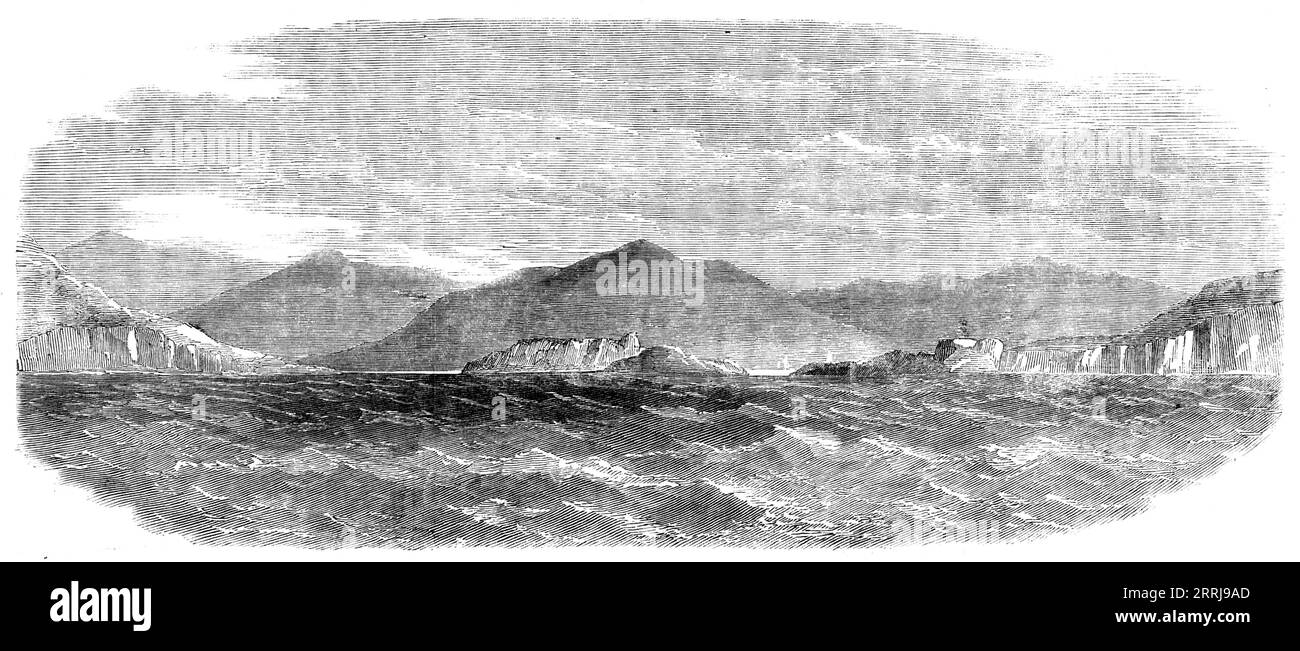 Laying the Atlantic Telegraph Cable - Valentia, 1858. 'View of Valentia, to which island considerable interest attaches in connection with the Atlantic Telegraph, as it is destined to receive the European end of the cable, being "the nearest parish to America." This island, about five miles long and two broad, is situated near the southwest of Ireland, a short distance south of Dingle Bay'. From "Illustrated London News", 1858. Stock Photohttps://www.alamy.com/image-license-details/?v=1https://www.alamy.com/laying-the-atlantic-telegraph-cable-valentia-1858-view-of-valentia-to-which-island-considerable-interest-attaches-in-connection-with-the-atlantic-telegraph-as-it-is-destined-to-receive-the-european-end-of-the-cable-being-quotthe-nearest-parish-to-americaquot-this-island-about-five-miles-long-and-two-broad-is-situated-near-the-southwest-of-ireland-a-short-distance-south-of-dingle-bay-from-quotillustrated-london-newsquot-1858-image565271349.html
Laying the Atlantic Telegraph Cable - Valentia, 1858. 'View of Valentia, to which island considerable interest attaches in connection with the Atlantic Telegraph, as it is destined to receive the European end of the cable, being "the nearest parish to America." This island, about five miles long and two broad, is situated near the southwest of Ireland, a short distance south of Dingle Bay'. From "Illustrated London News", 1858. Stock Photohttps://www.alamy.com/image-license-details/?v=1https://www.alamy.com/laying-the-atlantic-telegraph-cable-valentia-1858-view-of-valentia-to-which-island-considerable-interest-attaches-in-connection-with-the-atlantic-telegraph-as-it-is-destined-to-receive-the-european-end-of-the-cable-being-quotthe-nearest-parish-to-americaquot-this-island-about-five-miles-long-and-two-broad-is-situated-near-the-southwest-of-ireland-a-short-distance-south-of-dingle-bay-from-quotillustrated-london-newsquot-1858-image565271349.htmlRM2RRJ9AD–Laying the Atlantic Telegraph Cable - Valentia, 1858. 'View of Valentia, to which island considerable interest attaches in connection with the Atlantic Telegraph, as it is destined to receive the European end of the cable, being "the nearest parish to America." This island, about five miles long and two broad, is situated near the southwest of Ireland, a short distance south of Dingle Bay'. From "Illustrated London News", 1858.
 Coiling the Cable in the Large Tanks at the Works of the Telegraph Construction and Maintenance Company of Greenwich, 1865, 1865. Stock Photohttps://www.alamy.com/image-license-details/?v=1https://www.alamy.com/coiling-the-cable-in-the-large-tanks-at-the-works-of-the-telegraph-construction-and-maintenance-company-of-greenwich-1865-1865-image365762907.html
Coiling the Cable in the Large Tanks at the Works of the Telegraph Construction and Maintenance Company of Greenwich, 1865, 1865. Stock Photohttps://www.alamy.com/image-license-details/?v=1https://www.alamy.com/coiling-the-cable-in-the-large-tanks-at-the-works-of-the-telegraph-construction-and-maintenance-company-of-greenwich-1865-1865-image365762907.htmlRM2C71X8Y–Coiling the Cable in the Large Tanks at the Works of the Telegraph Construction and Maintenance Company of Greenwich, 1865, 1865.
 Getting Out One of the Great Buoys: The Deck of the Great Eastern Looking From the Forecastle. Artist: Robert Charles Dudley (British, 1826-1909). Dimensions: Sheet: 9 13/16 × 14 7/16 in. (25 × 36.7 cm). Date: 1865-66. One of the 19th century's great technological achievements was to lay a telegraphic cable beneath the Atlantic, allowing messages to speed back and forth between North America and Europe in minutes, rather than ten or twelve days by steamer. An initially successful attempt in 1858, led by Cyrus W. Field and financed by the Atlantic Telegraph Company, failed after three weeks. T Stock Photohttps://www.alamy.com/image-license-details/?v=1https://www.alamy.com/getting-out-one-of-the-great-buoys-the-deck-of-the-great-eastern-looking-from-the-forecastle-artist-robert-charles-dudley-british-1826-1909-dimensions-sheet-9-1316-14-716-in-25-367-cm-date-1865-66-one-of-the-19th-centurys-great-technological-achievements-was-to-lay-a-telegraphic-cable-beneath-the-atlantic-allowing-messages-to-speed-back-and-forth-between-north-america-and-europe-in-minutes-rather-than-ten-or-twelve-days-by-steamer-an-initially-successful-attempt-in-1858-led-by-cyrus-w-field-and-financed-by-the-atlantic-telegraph-company-failed-after-three-weeks-t-image212913206.html
Getting Out One of the Great Buoys: The Deck of the Great Eastern Looking From the Forecastle. Artist: Robert Charles Dudley (British, 1826-1909). Dimensions: Sheet: 9 13/16 × 14 7/16 in. (25 × 36.7 cm). Date: 1865-66. One of the 19th century's great technological achievements was to lay a telegraphic cable beneath the Atlantic, allowing messages to speed back and forth between North America and Europe in minutes, rather than ten or twelve days by steamer. An initially successful attempt in 1858, led by Cyrus W. Field and financed by the Atlantic Telegraph Company, failed after three weeks. T Stock Photohttps://www.alamy.com/image-license-details/?v=1https://www.alamy.com/getting-out-one-of-the-great-buoys-the-deck-of-the-great-eastern-looking-from-the-forecastle-artist-robert-charles-dudley-british-1826-1909-dimensions-sheet-9-1316-14-716-in-25-367-cm-date-1865-66-one-of-the-19th-centurys-great-technological-achievements-was-to-lay-a-telegraphic-cable-beneath-the-atlantic-allowing-messages-to-speed-back-and-forth-between-north-america-and-europe-in-minutes-rather-than-ten-or-twelve-days-by-steamer-an-initially-successful-attempt-in-1858-led-by-cyrus-w-field-and-financed-by-the-atlantic-telegraph-company-failed-after-three-weeks-t-image212913206.htmlRMPAB0Y2–Getting Out One of the Great Buoys: The Deck of the Great Eastern Looking From the Forecastle. Artist: Robert Charles Dudley (British, 1826-1909). Dimensions: Sheet: 9 13/16 × 14 7/16 in. (25 × 36.7 cm). Date: 1865-66. One of the 19th century's great technological achievements was to lay a telegraphic cable beneath the Atlantic, allowing messages to speed back and forth between North America and Europe in minutes, rather than ten or twelve days by steamer. An initially successful attempt in 1858, led by Cyrus W. Field and financed by the Atlantic Telegraph Company, failed after three weeks. T
 Cyrus W. Field (portrait bust) Stock Photohttps://www.alamy.com/image-license-details/?v=1https://www.alamy.com/cyrus-w-field-portrait-bust-image210874098.html
Cyrus W. Field (portrait bust) Stock Photohttps://www.alamy.com/image-license-details/?v=1https://www.alamy.com/cyrus-w-field-portrait-bust-image210874098.htmlRMP7241P–Cyrus W. Field (portrait bust)
 Portrait of Edward Whitehouse (1816-1890) an English surgeon and electrical engineer. Dated 19th Century Stock Photohttps://www.alamy.com/image-license-details/?v=1https://www.alamy.com/stock-image-portrait-of-edward-whitehouse-1816-1890-an-english-surgeon-and-electrical-162593570.html
Portrait of Edward Whitehouse (1816-1890) an English surgeon and electrical engineer. Dated 19th Century Stock Photohttps://www.alamy.com/image-license-details/?v=1https://www.alamy.com/stock-image-portrait-of-edward-whitehouse-1816-1890-an-english-surgeon-and-electrical-162593570.htmlRMKCENN6–Portrait of Edward Whitehouse (1816-1890) an English surgeon and electrical engineer. Dated 19th Century
 The Reels of Gutta-percha Covered Conducting Wire Conveyed into Tanks at the Works of the Telegraph Construction and Maintenance Stock Photohttps://www.alamy.com/image-license-details/?v=1https://www.alamy.com/stock-image-the-reels-of-gutta-percha-covered-conducting-wire-conveyed-into-tanks-162454596.html
The Reels of Gutta-percha Covered Conducting Wire Conveyed into Tanks at the Works of the Telegraph Construction and Maintenance Stock Photohttps://www.alamy.com/image-license-details/?v=1https://www.alamy.com/stock-image-the-reels-of-gutta-percha-covered-conducting-wire-conveyed-into-tanks-162454596.htmlRMKC8CDT–The Reels of Gutta-percha Covered Conducting Wire Conveyed into Tanks at the Works of the Telegraph Construction and Maintenance
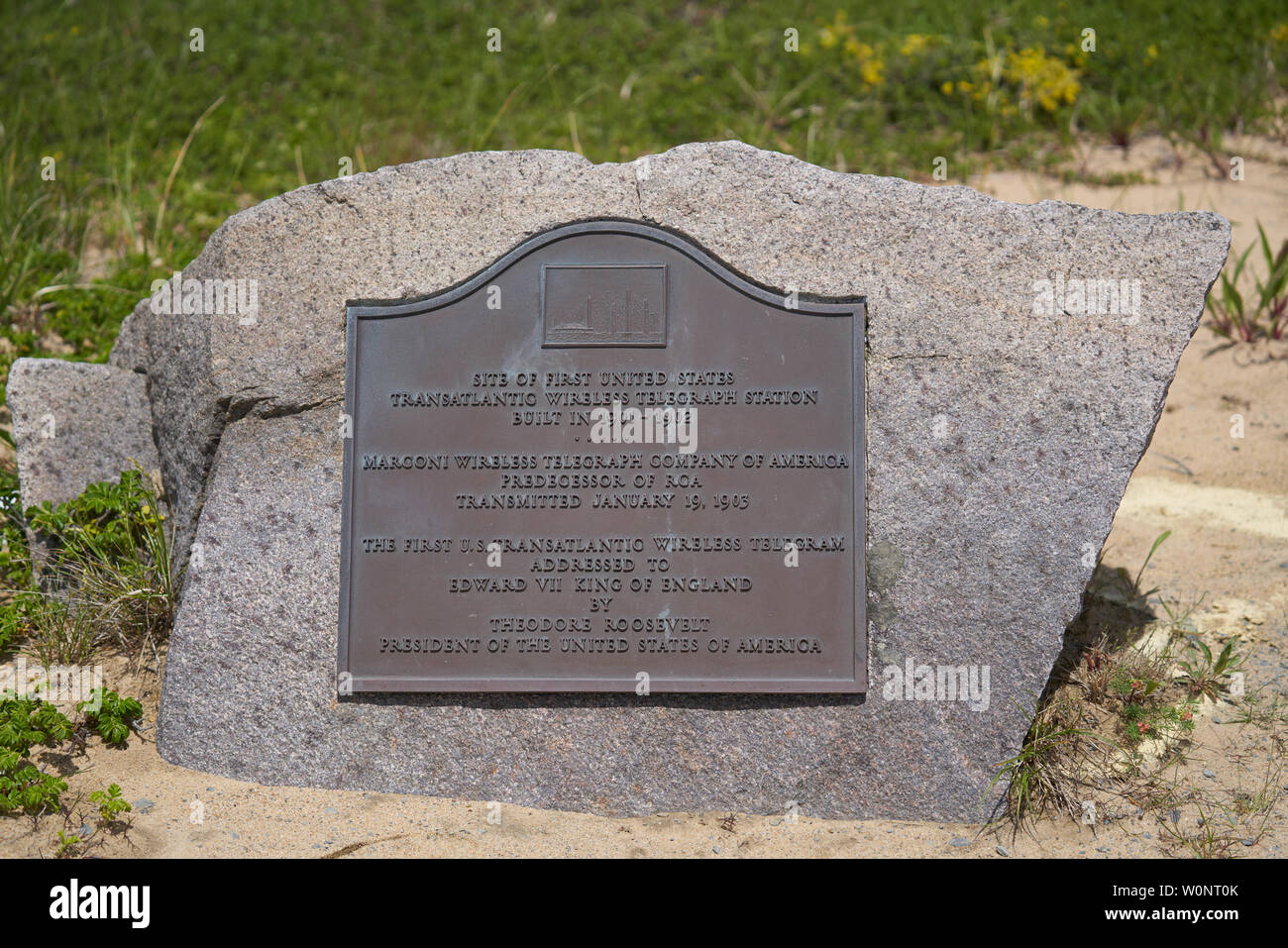 South Wellfleet, MA - June 12, 2019: This bronze plaque commemorates the site of the first US Transatlantic wireless telegraph station by Marconi Wire Stock Photohttps://www.alamy.com/image-license-details/?v=1https://www.alamy.com/south-wellfleet-ma-june-12-2019-this-bronze-plaque-commemorates-the-site-of-the-first-us-transatlantic-wireless-telegraph-station-by-marconi-wire-image258635347.html
South Wellfleet, MA - June 12, 2019: This bronze plaque commemorates the site of the first US Transatlantic wireless telegraph station by Marconi Wire Stock Photohttps://www.alamy.com/image-license-details/?v=1https://www.alamy.com/south-wellfleet-ma-june-12-2019-this-bronze-plaque-commemorates-the-site-of-the-first-us-transatlantic-wireless-telegraph-station-by-marconi-wire-image258635347.htmlRFW0NT0K–South Wellfleet, MA - June 12, 2019: This bronze plaque commemorates the site of the first US Transatlantic wireless telegraph station by Marconi Wire
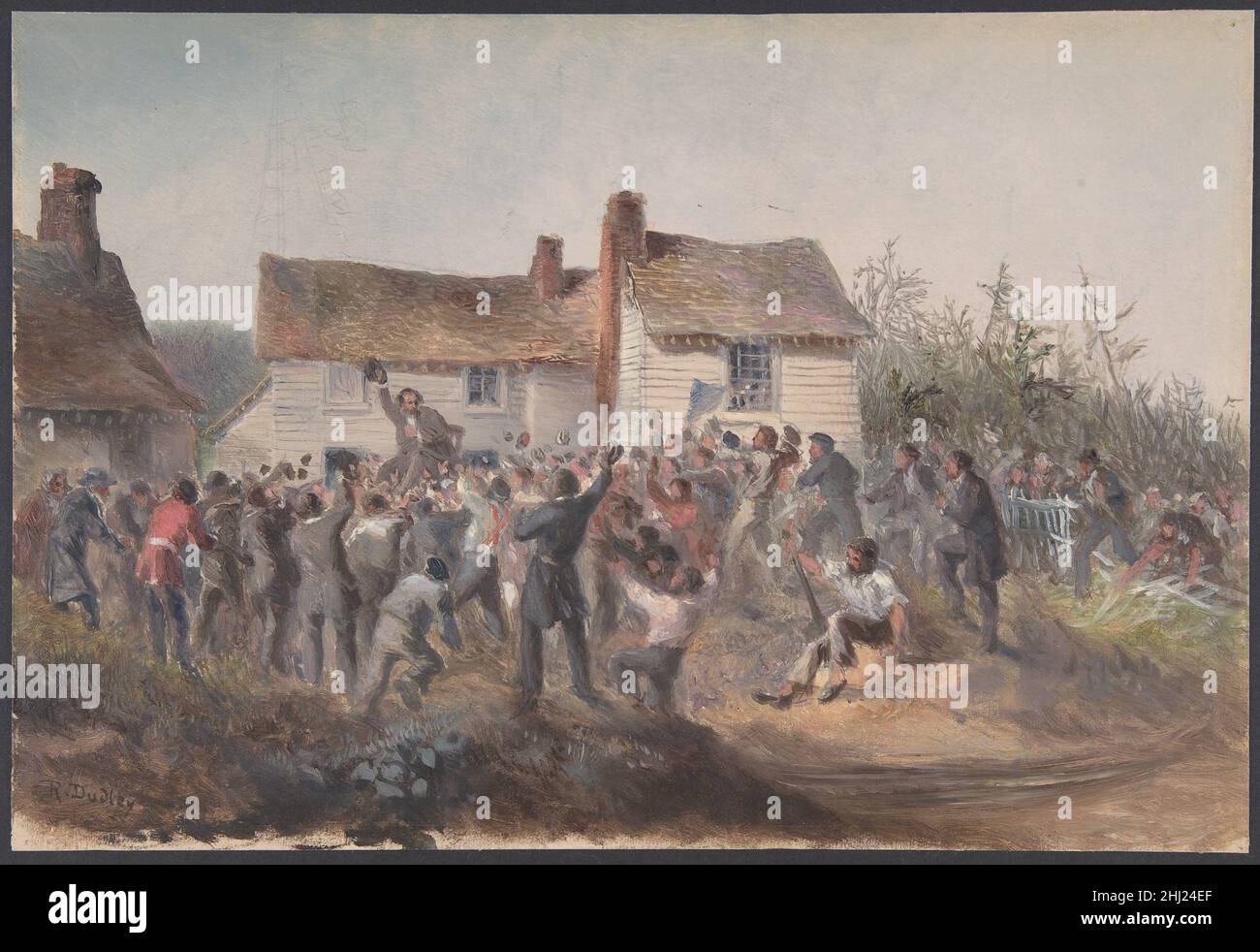 September 8th at Heart's Content, the day of the successful termination of the work of laying, recovering, completing and testing the Atlantic Telegraph Cables of 1865 and 1866 1866 Robert Charles Dudley British One of the 19th century's great technological achievements was to lay a telegraphic cable beneath the Atlantic, allowing messages to speed back and forth between North America and Europe in minutes, rather than ten or twelve days by steamer. An initially successful attempt in 1858, led by Cyrus W. Field and financed by the Atlantic Telegraph Company, failed after three weeks. Two worki Stock Photohttps://www.alamy.com/image-license-details/?v=1https://www.alamy.com/september-8th-at-hearts-content-the-day-of-the-successful-termination-of-the-work-of-laying-recovering-completing-and-testing-the-atlantic-telegraph-cables-of-1865-and-1866-1866-robert-charles-dudley-british-one-of-the-19th-centurys-great-technological-achievements-was-to-lay-a-telegraphic-cable-beneath-the-atlantic-allowing-messages-to-speed-back-and-forth-between-north-america-and-europe-in-minutes-rather-than-ten-or-twelve-days-by-steamer-an-initially-successful-attempt-in-1858-led-by-cyrus-w-field-and-financed-by-the-atlantic-telegraph-company-failed-after-three-weeks-two-worki-image458580823.html
September 8th at Heart's Content, the day of the successful termination of the work of laying, recovering, completing and testing the Atlantic Telegraph Cables of 1865 and 1866 1866 Robert Charles Dudley British One of the 19th century's great technological achievements was to lay a telegraphic cable beneath the Atlantic, allowing messages to speed back and forth between North America and Europe in minutes, rather than ten or twelve days by steamer. An initially successful attempt in 1858, led by Cyrus W. Field and financed by the Atlantic Telegraph Company, failed after three weeks. Two worki Stock Photohttps://www.alamy.com/image-license-details/?v=1https://www.alamy.com/september-8th-at-hearts-content-the-day-of-the-successful-termination-of-the-work-of-laying-recovering-completing-and-testing-the-atlantic-telegraph-cables-of-1865-and-1866-1866-robert-charles-dudley-british-one-of-the-19th-centurys-great-technological-achievements-was-to-lay-a-telegraphic-cable-beneath-the-atlantic-allowing-messages-to-speed-back-and-forth-between-north-america-and-europe-in-minutes-rather-than-ten-or-twelve-days-by-steamer-an-initially-successful-attempt-in-1858-led-by-cyrus-w-field-and-financed-by-the-atlantic-telegraph-company-failed-after-three-weeks-two-worki-image458580823.htmlRM2HJ24EF–September 8th at Heart's Content, the day of the successful termination of the work of laying, recovering, completing and testing the Atlantic Telegraph Cables of 1865 and 1866 1866 Robert Charles Dudley British One of the 19th century's great technological achievements was to lay a telegraphic cable beneath the Atlantic, allowing messages to speed back and forth between North America and Europe in minutes, rather than ten or twelve days by steamer. An initially successful attempt in 1858, led by Cyrus W. Field and financed by the Atlantic Telegraph Company, failed after three weeks. Two worki
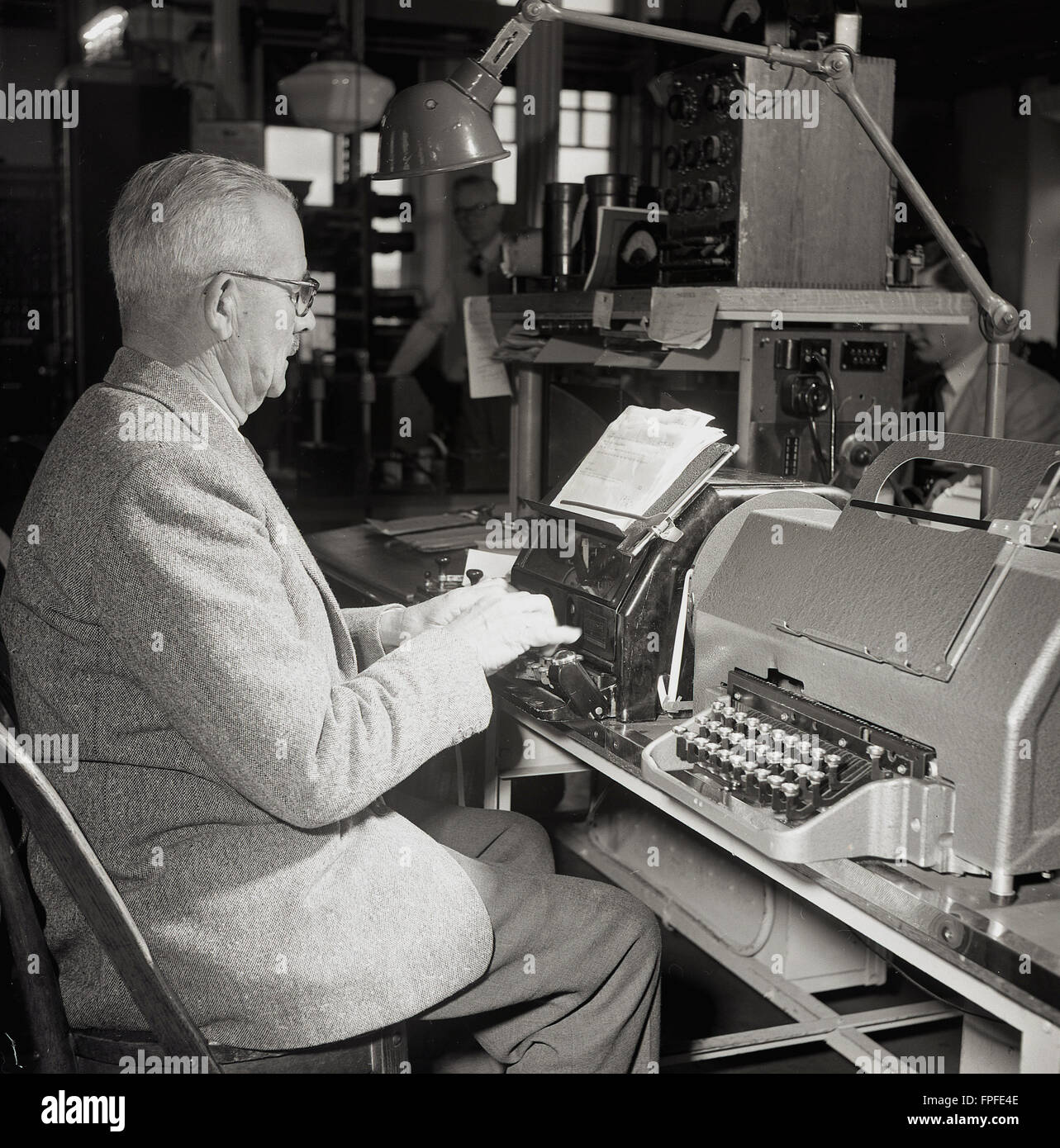 1950s historical, a male operator sitting at a machine sending a telex message from the Trans-Atlantic Cable Station in Waterville, Kerry, Ireland. In this era, the telex machine was a piece of technology used for sending written messages either by electricity or radio signals and remained an important means of business communication until the development of the fax machine in the 1980s. Stock Photohttps://www.alamy.com/image-license-details/?v=1https://www.alamy.com/stock-photo-1950s-historical-a-male-operator-sitting-at-a-machine-sending-a-telex-99914654.html
1950s historical, a male operator sitting at a machine sending a telex message from the Trans-Atlantic Cable Station in Waterville, Kerry, Ireland. In this era, the telex machine was a piece of technology used for sending written messages either by electricity or radio signals and remained an important means of business communication until the development of the fax machine in the 1980s. Stock Photohttps://www.alamy.com/image-license-details/?v=1https://www.alamy.com/stock-photo-1950s-historical-a-male-operator-sitting-at-a-machine-sending-a-telex-99914654.htmlRMFPFE4E–1950s historical, a male operator sitting at a machine sending a telex message from the Trans-Atlantic Cable Station in Waterville, Kerry, Ireland. In this era, the telex machine was a piece of technology used for sending written messages either by electricity or radio signals and remained an important means of business communication until the development of the fax machine in the 1980s.
![The Atlantic Telegraph [1866] Sir William Howard Russell Irish This book documents the great 19th century technological achievement of laying a telegraphic cable beneath the Atlantic to allow messages to speed back and forth between North America and Europe in minutes, rather than the ten or twelve days it took to cross the ocean by steamer. Led by Cyrus W. Field and financed by the Atlantic Telegraph Company, an initially successful attempt in 1858 failed after three weeks. Repeated efforts by Field, a cadre of engineers, technicians, and sailors, backed by two groups of investors with help f Stock Photo The Atlantic Telegraph [1866] Sir William Howard Russell Irish This book documents the great 19th century technological achievement of laying a telegraphic cable beneath the Atlantic to allow messages to speed back and forth between North America and Europe in minutes, rather than the ten or twelve days it took to cross the ocean by steamer. Led by Cyrus W. Field and financed by the Atlantic Telegraph Company, an initially successful attempt in 1858 failed after three weeks. Repeated efforts by Field, a cadre of engineers, technicians, and sailors, backed by two groups of investors with help f Stock Photo](https://c8.alamy.com/comp/2HH7KRX/the-atlantic-telegraph-1866-sir-william-howard-russell-irish-this-book-documents-the-great-19th-century-technological-achievement-of-laying-a-telegraphic-cable-beneath-the-atlantic-to-allow-messages-to-speed-back-and-forth-between-north-america-and-europe-in-minutes-rather-than-the-ten-or-twelve-days-it-took-to-cross-the-ocean-by-steamer-led-by-cyrus-w-field-and-financed-by-the-atlantic-telegraph-company-an-initially-successful-attempt-in-1858-failed-after-three-weeks-repeated-efforts-by-field-a-cadre-of-engineers-technicians-and-sailors-backed-by-two-groups-of-investors-with-help-f-2HH7KRX.jpg) The Atlantic Telegraph [1866] Sir William Howard Russell Irish This book documents the great 19th century technological achievement of laying a telegraphic cable beneath the Atlantic to allow messages to speed back and forth between North America and Europe in minutes, rather than the ten or twelve days it took to cross the ocean by steamer. Led by Cyrus W. Field and financed by the Atlantic Telegraph Company, an initially successful attempt in 1858 failed after three weeks. Repeated efforts by Field, a cadre of engineers, technicians, and sailors, backed by two groups of investors with help f Stock Photohttps://www.alamy.com/image-license-details/?v=1https://www.alamy.com/the-atlantic-telegraph-1866-sir-william-howard-russell-irish-this-book-documents-the-great-19th-century-technological-achievement-of-laying-a-telegraphic-cable-beneath-the-atlantic-to-allow-messages-to-speed-back-and-forth-between-north-america-and-europe-in-minutes-rather-than-the-ten-or-twelve-days-it-took-to-cross-the-ocean-by-steamer-led-by-cyrus-w-field-and-financed-by-the-atlantic-telegraph-company-an-initially-successful-attempt-in-1858-failed-after-three-weeks-repeated-efforts-by-field-a-cadre-of-engineers-technicians-and-sailors-backed-by-two-groups-of-investors-with-help-f-image458087950.html
The Atlantic Telegraph [1866] Sir William Howard Russell Irish This book documents the great 19th century technological achievement of laying a telegraphic cable beneath the Atlantic to allow messages to speed back and forth between North America and Europe in minutes, rather than the ten or twelve days it took to cross the ocean by steamer. Led by Cyrus W. Field and financed by the Atlantic Telegraph Company, an initially successful attempt in 1858 failed after three weeks. Repeated efforts by Field, a cadre of engineers, technicians, and sailors, backed by two groups of investors with help f Stock Photohttps://www.alamy.com/image-license-details/?v=1https://www.alamy.com/the-atlantic-telegraph-1866-sir-william-howard-russell-irish-this-book-documents-the-great-19th-century-technological-achievement-of-laying-a-telegraphic-cable-beneath-the-atlantic-to-allow-messages-to-speed-back-and-forth-between-north-america-and-europe-in-minutes-rather-than-the-ten-or-twelve-days-it-took-to-cross-the-ocean-by-steamer-led-by-cyrus-w-field-and-financed-by-the-atlantic-telegraph-company-an-initially-successful-attempt-in-1858-failed-after-three-weeks-repeated-efforts-by-field-a-cadre-of-engineers-technicians-and-sailors-backed-by-two-groups-of-investors-with-help-f-image458087950.htmlRM2HH7KRX–The Atlantic Telegraph [1866] Sir William Howard Russell Irish This book documents the great 19th century technological achievement of laying a telegraphic cable beneath the Atlantic to allow messages to speed back and forth between North America and Europe in minutes, rather than the ten or twelve days it took to cross the ocean by steamer. Led by Cyrus W. Field and financed by the Atlantic Telegraph Company, an initially successful attempt in 1858 failed after three weeks. Repeated efforts by Field, a cadre of engineers, technicians, and sailors, backed by two groups of investors with help f
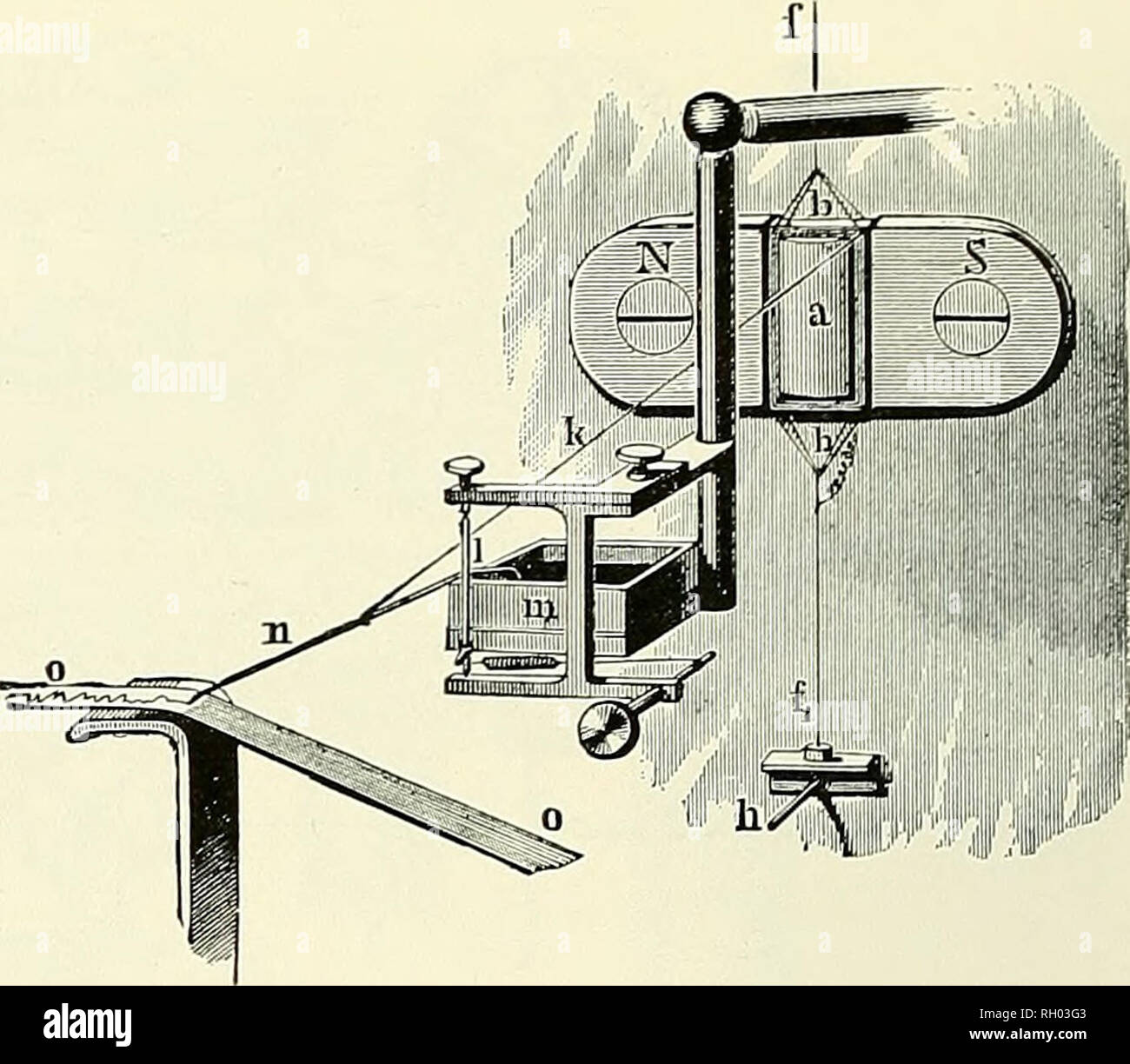 . Bulletin. Science. pointed out the existence of a submarine plateau be- tween Ireland and Newfoundland. This plateau promised a natural advantage for laying an Atlantic cable. In 1856 Field enlisted Charles Bright and John Brett to join him in organizing the Atlantic Telegraph Company for the purpose of undertaking to lay a cable between Newfoundland and Ireland. By 1857 some 2,500 miles of armored gutta-percha cable had been manufactured, and the cable-laying ship started from Ireland at the end of the summer. However, the cable broke about 330 miles away from the starting point, and the pr Stock Photohttps://www.alamy.com/image-license-details/?v=1https://www.alamy.com/bulletin-science-pointed-out-the-existence-of-a-submarine-plateau-be-tween-ireland-and-newfoundland-this-plateau-promised-a-natural-advantage-for-laying-an-atlantic-cable-in-1856-field-enlisted-charles-bright-and-john-brett-to-join-him-in-organizing-the-atlantic-telegraph-company-for-the-purpose-of-undertaking-to-lay-a-cable-between-newfoundland-and-ireland-by-1857-some-2500-miles-of-armored-gutta-percha-cable-had-been-manufactured-and-the-cable-laying-ship-started-from-ireland-at-the-end-of-the-summer-however-the-cable-broke-about-330-miles-away-from-the-starting-point-and-the-pr-image234186739.html
. Bulletin. Science. pointed out the existence of a submarine plateau be- tween Ireland and Newfoundland. This plateau promised a natural advantage for laying an Atlantic cable. In 1856 Field enlisted Charles Bright and John Brett to join him in organizing the Atlantic Telegraph Company for the purpose of undertaking to lay a cable between Newfoundland and Ireland. By 1857 some 2,500 miles of armored gutta-percha cable had been manufactured, and the cable-laying ship started from Ireland at the end of the summer. However, the cable broke about 330 miles away from the starting point, and the pr Stock Photohttps://www.alamy.com/image-license-details/?v=1https://www.alamy.com/bulletin-science-pointed-out-the-existence-of-a-submarine-plateau-be-tween-ireland-and-newfoundland-this-plateau-promised-a-natural-advantage-for-laying-an-atlantic-cable-in-1856-field-enlisted-charles-bright-and-john-brett-to-join-him-in-organizing-the-atlantic-telegraph-company-for-the-purpose-of-undertaking-to-lay-a-cable-between-newfoundland-and-ireland-by-1857-some-2500-miles-of-armored-gutta-percha-cable-had-been-manufactured-and-the-cable-laying-ship-started-from-ireland-at-the-end-of-the-summer-however-the-cable-broke-about-330-miles-away-from-the-starting-point-and-the-pr-image234186739.htmlRMRH03G3–. Bulletin. Science. pointed out the existence of a submarine plateau be- tween Ireland and Newfoundland. This plateau promised a natural advantage for laying an Atlantic cable. In 1856 Field enlisted Charles Bright and John Brett to join him in organizing the Atlantic Telegraph Company for the purpose of undertaking to lay a cable between Newfoundland and Ireland. By 1857 some 2,500 miles of armored gutta-percha cable had been manufactured, and the cable-laying ship started from Ireland at the end of the summer. However, the cable broke about 330 miles away from the starting point, and the pr
 The Settlement and Church of Heart's Content, Newfoundland 1866 Robert Charles Dudley British One of the 19th century's great technological achievements was to lay a telegraphic cable beneath the Atlantic, allowing messages to speed back and forth between North America and Europe in minutes, rather than ten or twelve days by steamer. An initially successful attempt in 1858, led by Cyrus W. Field and financed by the Atlantic Telegraph Company, failed after three weeks. Two working cables were finally laid in July and September 1866, the result of repeated efforts by the indefatigable Field, a c Stock Photohttps://www.alamy.com/image-license-details/?v=1https://www.alamy.com/the-settlement-and-church-of-hearts-content-newfoundland-1866-robert-charles-dudley-british-one-of-the-19th-centurys-great-technological-achievements-was-to-lay-a-telegraphic-cable-beneath-the-atlantic-allowing-messages-to-speed-back-and-forth-between-north-america-and-europe-in-minutes-rather-than-ten-or-twelve-days-by-steamer-an-initially-successful-attempt-in-1858-led-by-cyrus-w-field-and-financed-by-the-atlantic-telegraph-company-failed-after-three-weeks-two-working-cables-were-finally-laid-in-july-and-september-1866-the-result-of-repeated-efforts-by-the-indefatigable-field-a-c-image458460273.html
The Settlement and Church of Heart's Content, Newfoundland 1866 Robert Charles Dudley British One of the 19th century's great technological achievements was to lay a telegraphic cable beneath the Atlantic, allowing messages to speed back and forth between North America and Europe in minutes, rather than ten or twelve days by steamer. An initially successful attempt in 1858, led by Cyrus W. Field and financed by the Atlantic Telegraph Company, failed after three weeks. Two working cables were finally laid in July and September 1866, the result of repeated efforts by the indefatigable Field, a c Stock Photohttps://www.alamy.com/image-license-details/?v=1https://www.alamy.com/the-settlement-and-church-of-hearts-content-newfoundland-1866-robert-charles-dudley-british-one-of-the-19th-centurys-great-technological-achievements-was-to-lay-a-telegraphic-cable-beneath-the-atlantic-allowing-messages-to-speed-back-and-forth-between-north-america-and-europe-in-minutes-rather-than-ten-or-twelve-days-by-steamer-an-initially-successful-attempt-in-1858-led-by-cyrus-w-field-and-financed-by-the-atlantic-telegraph-company-failed-after-three-weeks-two-working-cables-were-finally-laid-in-july-and-september-1866-the-result-of-repeated-efforts-by-the-indefatigable-field-a-c-image458460273.htmlRM2HHTJN5–The Settlement and Church of Heart's Content, Newfoundland 1866 Robert Charles Dudley British One of the 19th century's great technological achievements was to lay a telegraphic cable beneath the Atlantic, allowing messages to speed back and forth between North America and Europe in minutes, rather than ten or twelve days by steamer. An initially successful attempt in 1858, led by Cyrus W. Field and financed by the Atlantic Telegraph Company, failed after three weeks. Two working cables were finally laid in July and September 1866, the result of repeated efforts by the indefatigable Field, a c
 Repairing an undersea communications cable Stock Photohttps://www.alamy.com/image-license-details/?v=1https://www.alamy.com/stock-photo-repairing-an-undersea-communications-cable-176239083.html
Repairing an undersea communications cable Stock Photohttps://www.alamy.com/image-license-details/?v=1https://www.alamy.com/stock-photo-repairing-an-undersea-communications-cable-176239083.htmlRMM6MAMY–Repairing an undersea communications cable
 The Atlantic Telegraph Cable Fleet Assembled at Berehaven (Southwest Coast of Ireland): Ships, the Great Eastern, H.M.S. Terrible, the Alby, the Medway and the William Cory 1866 Robert Charles Dudley British One of the 19th century's great technological achievements was to lay a telegraphic cable beneath the Atlantic, allowing messages to speed back and forth between North America and Europe in minutes, rather than ten or twelve days by steamer. An initially successful attempt in 1858, led by Cyrus W. Field and financed by the Atlantic Telegraph Company, failed after three weeks. Two working c Stock Photohttps://www.alamy.com/image-license-details/?v=1https://www.alamy.com/the-atlantic-telegraph-cable-fleet-assembled-at-berehaven-southwest-coast-of-ireland-ships-the-great-eastern-hms-terrible-the-alby-the-medway-and-the-william-cory-1866-robert-charles-dudley-british-one-of-the-19th-centurys-great-technological-achievements-was-to-lay-a-telegraphic-cable-beneath-the-atlantic-allowing-messages-to-speed-back-and-forth-between-north-america-and-europe-in-minutes-rather-than-ten-or-twelve-days-by-steamer-an-initially-successful-attempt-in-1858-led-by-cyrus-w-field-and-financed-by-the-atlantic-telegraph-company-failed-after-three-weeks-two-working-c-image458625242.html
The Atlantic Telegraph Cable Fleet Assembled at Berehaven (Southwest Coast of Ireland): Ships, the Great Eastern, H.M.S. Terrible, the Alby, the Medway and the William Cory 1866 Robert Charles Dudley British One of the 19th century's great technological achievements was to lay a telegraphic cable beneath the Atlantic, allowing messages to speed back and forth between North America and Europe in minutes, rather than ten or twelve days by steamer. An initially successful attempt in 1858, led by Cyrus W. Field and financed by the Atlantic Telegraph Company, failed after three weeks. Two working c Stock Photohttps://www.alamy.com/image-license-details/?v=1https://www.alamy.com/the-atlantic-telegraph-cable-fleet-assembled-at-berehaven-southwest-coast-of-ireland-ships-the-great-eastern-hms-terrible-the-alby-the-medway-and-the-william-cory-1866-robert-charles-dudley-british-one-of-the-19th-centurys-great-technological-achievements-was-to-lay-a-telegraphic-cable-beneath-the-atlantic-allowing-messages-to-speed-back-and-forth-between-north-america-and-europe-in-minutes-rather-than-ten-or-twelve-days-by-steamer-an-initially-successful-attempt-in-1858-led-by-cyrus-w-field-and-financed-by-the-atlantic-telegraph-company-failed-after-three-weeks-two-working-c-image458625242.htmlRM2HJ454X–The Atlantic Telegraph Cable Fleet Assembled at Berehaven (Southwest Coast of Ireland): Ships, the Great Eastern, H.M.S. Terrible, the Alby, the Medway and the William Cory 1866 Robert Charles Dudley British One of the 19th century's great technological achievements was to lay a telegraphic cable beneath the Atlantic, allowing messages to speed back and forth between North America and Europe in minutes, rather than ten or twelve days by steamer. An initially successful attempt in 1858, led by Cyrus W. Field and financed by the Atlantic Telegraph Company, failed after three weeks. Two working c
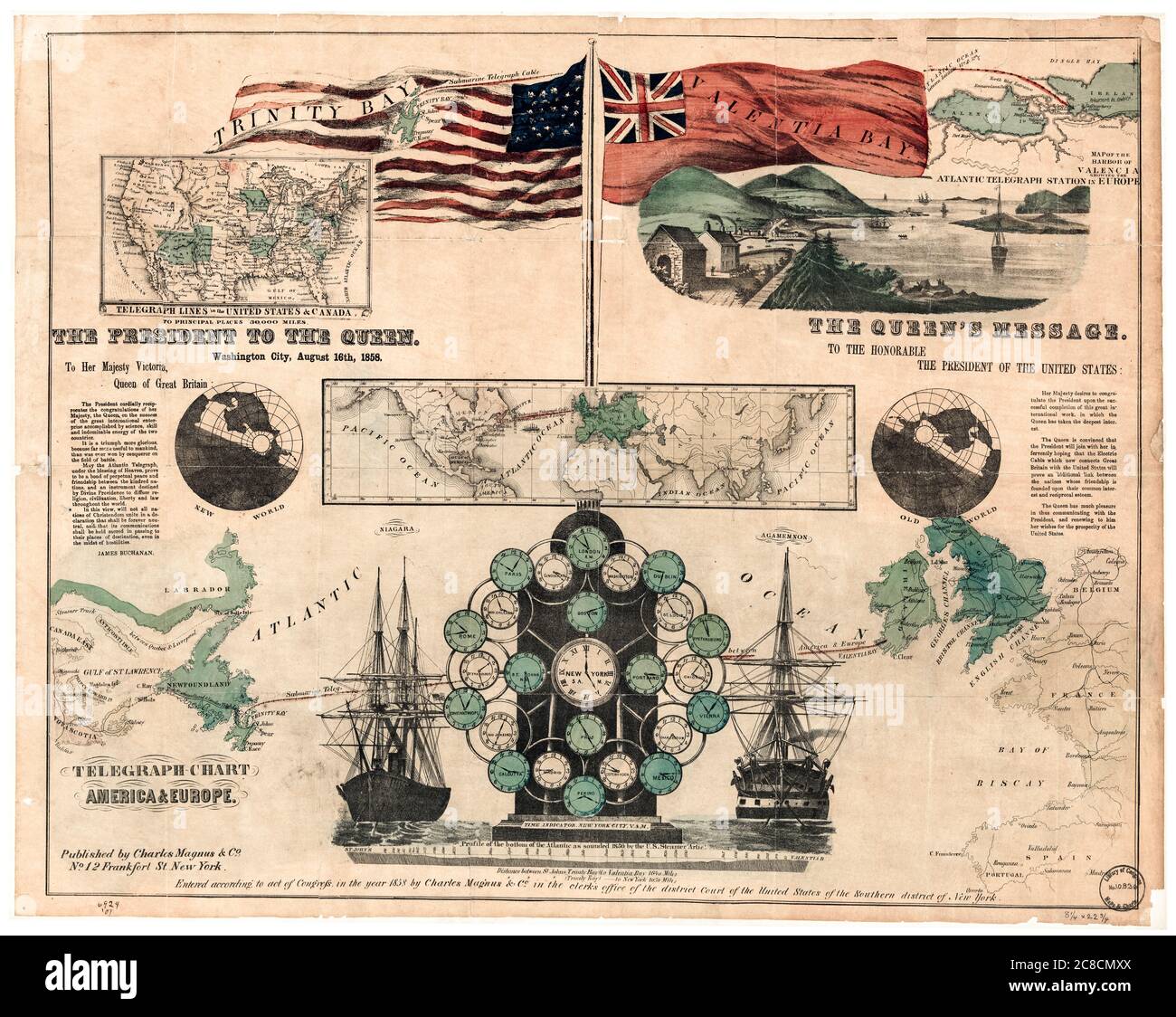 Vintage infographic showing the route of the first undersea Transatlantic Telegraph Cable across the Atlantic Ocean, by Charles Magnus & Co, August 16th 1858 Stock Photohttps://www.alamy.com/image-license-details/?v=1https://www.alamy.com/vintage-infographic-showing-the-route-of-the-first-undersea-transatlantic-telegraph-cable-across-the-atlantic-ocean-by-charles-magnus-co-august-16th-1858-image366614834.html
Vintage infographic showing the route of the first undersea Transatlantic Telegraph Cable across the Atlantic Ocean, by Charles Magnus & Co, August 16th 1858 Stock Photohttps://www.alamy.com/image-license-details/?v=1https://www.alamy.com/vintage-infographic-showing-the-route-of-the-first-undersea-transatlantic-telegraph-cable-across-the-atlantic-ocean-by-charles-magnus-co-august-16th-1858-image366614834.htmlRM2C8CMXX–Vintage infographic showing the route of the first undersea Transatlantic Telegraph Cable across the Atlantic Ocean, by Charles Magnus & Co, August 16th 1858
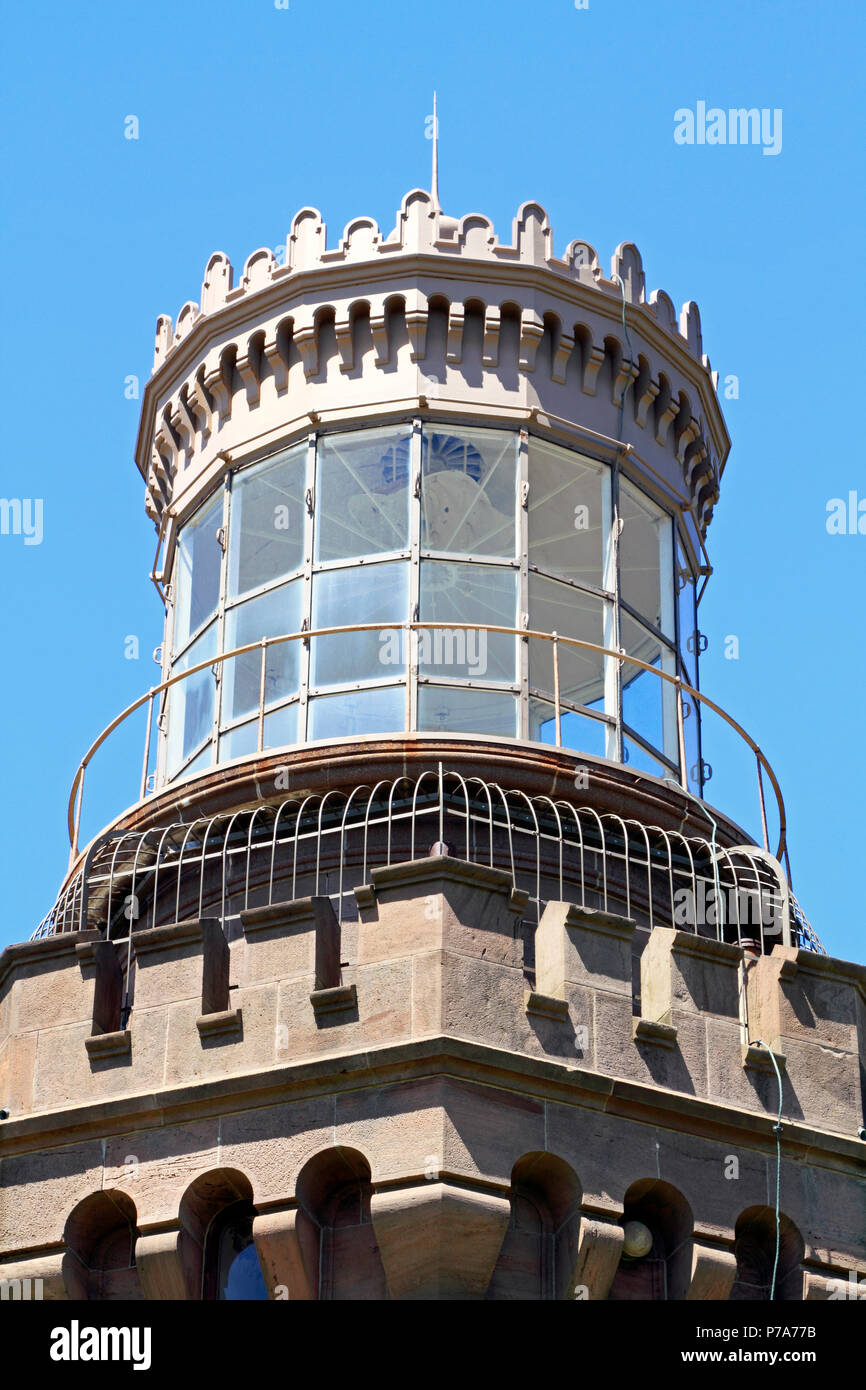 The Navesink Twin Lights lighthouse, Highlands, Monmouth County, New Jersey, USA Stock Photohttps://www.alamy.com/image-license-details/?v=1https://www.alamy.com/the-navesink-twin-lights-lighthouse-highlands-monmouth-county-new-jersey-usa-image211052223.html
The Navesink Twin Lights lighthouse, Highlands, Monmouth County, New Jersey, USA Stock Photohttps://www.alamy.com/image-license-details/?v=1https://www.alamy.com/the-navesink-twin-lights-lighthouse-highlands-monmouth-county-new-jersey-usa-image211052223.htmlRMP7A77B–The Navesink Twin Lights lighthouse, Highlands, Monmouth County, New Jersey, USA
 THE ATLANTIC TELEGRAPH MEETING OF THE NEW COMPANY., scientific american, 1866-04-14 Stock Photohttps://www.alamy.com/image-license-details/?v=1https://www.alamy.com/the-atlantic-telegraph-meeting-of-the-new-company-scientific-american-1866-04-14-image334307037.html
THE ATLANTIC TELEGRAPH MEETING OF THE NEW COMPANY., scientific american, 1866-04-14 Stock Photohttps://www.alamy.com/image-license-details/?v=1https://www.alamy.com/the-atlantic-telegraph-meeting-of-the-new-company-scientific-american-1866-04-14-image334307037.htmlRM2ABW011–THE ATLANTIC TELEGRAPH MEETING OF THE NEW COMPANY., scientific american, 1866-04-14
 Memorial to Sir Daniel Gooch 1st Baronet at Windsor Stock Photohttps://www.alamy.com/image-license-details/?v=1https://www.alamy.com/memorial-to-sir-daniel-gooch-1st-baronet-at-windsor-image264098067.html
Memorial to Sir Daniel Gooch 1st Baronet at Windsor Stock Photohttps://www.alamy.com/image-license-details/?v=1https://www.alamy.com/memorial-to-sir-daniel-gooch-1st-baronet-at-windsor-image264098067.htmlRMW9JKNR–Memorial to Sir Daniel Gooch 1st Baronet at Windsor
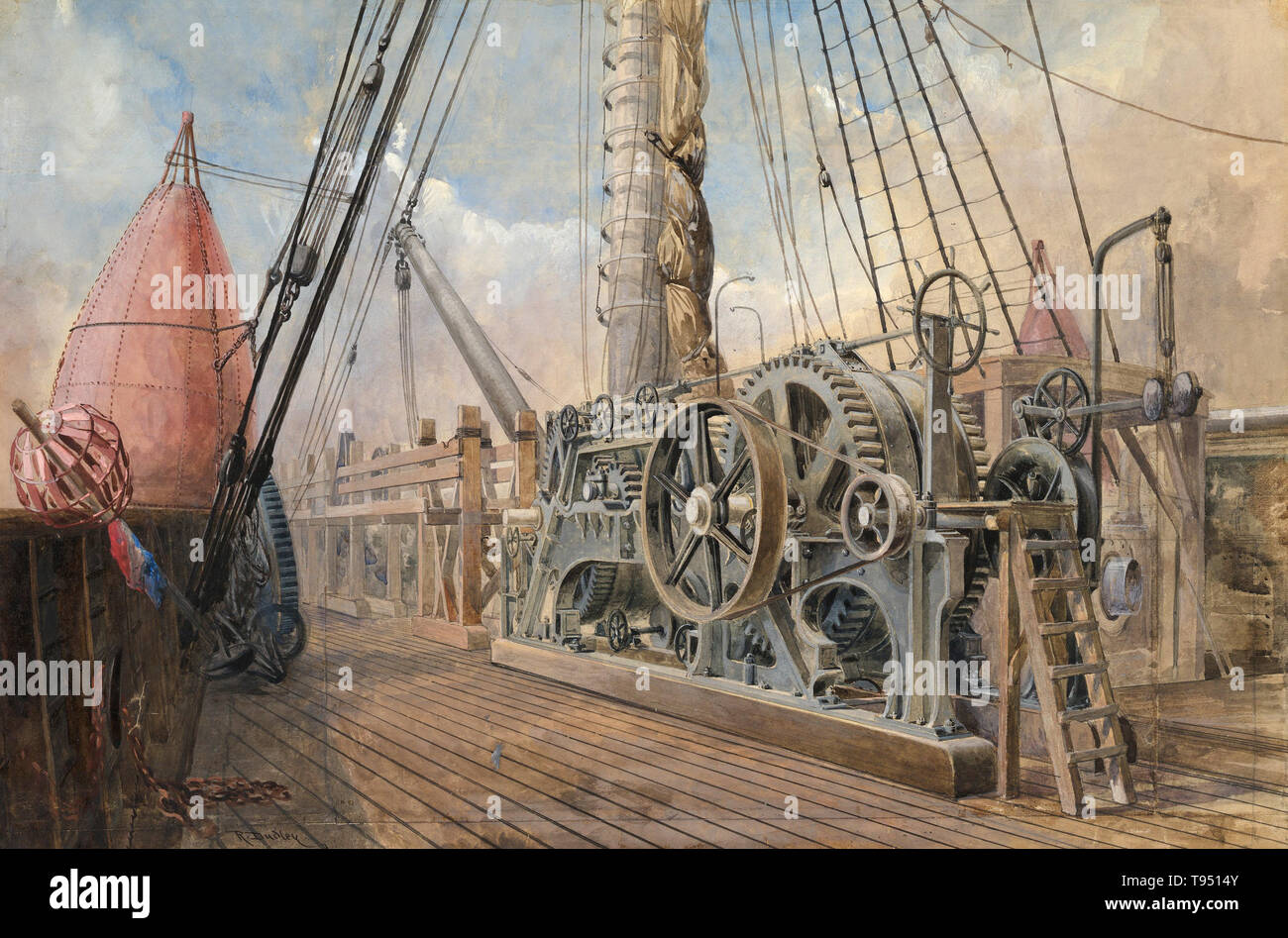 Deck of the Great Eastern, the Cable Trough, 1866, by Robert Charles Dudley (British, 1826-1909). One of the 19th century's great technological achievements was to lay a telegraphic cable beneath the Atlantic, allowing messages to speed back and forth between North America and Europe in minutes, rather than ten or twelve days by steamer. An initially successful attempt in 1858, led by Cyrus W. Field and financed by the Atlantic Telegraph Company, failed after three weeks. Stock Photohttps://www.alamy.com/image-license-details/?v=1https://www.alamy.com/deck-of-the-great-eastern-the-cable-trough-1866-by-robert-charles-dudley-british-1826-1909-one-of-the-19th-centurys-great-technological-achievements-was-to-lay-a-telegraphic-cable-beneath-the-atlantic-allowing-messages-to-speed-back-and-forth-between-north-america-and-europe-in-minutes-rather-than-ten-or-twelve-days-by-steamer-an-initially-successful-attempt-in-1858-led-by-cyrus-w-field-and-financed-by-the-atlantic-telegraph-company-failed-after-three-weeks-image246587739.html
Deck of the Great Eastern, the Cable Trough, 1866, by Robert Charles Dudley (British, 1826-1909). One of the 19th century's great technological achievements was to lay a telegraphic cable beneath the Atlantic, allowing messages to speed back and forth between North America and Europe in minutes, rather than ten or twelve days by steamer. An initially successful attempt in 1858, led by Cyrus W. Field and financed by the Atlantic Telegraph Company, failed after three weeks. Stock Photohttps://www.alamy.com/image-license-details/?v=1https://www.alamy.com/deck-of-the-great-eastern-the-cable-trough-1866-by-robert-charles-dudley-british-1826-1909-one-of-the-19th-centurys-great-technological-achievements-was-to-lay-a-telegraphic-cable-beneath-the-atlantic-allowing-messages-to-speed-back-and-forth-between-north-america-and-europe-in-minutes-rather-than-ten-or-twelve-days-by-steamer-an-initially-successful-attempt-in-1858-led-by-cyrus-w-field-and-financed-by-the-atlantic-telegraph-company-failed-after-three-weeks-image246587739.htmlRMT9514Y–Deck of the Great Eastern, the Cable Trough, 1866, by Robert Charles Dudley (British, 1826-1909). One of the 19th century's great technological achievements was to lay a telegraphic cable beneath the Atlantic, allowing messages to speed back and forth between North America and Europe in minutes, rather than ten or twelve days by steamer. An initially successful attempt in 1858, led by Cyrus W. Field and financed by the Atlantic Telegraph Company, failed after three weeks.
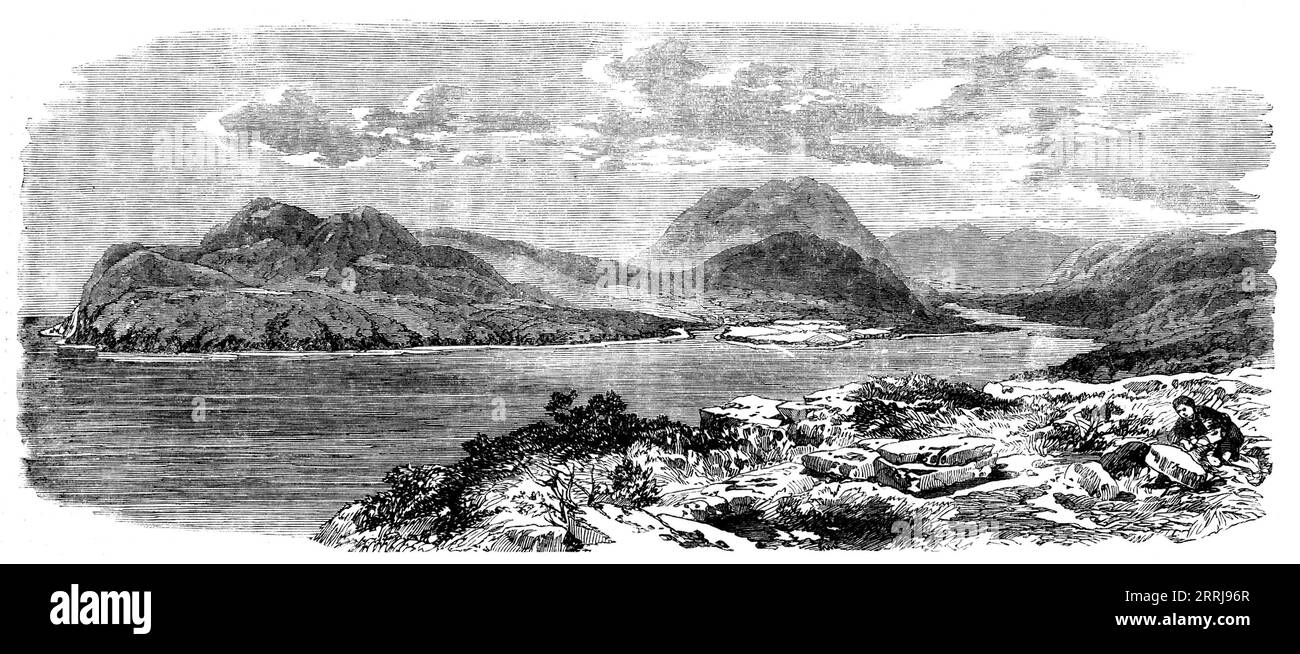 Laying the Atlantic Telegraph Cable - Valentia, the Landing-Place of the Atlantic Cable, 1858. 'View of Valentia, to which island considerable interest attaches in connection with the Atlantic Telegraph, as it is destined to receive the European end of the cable, being "the nearest parish to America." This island, about five miles long and two broad, is situated near the southwest of Ireland, a short distance south of Dingle Bay'. From "Illustrated London News", 1858. Stock Photohttps://www.alamy.com/image-license-details/?v=1https://www.alamy.com/laying-the-atlantic-telegraph-cable-valentia-the-landing-place-of-the-atlantic-cable-1858-view-of-valentia-to-which-island-considerable-interest-attaches-in-connection-with-the-atlantic-telegraph-as-it-is-destined-to-receive-the-european-end-of-the-cable-being-quotthe-nearest-parish-to-americaquot-this-island-about-five-miles-long-and-two-broad-is-situated-near-the-southwest-of-ireland-a-short-distance-south-of-dingle-bay-from-quotillustrated-london-newsquot-1858-image565271247.html
Laying the Atlantic Telegraph Cable - Valentia, the Landing-Place of the Atlantic Cable, 1858. 'View of Valentia, to which island considerable interest attaches in connection with the Atlantic Telegraph, as it is destined to receive the European end of the cable, being "the nearest parish to America." This island, about five miles long and two broad, is situated near the southwest of Ireland, a short distance south of Dingle Bay'. From "Illustrated London News", 1858. Stock Photohttps://www.alamy.com/image-license-details/?v=1https://www.alamy.com/laying-the-atlantic-telegraph-cable-valentia-the-landing-place-of-the-atlantic-cable-1858-view-of-valentia-to-which-island-considerable-interest-attaches-in-connection-with-the-atlantic-telegraph-as-it-is-destined-to-receive-the-european-end-of-the-cable-being-quotthe-nearest-parish-to-americaquot-this-island-about-five-miles-long-and-two-broad-is-situated-near-the-southwest-of-ireland-a-short-distance-south-of-dingle-bay-from-quotillustrated-london-newsquot-1858-image565271247.htmlRM2RRJ96R–Laying the Atlantic Telegraph Cable - Valentia, the Landing-Place of the Atlantic Cable, 1858. 'View of Valentia, to which island considerable interest attaches in connection with the Atlantic Telegraph, as it is destined to receive the European end of the cable, being "the nearest parish to America." This island, about five miles long and two broad, is situated near the southwest of Ireland, a short distance south of Dingle Bay'. From "Illustrated London News", 1858.
 H.M.S. Agamemnon Laying the Atlantic Telegraph Cable in 1858: a Whale Crosses the Line, 1865-66. Stock Photohttps://www.alamy.com/image-license-details/?v=1https://www.alamy.com/hms-agamemnon-laying-the-atlantic-telegraph-cable-in-1858-a-whale-crosses-the-line-1865-66-image365762950.html
H.M.S. Agamemnon Laying the Atlantic Telegraph Cable in 1858: a Whale Crosses the Line, 1865-66. Stock Photohttps://www.alamy.com/image-license-details/?v=1https://www.alamy.com/hms-agamemnon-laying-the-atlantic-telegraph-cable-in-1858-a-whale-crosses-the-line-1865-66-image365762950.htmlRM2C71XAE–H.M.S. Agamemnon Laying the Atlantic Telegraph Cable in 1858: a Whale Crosses the Line, 1865-66.
 Getting Out One of the Large Buoys for Launching, August 2nd, 1865. Artist: Robert Charles Dudley (British, 1826-1909). Dimensions: Sheet: 7 5/16 × 10 3/8 in. (18.6 × 26.3 cm). Date: 1865. One of the 19th century's great technological achievements was to lay a telegraphic cable beneath the Atlantic, allowing messages to speed back and forth between North America and Europe in minutes, rather than ten or twelve days by steamer. An initially successful attempt in 1858, led by Cyrus W. Field and financed by the Atlantic Telegraph Company, failed after three weeks. Two working cables were finally Stock Photohttps://www.alamy.com/image-license-details/?v=1https://www.alamy.com/getting-out-one-of-the-large-buoys-for-launching-august-2nd-1865-artist-robert-charles-dudley-british-1826-1909-dimensions-sheet-7-516-10-38-in-186-263-cm-date-1865-one-of-the-19th-centurys-great-technological-achievements-was-to-lay-a-telegraphic-cable-beneath-the-atlantic-allowing-messages-to-speed-back-and-forth-between-north-america-and-europe-in-minutes-rather-than-ten-or-twelve-days-by-steamer-an-initially-successful-attempt-in-1858-led-by-cyrus-w-field-and-financed-by-the-atlantic-telegraph-company-failed-after-three-weeks-two-working-cables-were-finally-image213109298.html
Getting Out One of the Large Buoys for Launching, August 2nd, 1865. Artist: Robert Charles Dudley (British, 1826-1909). Dimensions: Sheet: 7 5/16 × 10 3/8 in. (18.6 × 26.3 cm). Date: 1865. One of the 19th century's great technological achievements was to lay a telegraphic cable beneath the Atlantic, allowing messages to speed back and forth between North America and Europe in minutes, rather than ten or twelve days by steamer. An initially successful attempt in 1858, led by Cyrus W. Field and financed by the Atlantic Telegraph Company, failed after three weeks. Two working cables were finally Stock Photohttps://www.alamy.com/image-license-details/?v=1https://www.alamy.com/getting-out-one-of-the-large-buoys-for-launching-august-2nd-1865-artist-robert-charles-dudley-british-1826-1909-dimensions-sheet-7-516-10-38-in-186-263-cm-date-1865-one-of-the-19th-centurys-great-technological-achievements-was-to-lay-a-telegraphic-cable-beneath-the-atlantic-allowing-messages-to-speed-back-and-forth-between-north-america-and-europe-in-minutes-rather-than-ten-or-twelve-days-by-steamer-an-initially-successful-attempt-in-1858-led-by-cyrus-w-field-and-financed-by-the-atlantic-telegraph-company-failed-after-three-weeks-two-working-cables-were-finally-image213109298.htmlRMPAKY2A–Getting Out One of the Large Buoys for Launching, August 2nd, 1865. Artist: Robert Charles Dudley (British, 1826-1909). Dimensions: Sheet: 7 5/16 × 10 3/8 in. (18.6 × 26.3 cm). Date: 1865. One of the 19th century's great technological achievements was to lay a telegraphic cable beneath the Atlantic, allowing messages to speed back and forth between North America and Europe in minutes, rather than ten or twelve days by steamer. An initially successful attempt in 1858, led by Cyrus W. Field and financed by the Atlantic Telegraph Company, failed after three weeks. Two working cables were finally
 Memorial Plaque to Sir Daniel Gooch 1st Baronet railway & transatlantic cable engineer, Conservative MP 1816 - 1889 Stock Photohttps://www.alamy.com/image-license-details/?v=1https://www.alamy.com/stock-photo-memorial-plaque-to-sir-daniel-gooch-1st-baronet-railway-transatlantic-72676939.html
Memorial Plaque to Sir Daniel Gooch 1st Baronet railway & transatlantic cable engineer, Conservative MP 1816 - 1889 Stock Photohttps://www.alamy.com/image-license-details/?v=1https://www.alamy.com/stock-photo-memorial-plaque-to-sir-daniel-gooch-1st-baronet-railway-transatlantic-72676939.htmlRME66M4Y–Memorial Plaque to Sir Daniel Gooch 1st Baronet railway & transatlantic cable engineer, Conservative MP 1816 - 1889
 Christian herald and signs of our times . he could borrow. Promotioncame to him rapidly, especially during the warwhen the qualities of patient endurance of hard-ship, courage and presence of mind in suddenemergencies which have always distinguishedhim were of special value. At the age of twentyhe was one of the most valued employeesof the Western Union Company. At that time (1865) the project was entertain- ed of a telegraph line from this country to Eu-rope by way of Alaska, Behring Sea and Siber-ia. The first Atlantic Cable had failed, andthere was a general impression that the onlypractica Stock Photohttps://www.alamy.com/image-license-details/?v=1https://www.alamy.com/christian-herald-and-signs-of-our-times-he-could-borrow-promotioncame-to-him-rapidly-especially-during-the-warwhen-the-qualities-of-patient-endurance-of-hard-ship-courage-and-presence-of-mind-in-suddenemergencies-which-have-always-distinguishedhim-were-of-special-value-at-the-age-of-twentyhe-was-one-of-the-most-valued-employeesof-the-western-union-company-at-that-time-1865-the-project-was-entertain-ed-of-a-telegraph-line-from-this-country-to-eu-rope-by-way-of-alaska-behring-sea-and-siber-ia-the-first-atlantic-cable-had-failed-andthere-was-a-general-impression-that-the-onlypractica-image343081627.html
Christian herald and signs of our times . he could borrow. Promotioncame to him rapidly, especially during the warwhen the qualities of patient endurance of hard-ship, courage and presence of mind in suddenemergencies which have always distinguishedhim were of special value. At the age of twentyhe was one of the most valued employeesof the Western Union Company. At that time (1865) the project was entertain- ed of a telegraph line from this country to Eu-rope by way of Alaska, Behring Sea and Siber-ia. The first Atlantic Cable had failed, andthere was a general impression that the onlypractica Stock Photohttps://www.alamy.com/image-license-details/?v=1https://www.alamy.com/christian-herald-and-signs-of-our-times-he-could-borrow-promotioncame-to-him-rapidly-especially-during-the-warwhen-the-qualities-of-patient-endurance-of-hard-ship-courage-and-presence-of-mind-in-suddenemergencies-which-have-always-distinguishedhim-were-of-special-value-at-the-age-of-twentyhe-was-one-of-the-most-valued-employeesof-the-western-union-company-at-that-time-1865-the-project-was-entertain-ed-of-a-telegraph-line-from-this-country-to-eu-rope-by-way-of-alaska-behring-sea-and-siber-ia-the-first-atlantic-cable-had-failed-andthere-was-a-general-impression-that-the-onlypractica-image343081627.htmlRM2AX4M37–Christian herald and signs of our times . he could borrow. Promotioncame to him rapidly, especially during the warwhen the qualities of patient endurance of hard-ship, courage and presence of mind in suddenemergencies which have always distinguishedhim were of special value. At the age of twentyhe was one of the most valued employeesof the Western Union Company. At that time (1865) the project was entertain- ed of a telegraph line from this country to Eu-rope by way of Alaska, Behring Sea and Siber-ia. The first Atlantic Cable had failed, andthere was a general impression that the onlypractica
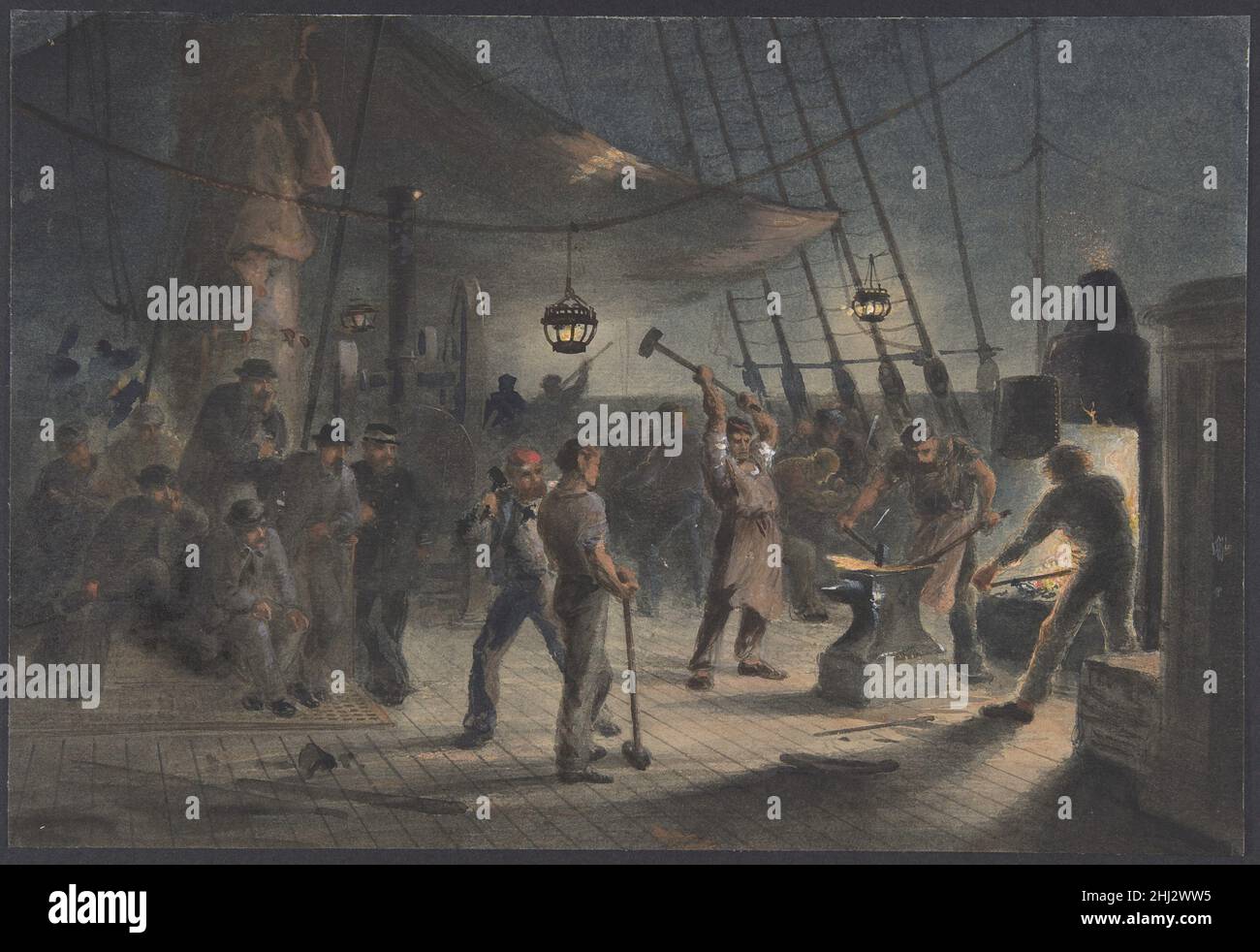 The Forge on Deck, Night of August 9th: Preparing the Iron Plating for Capstan 1865–66 Robert Charles Dudley British One of the 19th century's great technological achievements was to lay a telegraphic cable beneath the Atlantic, allowing messages to speed back and forth between North America and Europe in minutes, rather than ten or twelve days by steamer. An initially successful attempt in 1858, led by Cyrus W. Field and financed by the Atlantic Telegraph Company, failed after three weeks. Two working cables were finally laid in July and September 1866, the result of repeated efforts by the i Stock Photohttps://www.alamy.com/image-license-details/?v=1https://www.alamy.com/the-forge-on-deck-night-of-august-9th-preparing-the-iron-plating-for-capstan-186566-robert-charles-dudley-british-one-of-the-19th-centurys-great-technological-achievements-was-to-lay-a-telegraphic-cable-beneath-the-atlantic-allowing-messages-to-speed-back-and-forth-between-north-america-and-europe-in-minutes-rather-than-ten-or-twelve-days-by-steamer-an-initially-successful-attempt-in-1858-led-by-cyrus-w-field-and-financed-by-the-atlantic-telegraph-company-failed-after-three-weeks-two-working-cables-were-finally-laid-in-july-and-september-1866-the-result-of-repeated-efforts-by-the-i-image458597585.html
The Forge on Deck, Night of August 9th: Preparing the Iron Plating for Capstan 1865–66 Robert Charles Dudley British One of the 19th century's great technological achievements was to lay a telegraphic cable beneath the Atlantic, allowing messages to speed back and forth between North America and Europe in minutes, rather than ten or twelve days by steamer. An initially successful attempt in 1858, led by Cyrus W. Field and financed by the Atlantic Telegraph Company, failed after three weeks. Two working cables were finally laid in July and September 1866, the result of repeated efforts by the i Stock Photohttps://www.alamy.com/image-license-details/?v=1https://www.alamy.com/the-forge-on-deck-night-of-august-9th-preparing-the-iron-plating-for-capstan-186566-robert-charles-dudley-british-one-of-the-19th-centurys-great-technological-achievements-was-to-lay-a-telegraphic-cable-beneath-the-atlantic-allowing-messages-to-speed-back-and-forth-between-north-america-and-europe-in-minutes-rather-than-ten-or-twelve-days-by-steamer-an-initially-successful-attempt-in-1858-led-by-cyrus-w-field-and-financed-by-the-atlantic-telegraph-company-failed-after-three-weeks-two-working-cables-were-finally-laid-in-july-and-september-1866-the-result-of-repeated-efforts-by-the-i-image458597585.htmlRM2HJ2WW5–The Forge on Deck, Night of August 9th: Preparing the Iron Plating for Capstan 1865–66 Robert Charles Dudley British One of the 19th century's great technological achievements was to lay a telegraphic cable beneath the Atlantic, allowing messages to speed back and forth between North America and Europe in minutes, rather than ten or twelve days by steamer. An initially successful attempt in 1858, led by Cyrus W. Field and financed by the Atlantic Telegraph Company, failed after three weeks. Two working cables were finally laid in July and September 1866, the result of repeated efforts by the i
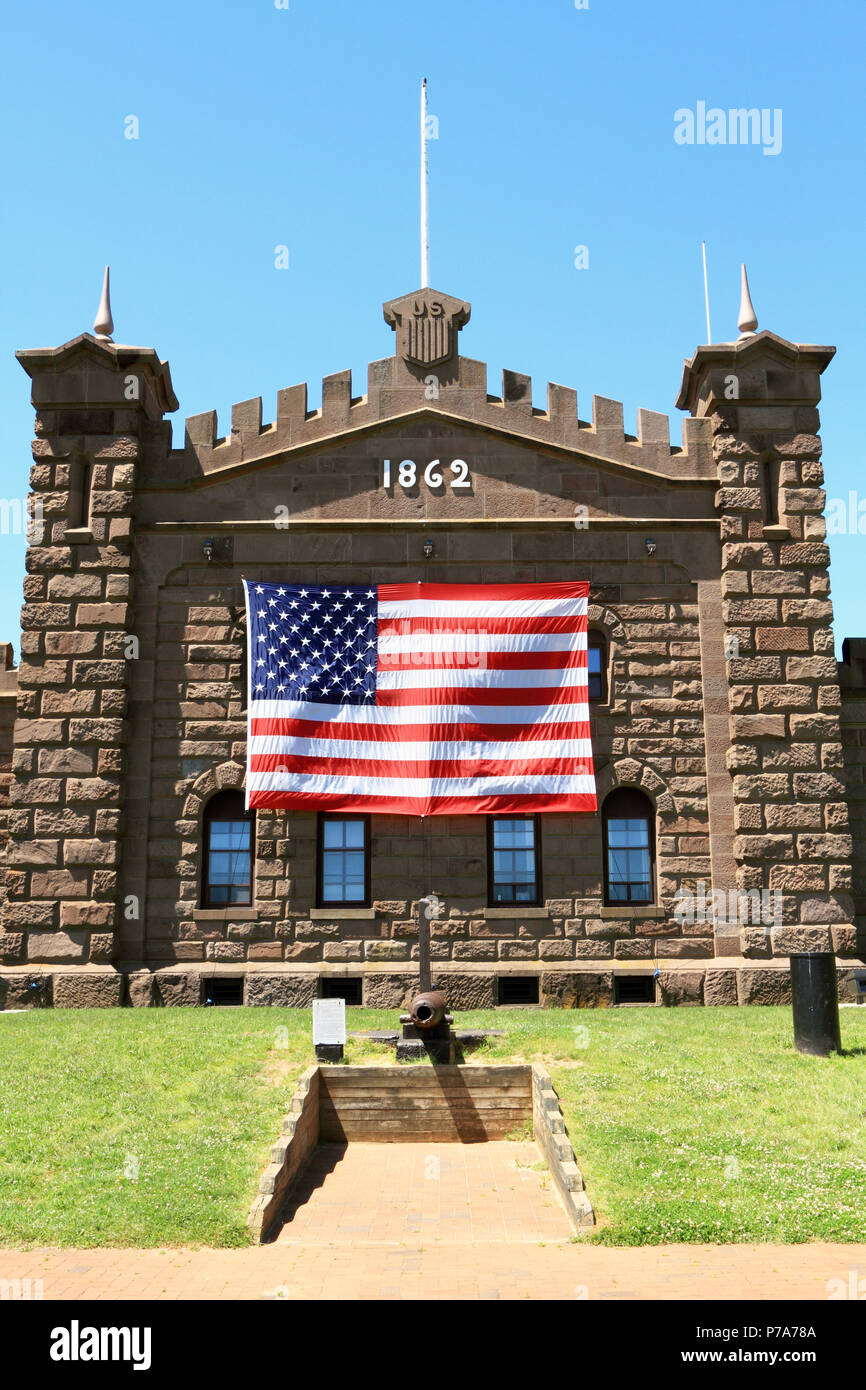 The Navesink Twin Lights lighthouse, Highlands, Monmouth County, New Jersey, USA Stock Photohttps://www.alamy.com/image-license-details/?v=1https://www.alamy.com/the-navesink-twin-lights-lighthouse-highlands-monmouth-county-new-jersey-usa-image211052250.html
The Navesink Twin Lights lighthouse, Highlands, Monmouth County, New Jersey, USA Stock Photohttps://www.alamy.com/image-license-details/?v=1https://www.alamy.com/the-navesink-twin-lights-lighthouse-highlands-monmouth-county-new-jersey-usa-image211052250.htmlRMP7A78A–The Navesink Twin Lights lighthouse, Highlands, Monmouth County, New Jersey, USA
 Zrientitir lmerican THE ADVOCATE OF INDUSTRY AND JOURNAL OF SCIENTIFIC MECHANICAL AND OTHER IMPROVEMENTS. SCIENTIFIC AMERICAN: By Munn & Company. TERMS-42 a year--$1 in advance and the remainder in 6 months. RAIL ROAD NEWS. The Paths of Life. True Politeness. An Antique. Opposition to the Telegraph. Atlantic and Pacific Railroad. Quebec Railroad. Champlain Railroad. TEIE MIDNIGHT WIND. THE STAR OF LOVE., 1848-04-08 Stock Photohttps://www.alamy.com/image-license-details/?v=1https://www.alamy.com/zrientitir-lmerican-the-advocate-of-industry-and-journal-of-scientific-mechanical-and-other-improvements-scientific-american-by-munn-company-terms-42-a-year-1-in-advance-and-the-remainder-in-6-months-rail-road-news-the-paths-of-life-true-politeness-an-antique-opposition-to-the-telegraph-atlantic-and-pacific-railroad-quebec-railroad-champlain-railroad-teie-midnight-wind-the-star-of-love-1848-04-08-image334295849.html
Zrientitir lmerican THE ADVOCATE OF INDUSTRY AND JOURNAL OF SCIENTIFIC MECHANICAL AND OTHER IMPROVEMENTS. SCIENTIFIC AMERICAN: By Munn & Company. TERMS-42 a year--$1 in advance and the remainder in 6 months. RAIL ROAD NEWS. The Paths of Life. True Politeness. An Antique. Opposition to the Telegraph. Atlantic and Pacific Railroad. Quebec Railroad. Champlain Railroad. TEIE MIDNIGHT WIND. THE STAR OF LOVE., 1848-04-08 Stock Photohttps://www.alamy.com/image-license-details/?v=1https://www.alamy.com/zrientitir-lmerican-the-advocate-of-industry-and-journal-of-scientific-mechanical-and-other-improvements-scientific-american-by-munn-company-terms-42-a-year-1-in-advance-and-the-remainder-in-6-months-rail-road-news-the-paths-of-life-true-politeness-an-antique-opposition-to-the-telegraph-atlantic-and-pacific-railroad-quebec-railroad-champlain-railroad-teie-midnight-wind-the-star-of-love-1848-04-08-image334295849.htmlRM2ABTDND–Zrientitir lmerican THE ADVOCATE OF INDUSTRY AND JOURNAL OF SCIENTIFIC MECHANICAL AND OTHER IMPROVEMENTS. SCIENTIFIC AMERICAN: By Munn & Company. TERMS-42 a year--$1 in advance and the remainder in 6 months. RAIL ROAD NEWS. The Paths of Life. True Politeness. An Antique. Opposition to the Telegraph. Atlantic and Pacific Railroad. Quebec Railroad. Champlain Railroad. TEIE MIDNIGHT WIND. THE STAR OF LOVE., 1848-04-08
 Deck of Great Eastern, Aft: the Paying-out Machinery (1866) by Robert Charles Dudley (British, 1826-1909). One of the 19th century's great technological achievements was to lay a telegraphic cable beneath the Atlantic, allowing messages to speed back and forth between North America and Europe in minutes, rather than ten or twelve days by steamer. An initially successful attempt in 1858, led by Cyrus W. Field and financed by the Atlantic Telegraph Company, failed after three weeks. Stock Photohttps://www.alamy.com/image-license-details/?v=1https://www.alamy.com/deck-of-great-eastern-aft-the-paying-out-machinery-1866-by-robert-charles-dudley-british-1826-1909-one-of-the-19th-centurys-great-technological-achievements-was-to-lay-a-telegraphic-cable-beneath-the-atlantic-allowing-messages-to-speed-back-and-forth-between-north-america-and-europe-in-minutes-rather-than-ten-or-twelve-days-by-steamer-an-initially-successful-attempt-in-1858-led-by-cyrus-w-field-and-financed-by-the-atlantic-telegraph-company-failed-after-three-weeks-image246587693.html
Deck of Great Eastern, Aft: the Paying-out Machinery (1866) by Robert Charles Dudley (British, 1826-1909). One of the 19th century's great technological achievements was to lay a telegraphic cable beneath the Atlantic, allowing messages to speed back and forth between North America and Europe in minutes, rather than ten or twelve days by steamer. An initially successful attempt in 1858, led by Cyrus W. Field and financed by the Atlantic Telegraph Company, failed after three weeks. Stock Photohttps://www.alamy.com/image-license-details/?v=1https://www.alamy.com/deck-of-great-eastern-aft-the-paying-out-machinery-1866-by-robert-charles-dudley-british-1826-1909-one-of-the-19th-centurys-great-technological-achievements-was-to-lay-a-telegraphic-cable-beneath-the-atlantic-allowing-messages-to-speed-back-and-forth-between-north-america-and-europe-in-minutes-rather-than-ten-or-twelve-days-by-steamer-an-initially-successful-attempt-in-1858-led-by-cyrus-w-field-and-financed-by-the-atlantic-telegraph-company-failed-after-three-weeks-image246587693.htmlRMT95139–Deck of Great Eastern, Aft: the Paying-out Machinery (1866) by Robert Charles Dudley (British, 1826-1909). One of the 19th century's great technological achievements was to lay a telegraphic cable beneath the Atlantic, allowing messages to speed back and forth between North America and Europe in minutes, rather than ten or twelve days by steamer. An initially successful attempt in 1858, led by Cyrus W. Field and financed by the Atlantic Telegraph Company, failed after three weeks.
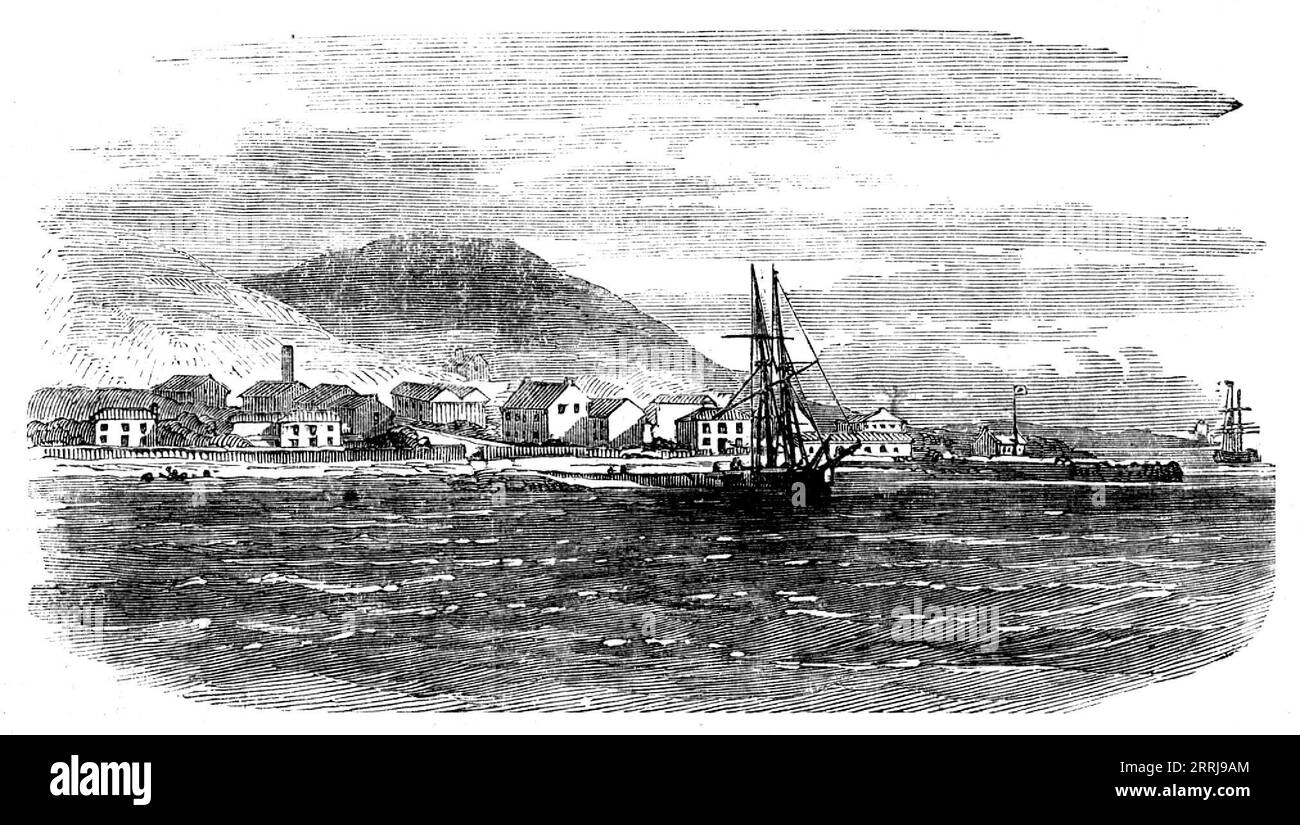 Laying the Atlantic Telegraph Cable - Valentia, from the North, 1858. 'View of Valentia, to which island considerable interest attaches in connection with the Atlantic Telegraph, as it is destined to receive the European end of the cable, being "the nearest parish to America." This island, about five miles long and two broad, is situated near the southwest of Ireland, a short distance south of Dingle Bay'. From "Illustrated London News", 1858. Stock Photohttps://www.alamy.com/image-license-details/?v=1https://www.alamy.com/laying-the-atlantic-telegraph-cable-valentia-from-the-north-1858-view-of-valentia-to-which-island-considerable-interest-attaches-in-connection-with-the-atlantic-telegraph-as-it-is-destined-to-receive-the-european-end-of-the-cable-being-quotthe-nearest-parish-to-americaquot-this-island-about-five-miles-long-and-two-broad-is-situated-near-the-southwest-of-ireland-a-short-distance-south-of-dingle-bay-from-quotillustrated-london-newsquot-1858-image565271356.html
Laying the Atlantic Telegraph Cable - Valentia, from the North, 1858. 'View of Valentia, to which island considerable interest attaches in connection with the Atlantic Telegraph, as it is destined to receive the European end of the cable, being "the nearest parish to America." This island, about five miles long and two broad, is situated near the southwest of Ireland, a short distance south of Dingle Bay'. From "Illustrated London News", 1858. Stock Photohttps://www.alamy.com/image-license-details/?v=1https://www.alamy.com/laying-the-atlantic-telegraph-cable-valentia-from-the-north-1858-view-of-valentia-to-which-island-considerable-interest-attaches-in-connection-with-the-atlantic-telegraph-as-it-is-destined-to-receive-the-european-end-of-the-cable-being-quotthe-nearest-parish-to-americaquot-this-island-about-five-miles-long-and-two-broad-is-situated-near-the-southwest-of-ireland-a-short-distance-south-of-dingle-bay-from-quotillustrated-london-newsquot-1858-image565271356.htmlRM2RRJ9AM–Laying the Atlantic Telegraph Cable - Valentia, from the North, 1858. 'View of Valentia, to which island considerable interest attaches in connection with the Atlantic Telegraph, as it is destined to receive the European end of the cable, being "the nearest parish to America." This island, about five miles long and two broad, is situated near the southwest of Ireland, a short distance south of Dingle Bay'. From "Illustrated London News", 1858.
 The Reels of Gutta-percha Covered Conducting Wire Conveyed into Tanks at the Works of the Telegraph Construction and Maintenance Company, at Greenwich, 1865-66. Stock Photohttps://www.alamy.com/image-license-details/?v=1https://www.alamy.com/the-reels-of-gutta-percha-covered-conducting-wire-conveyed-into-tanks-at-the-works-of-the-telegraph-construction-and-maintenance-company-at-greenwich-1865-66-image365762944.html
The Reels of Gutta-percha Covered Conducting Wire Conveyed into Tanks at the Works of the Telegraph Construction and Maintenance Company, at Greenwich, 1865-66. Stock Photohttps://www.alamy.com/image-license-details/?v=1https://www.alamy.com/the-reels-of-gutta-percha-covered-conducting-wire-conveyed-into-tanks-at-the-works-of-the-telegraph-construction-and-maintenance-company-at-greenwich-1865-66-image365762944.htmlRM2C71XA8–The Reels of Gutta-percha Covered Conducting Wire Conveyed into Tanks at the Works of the Telegraph Construction and Maintenance Company, at Greenwich, 1865-66.